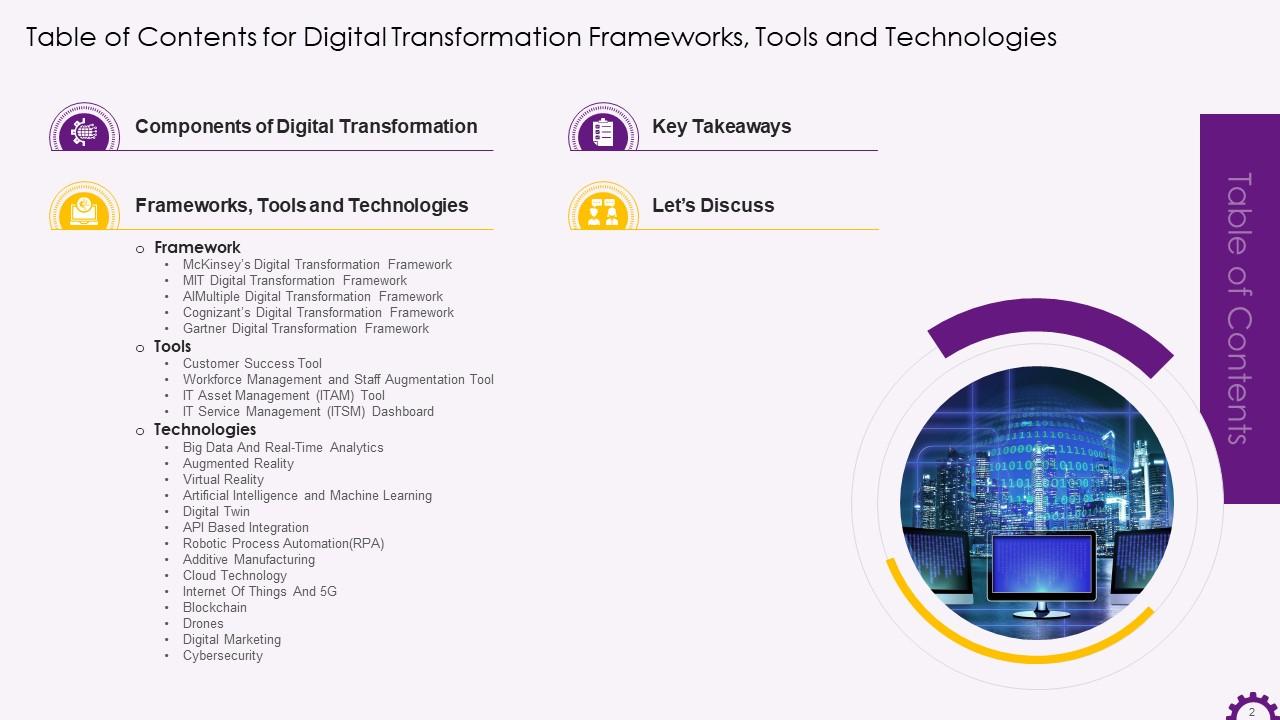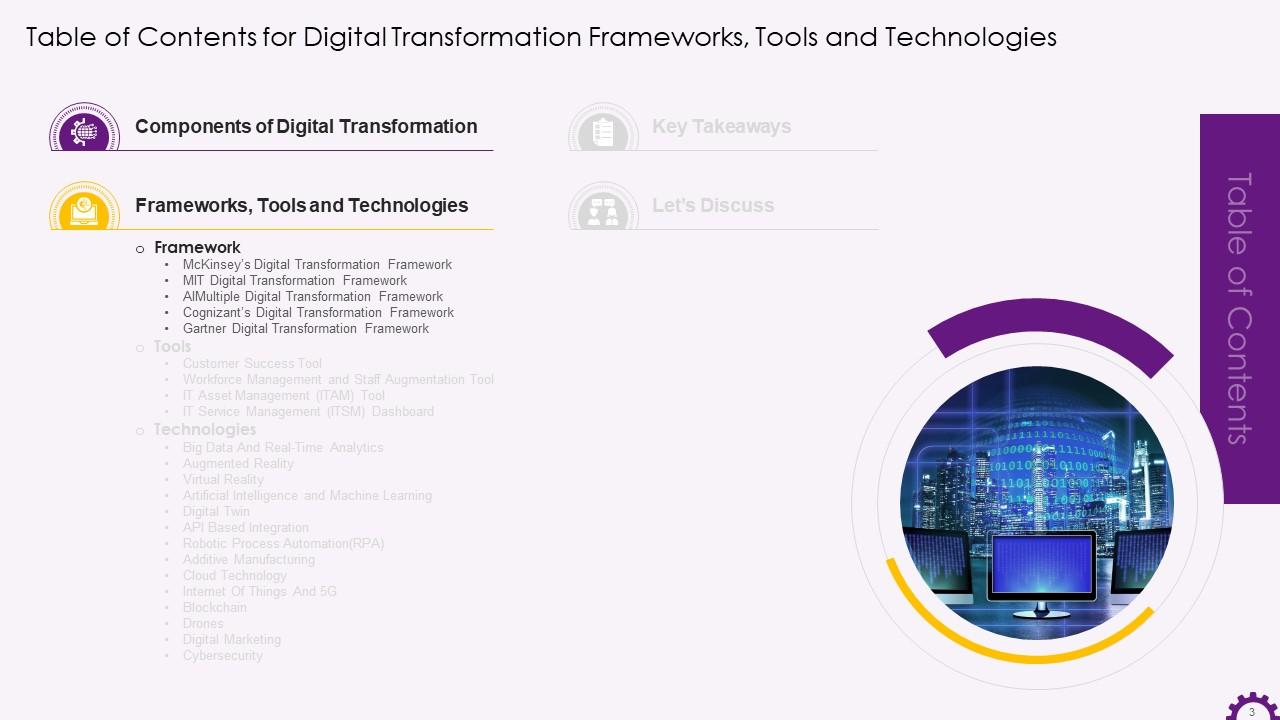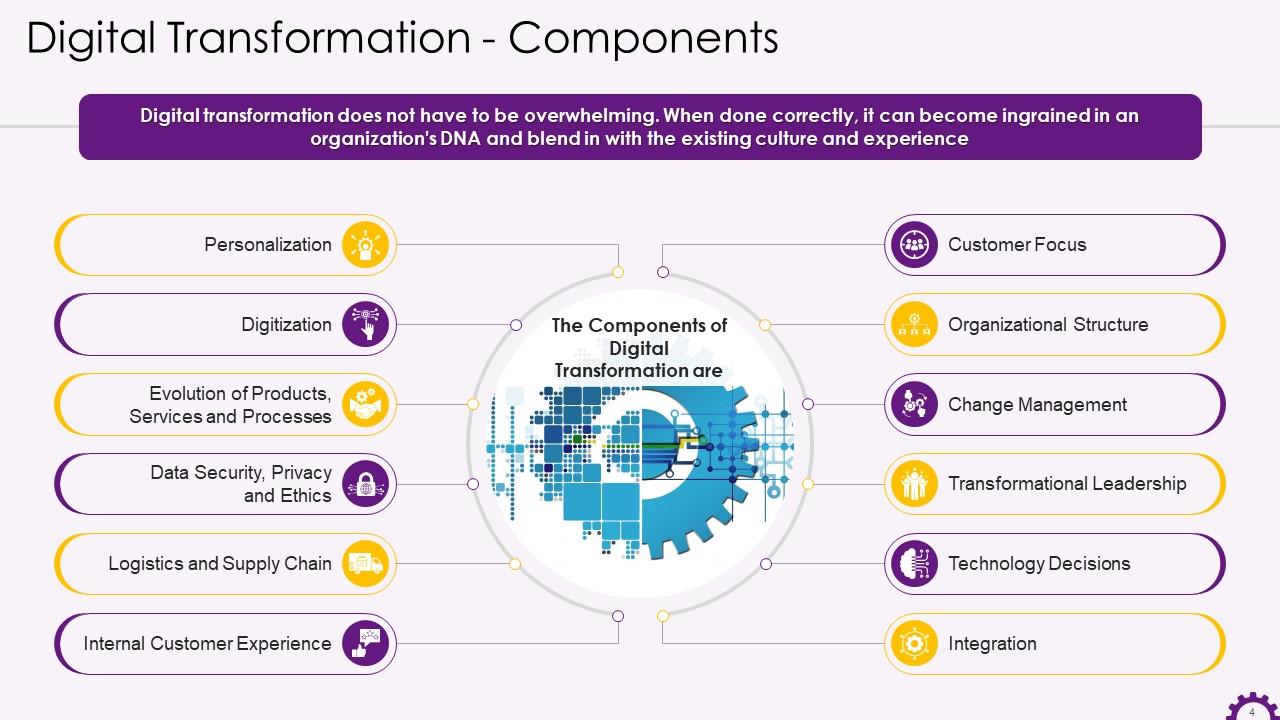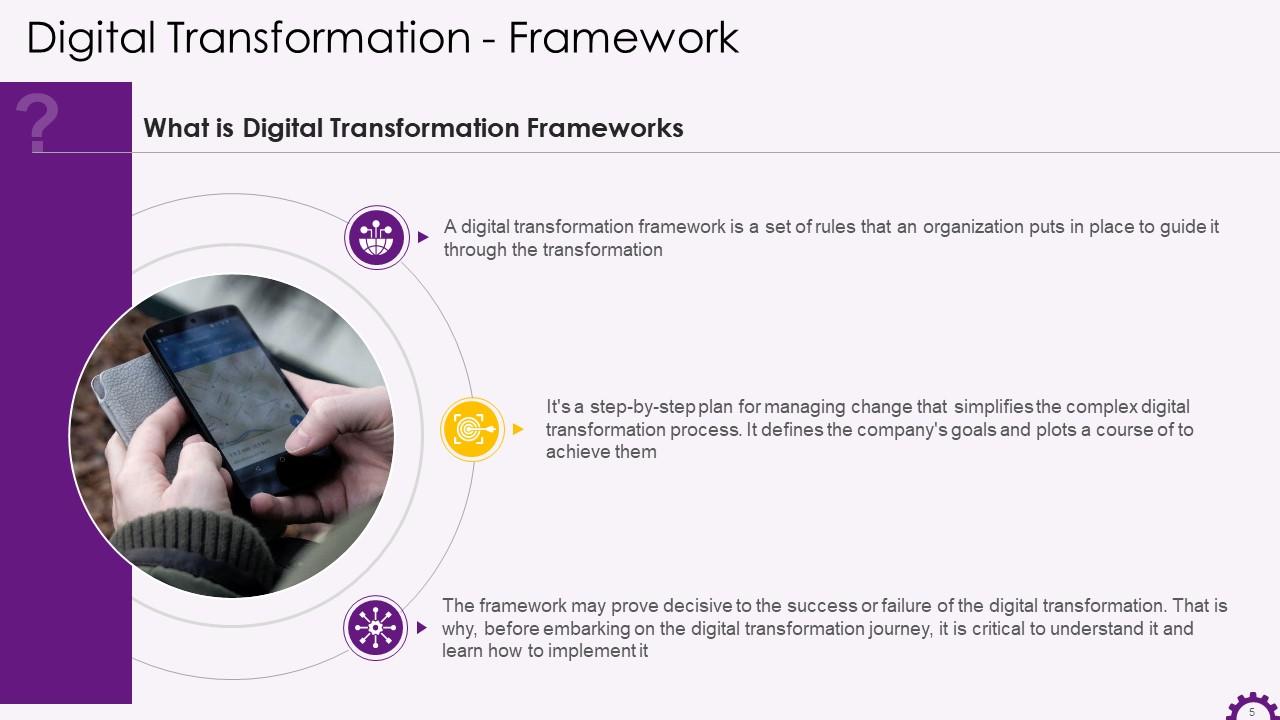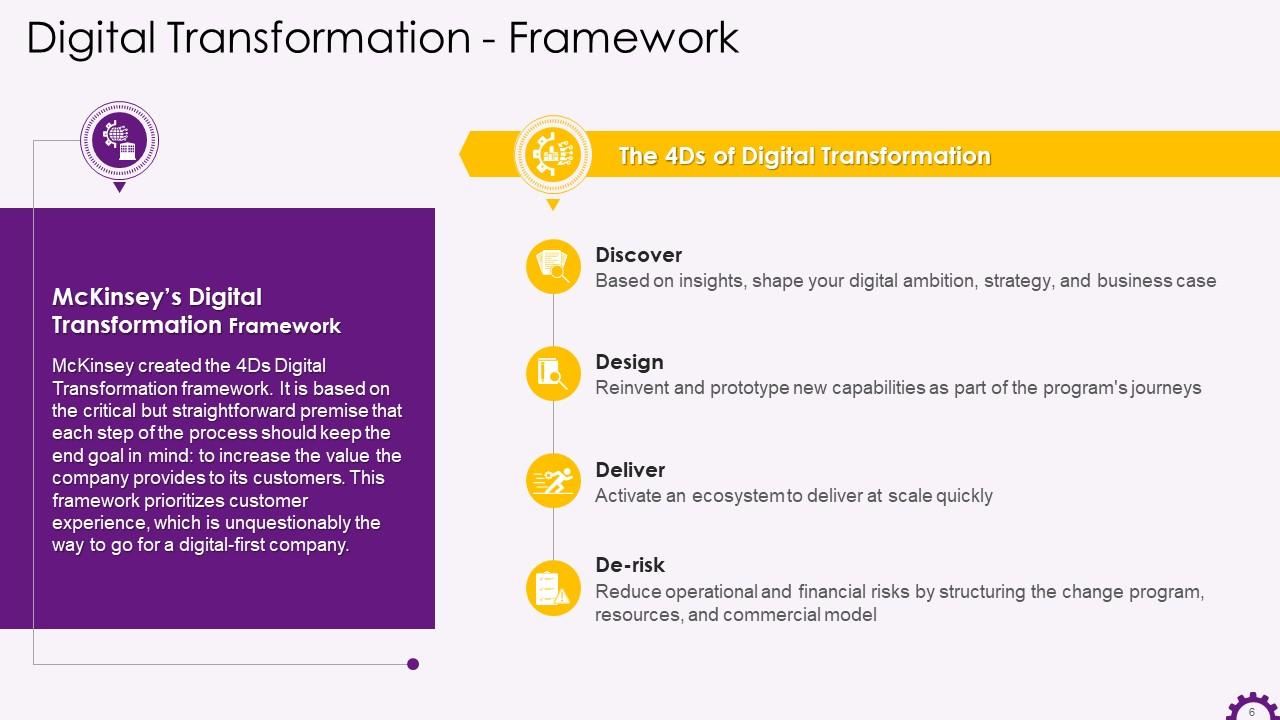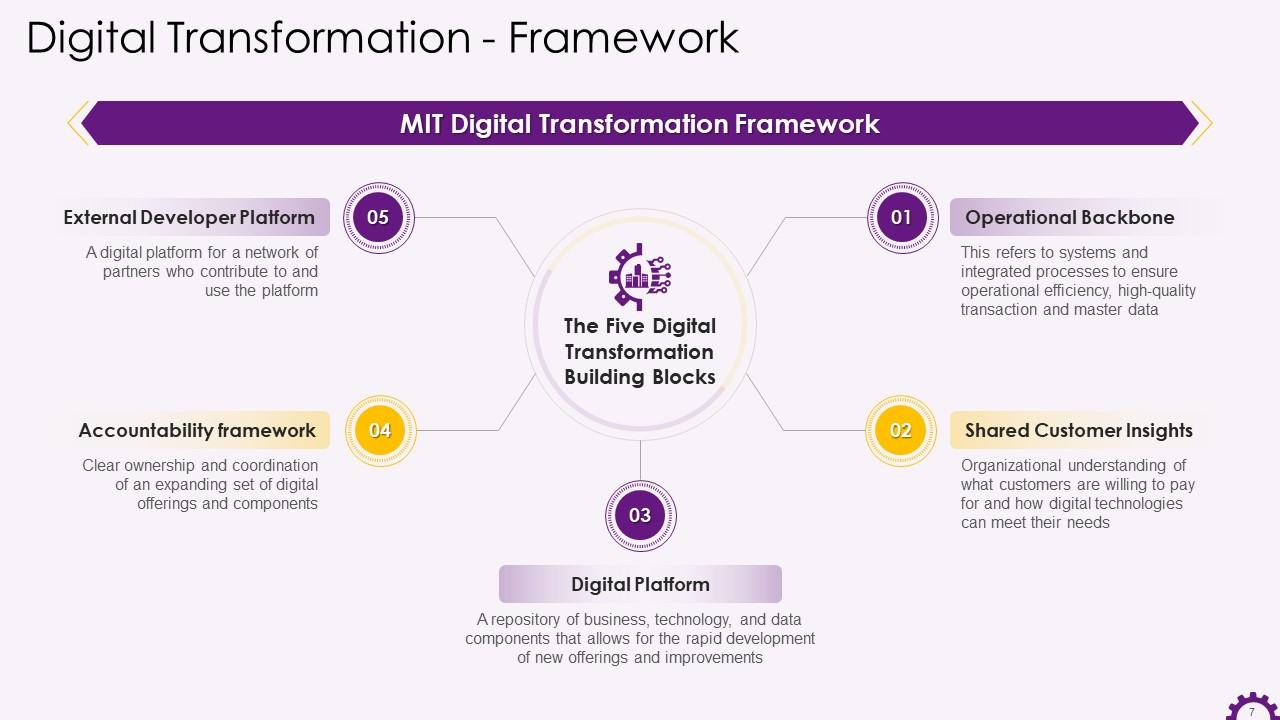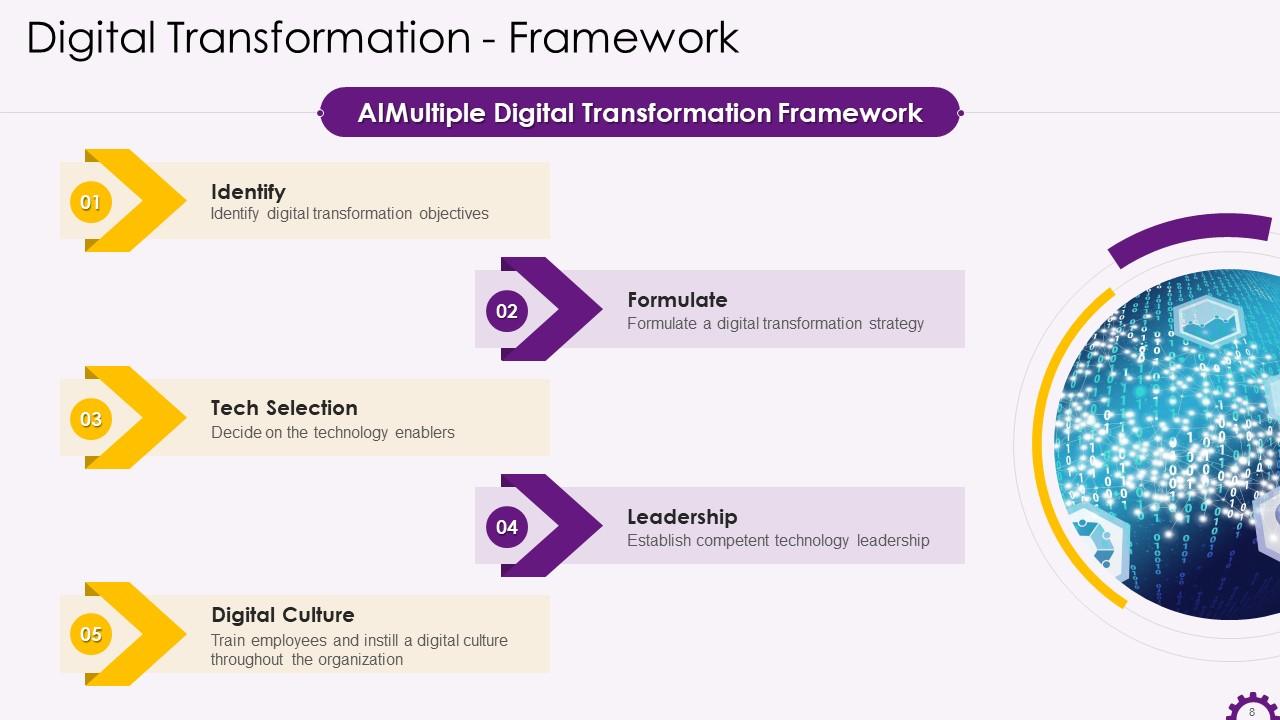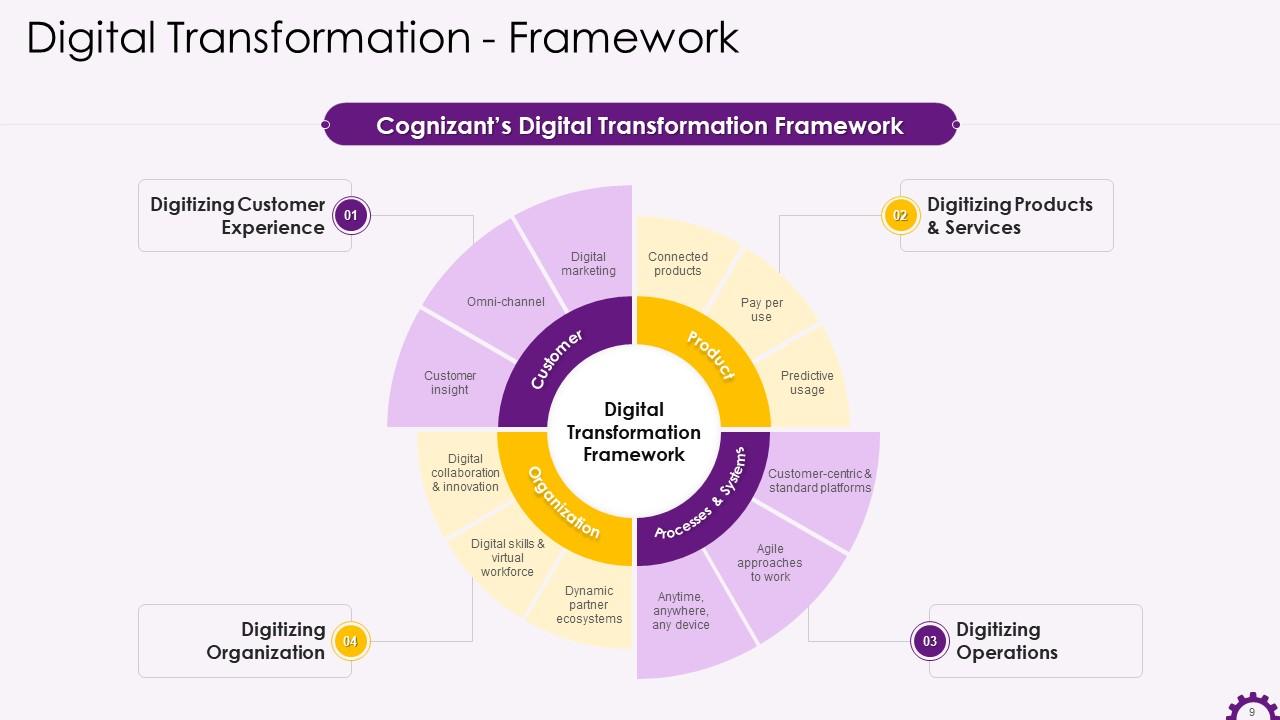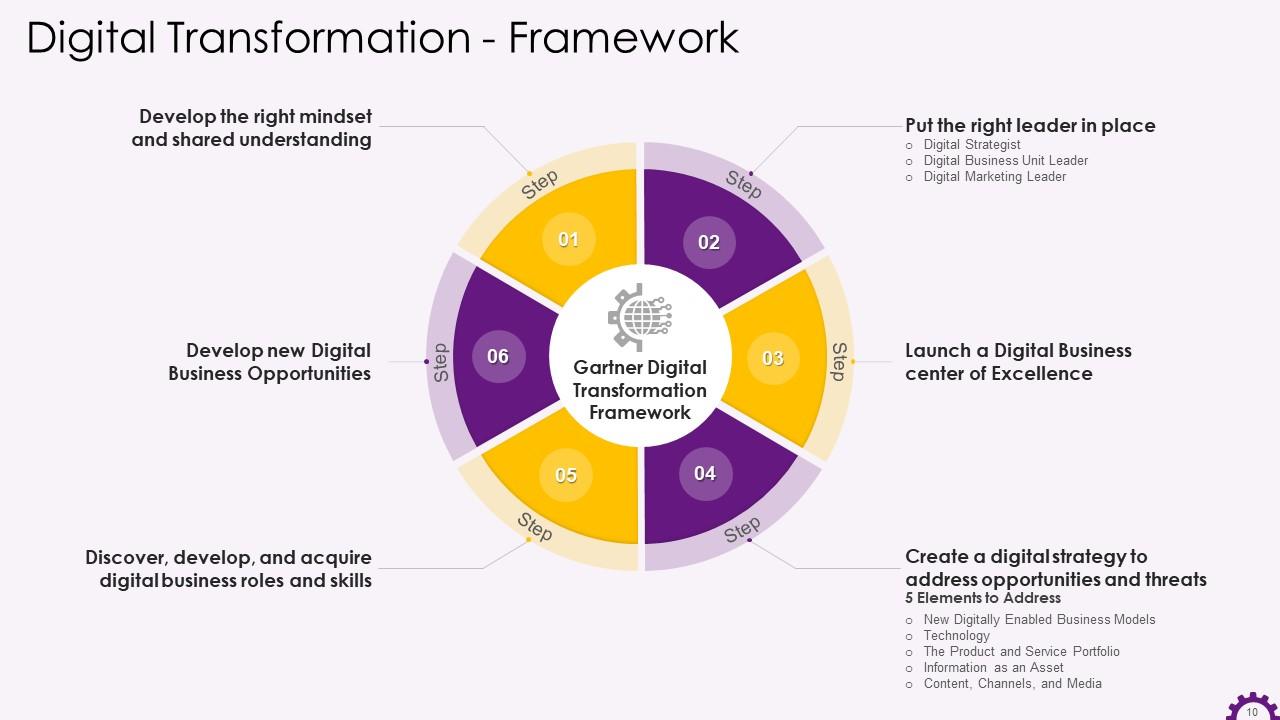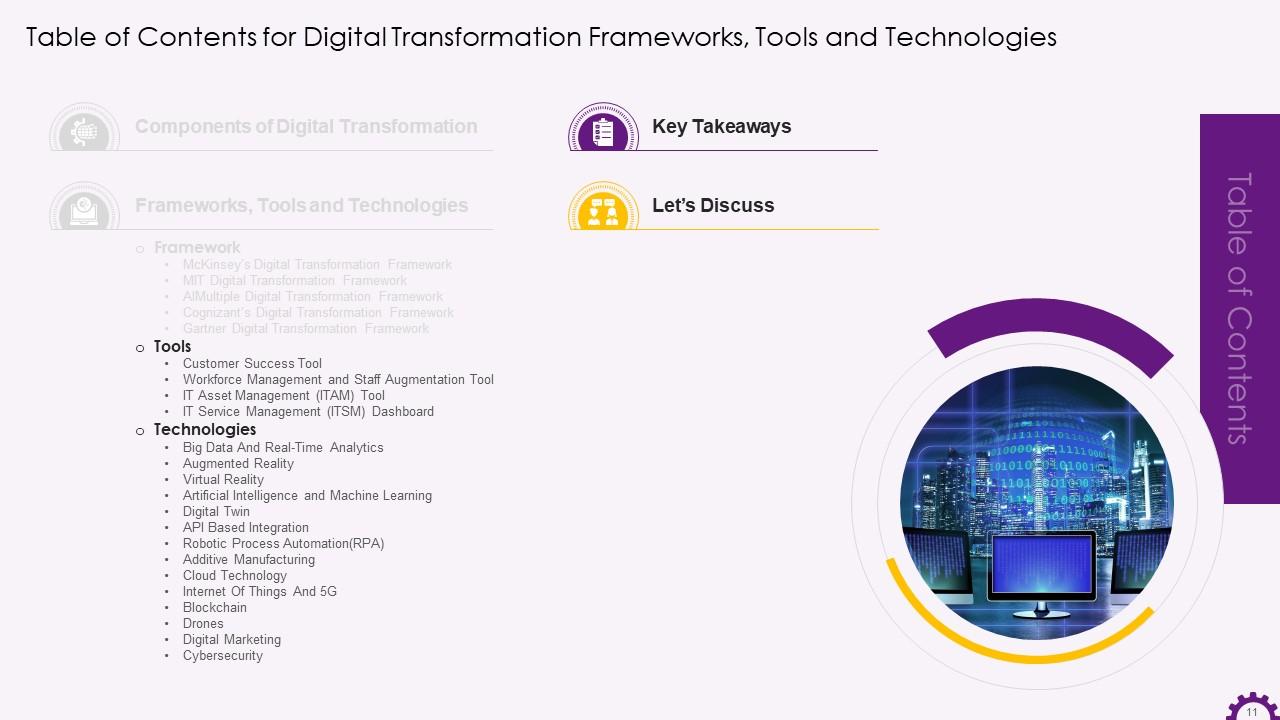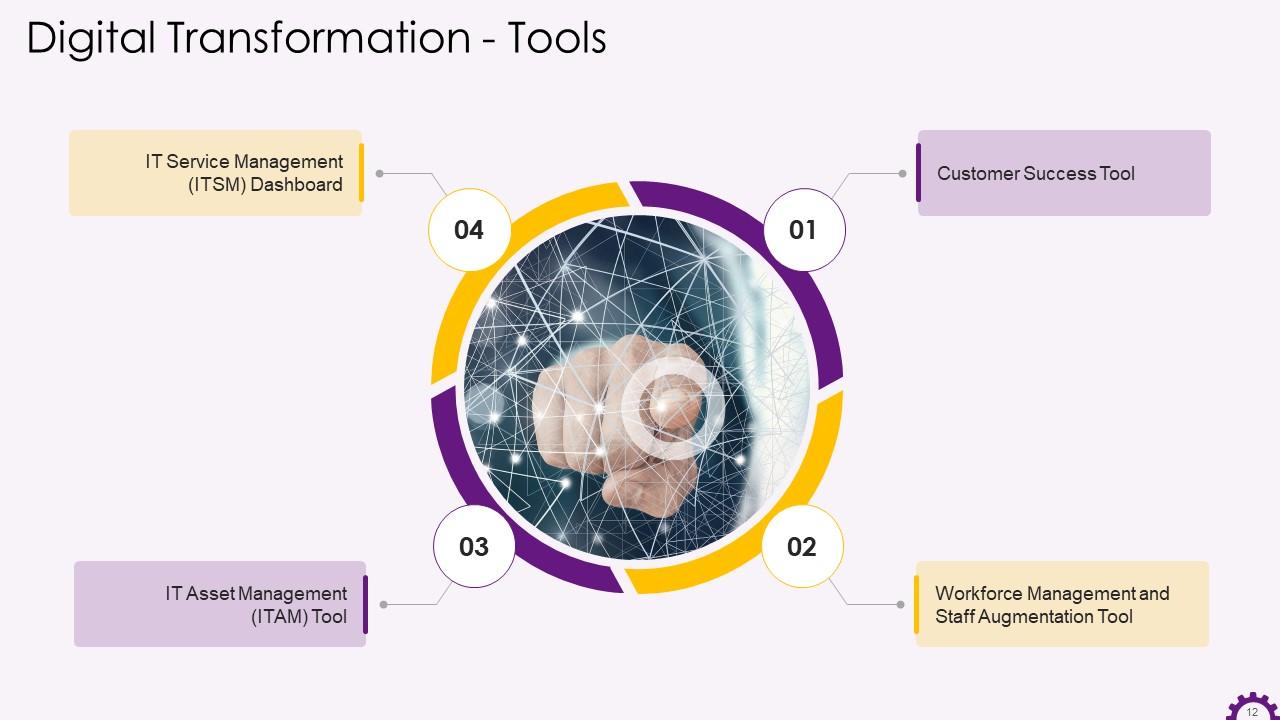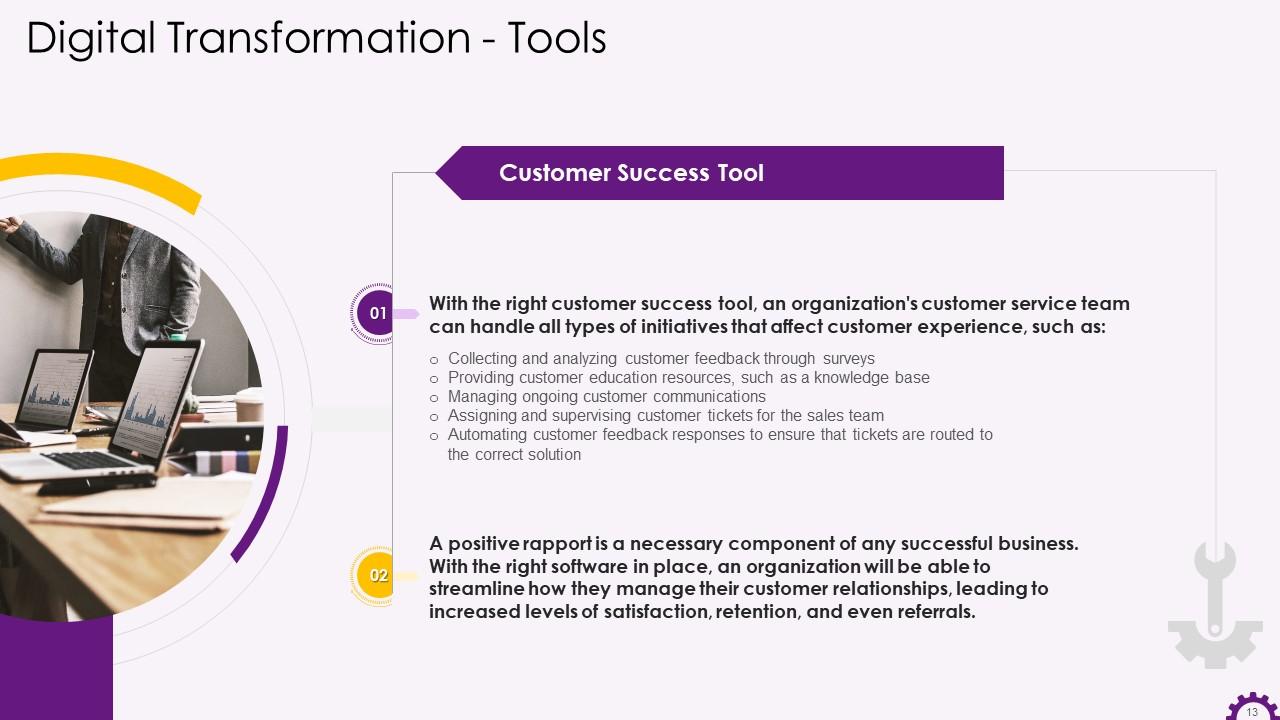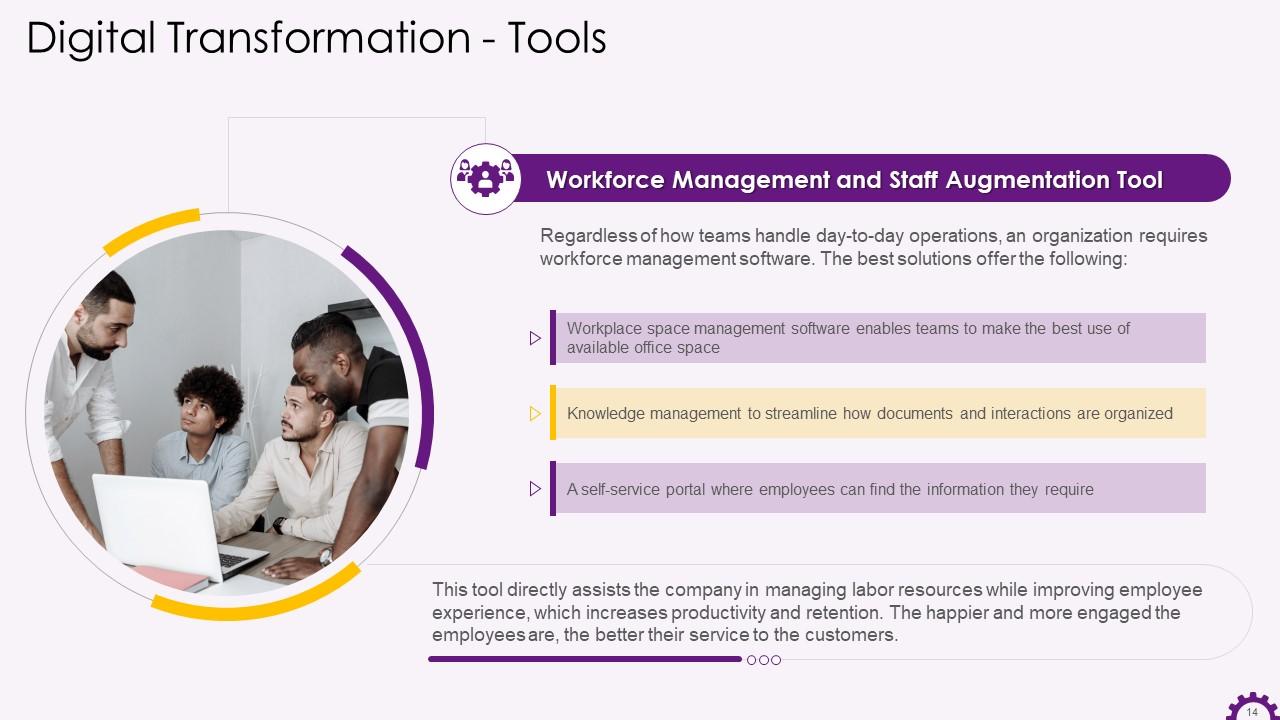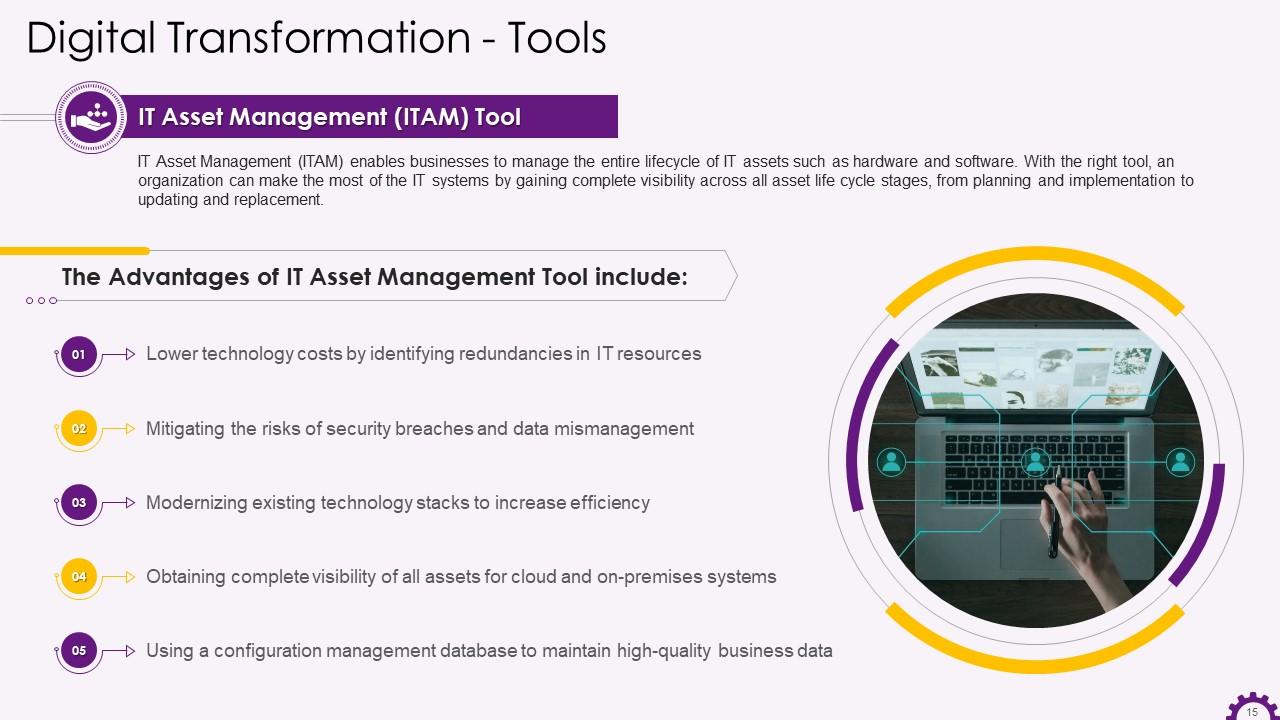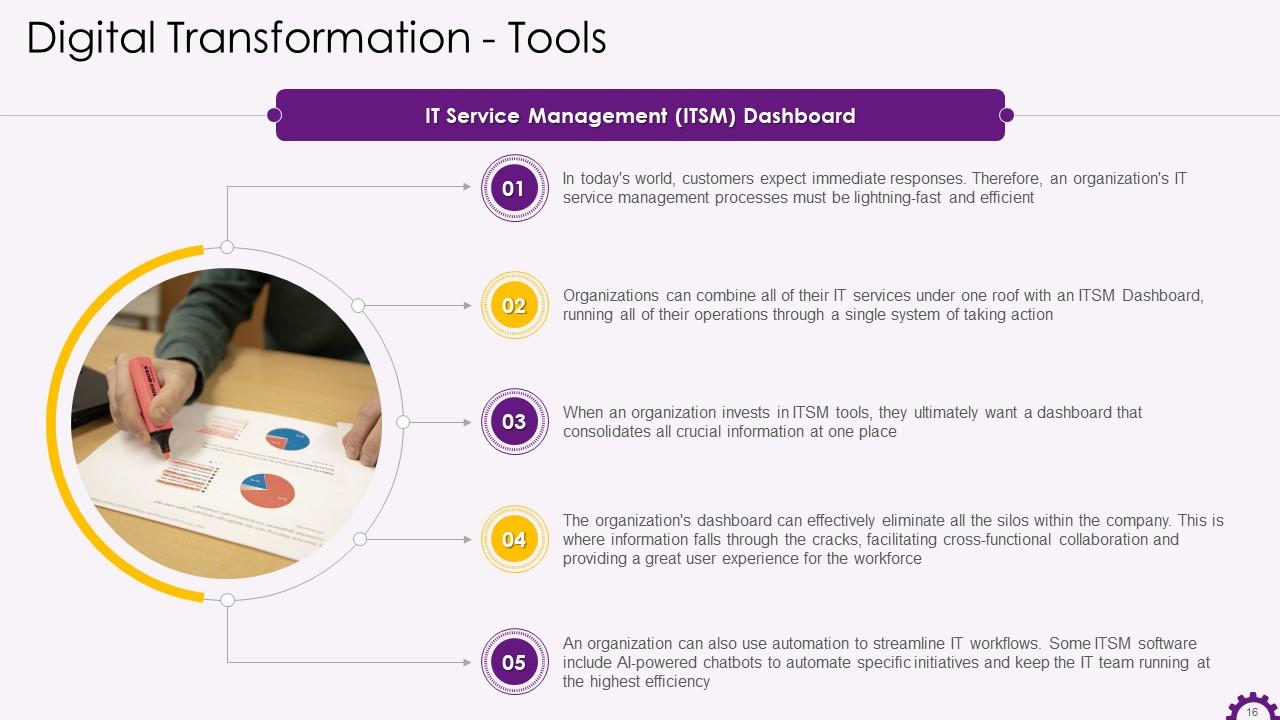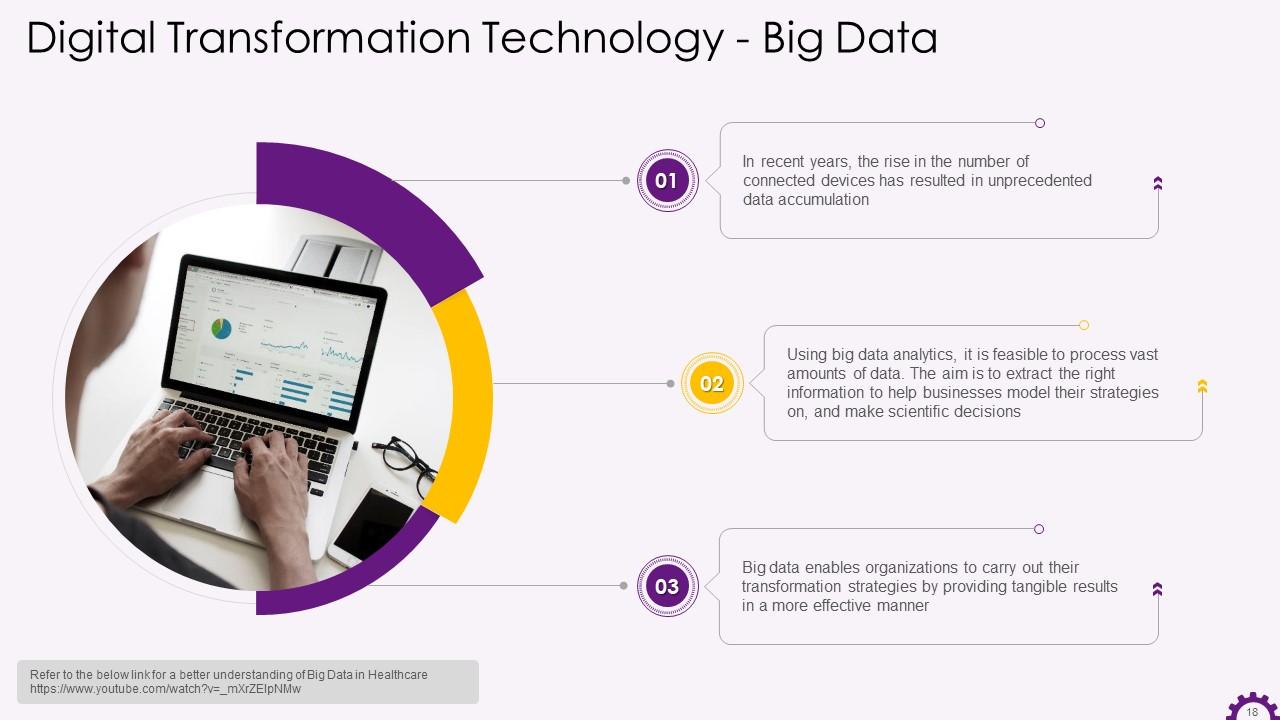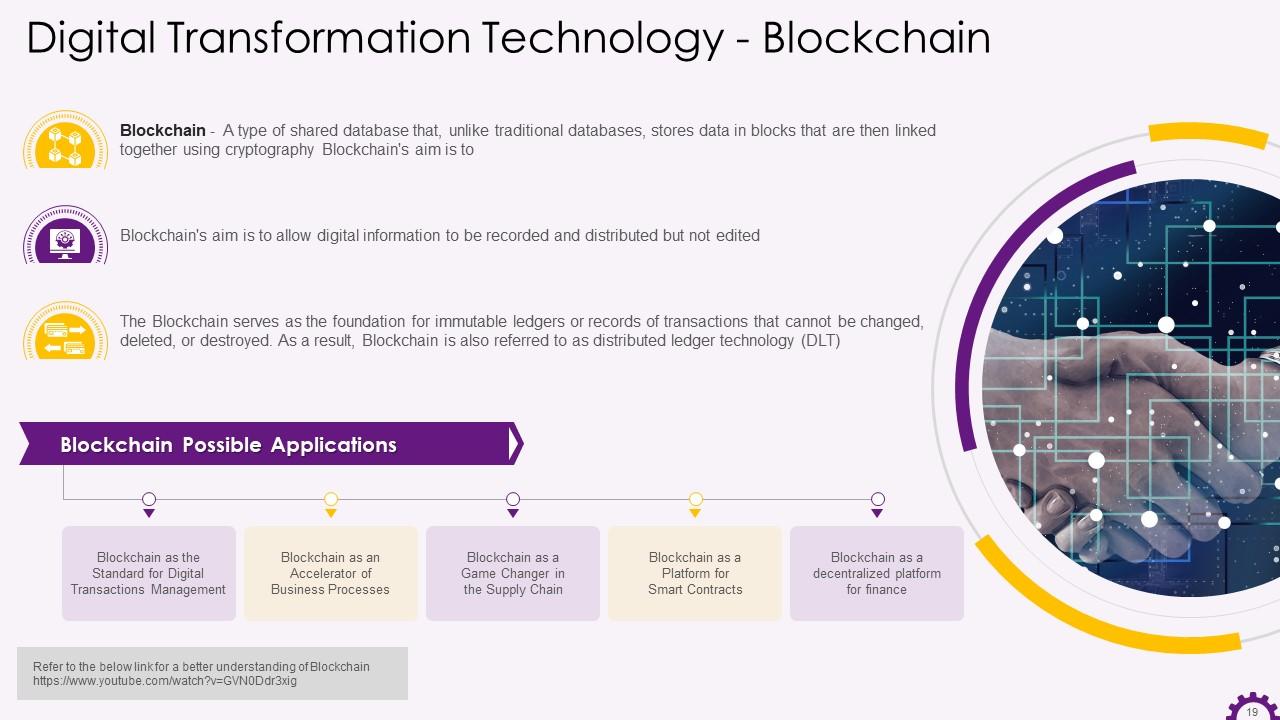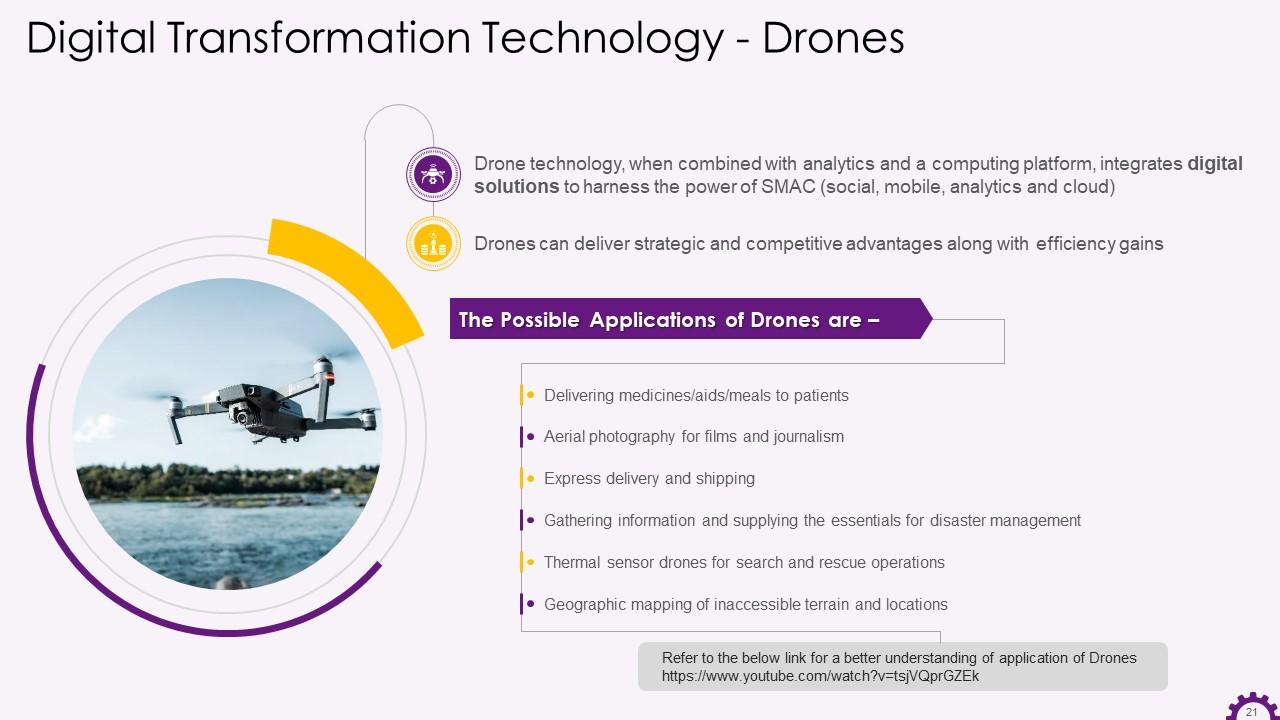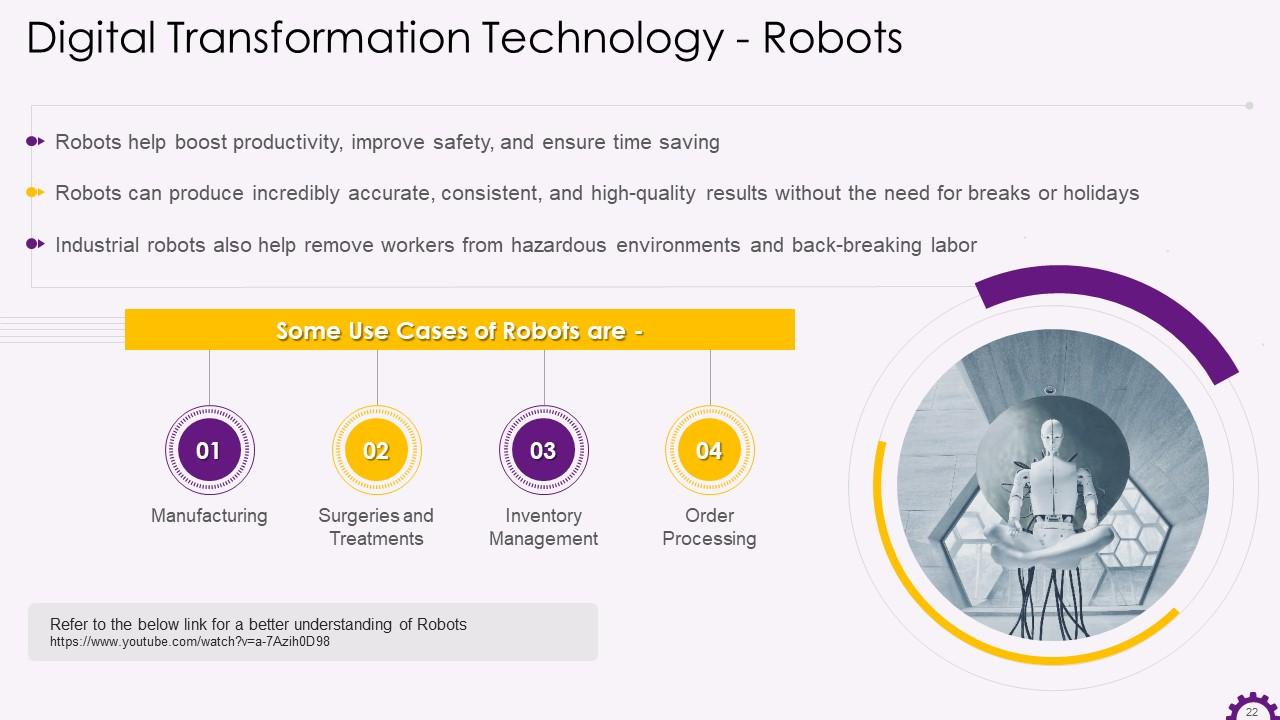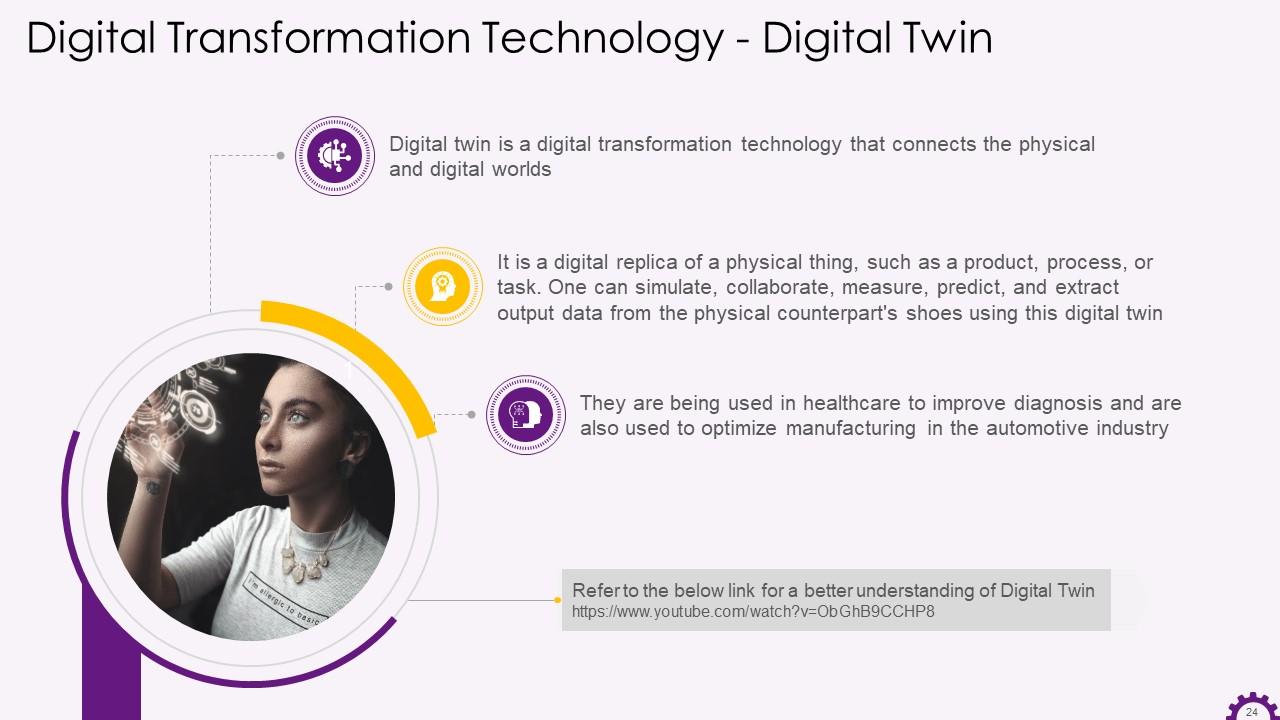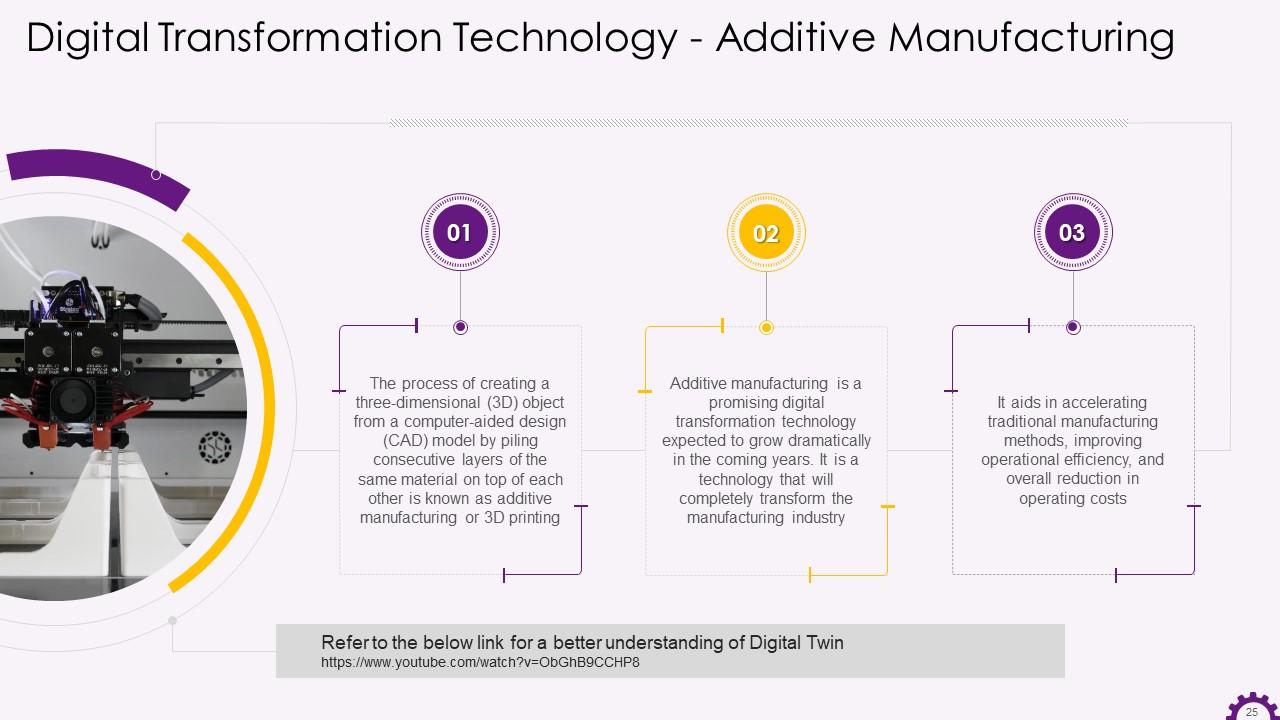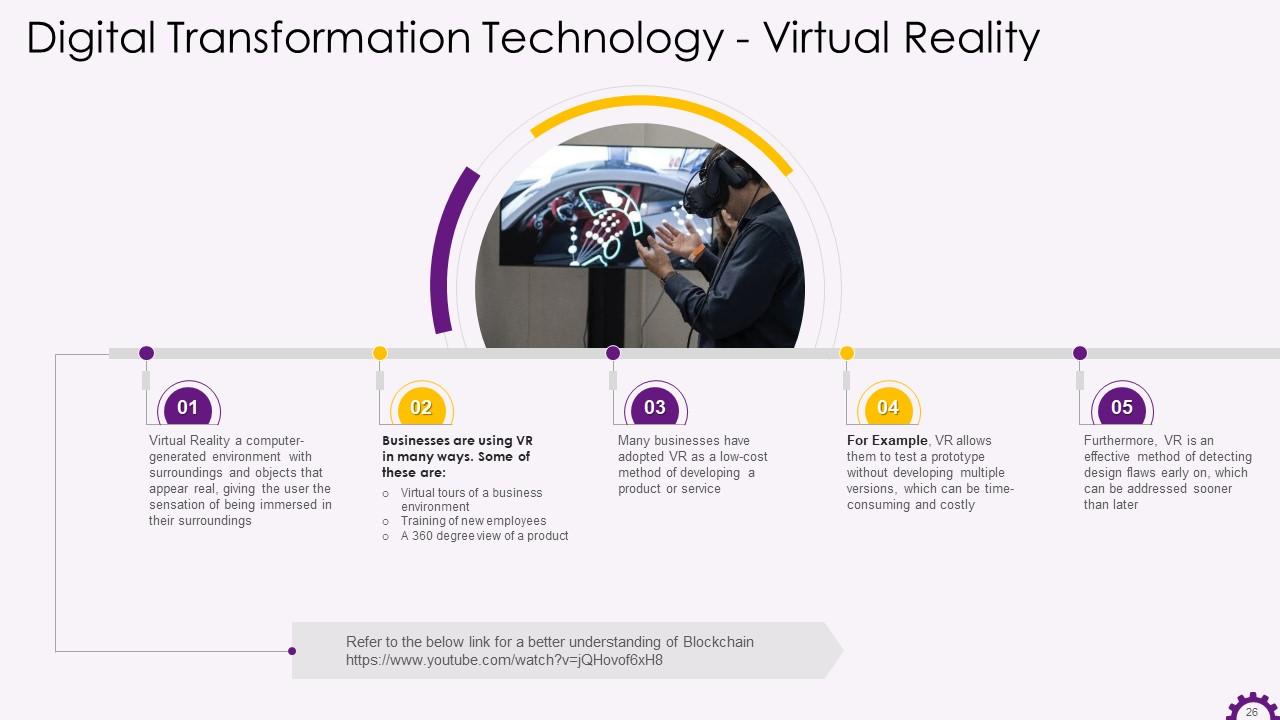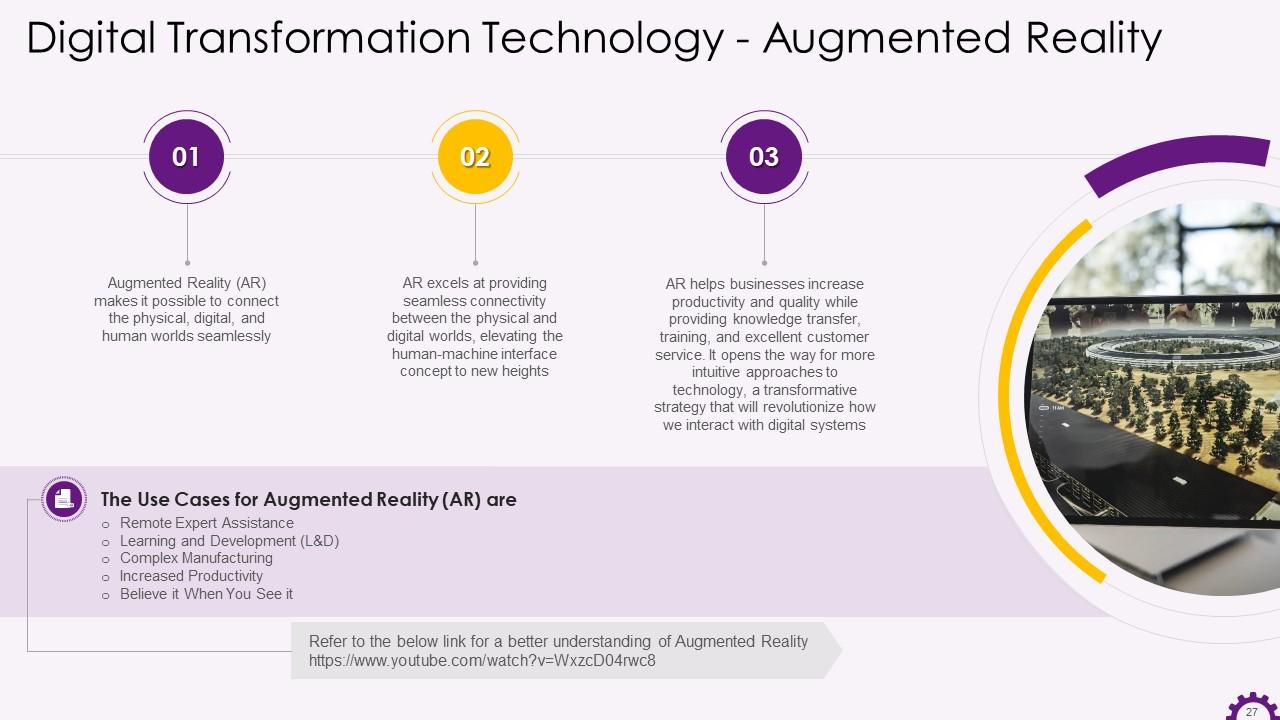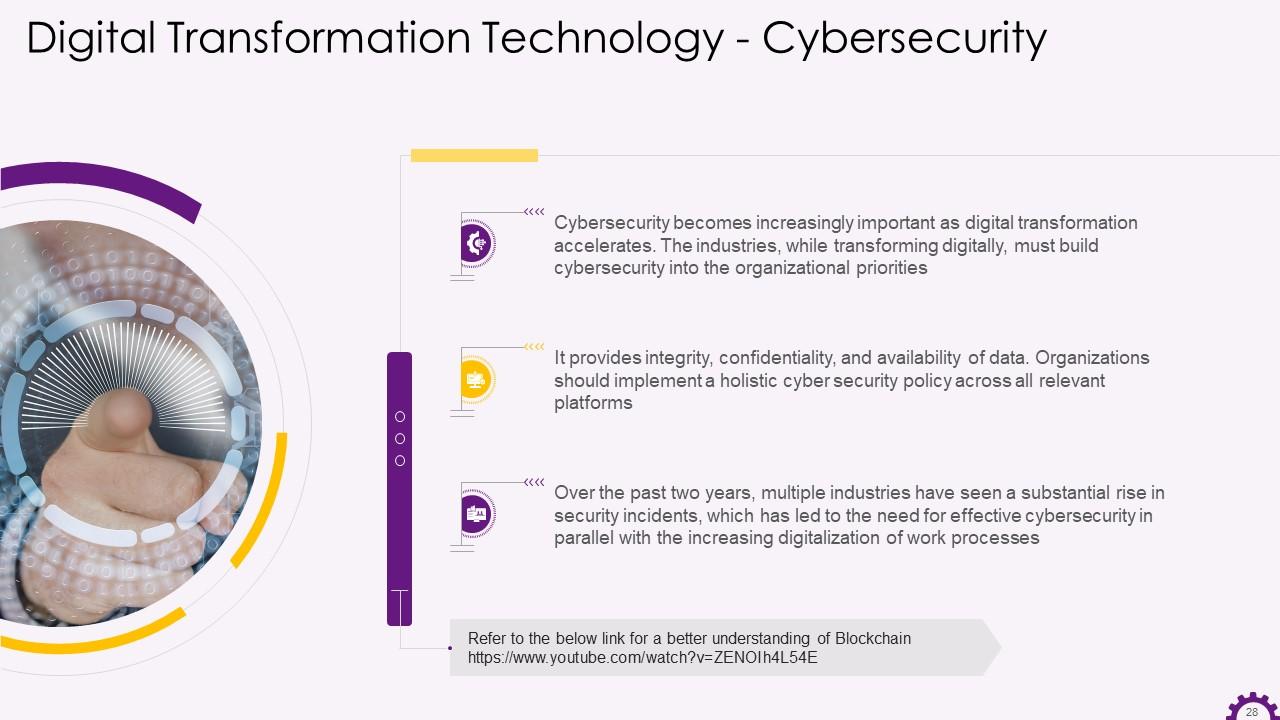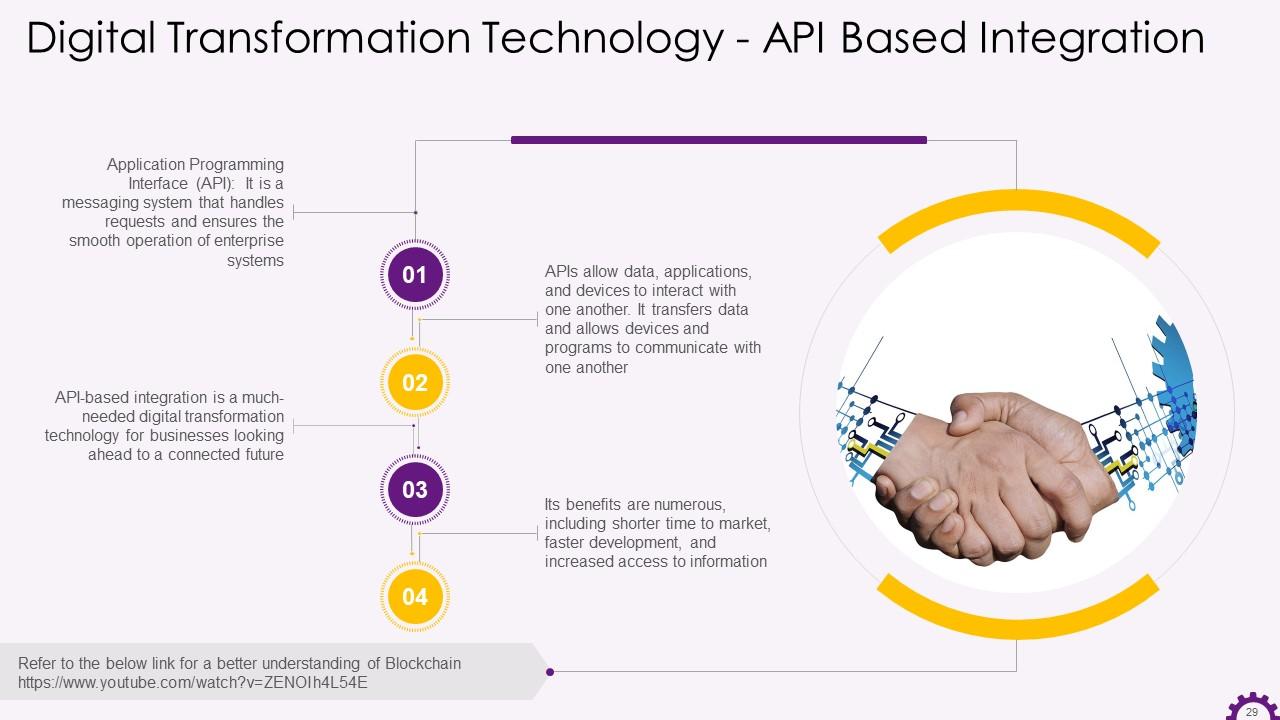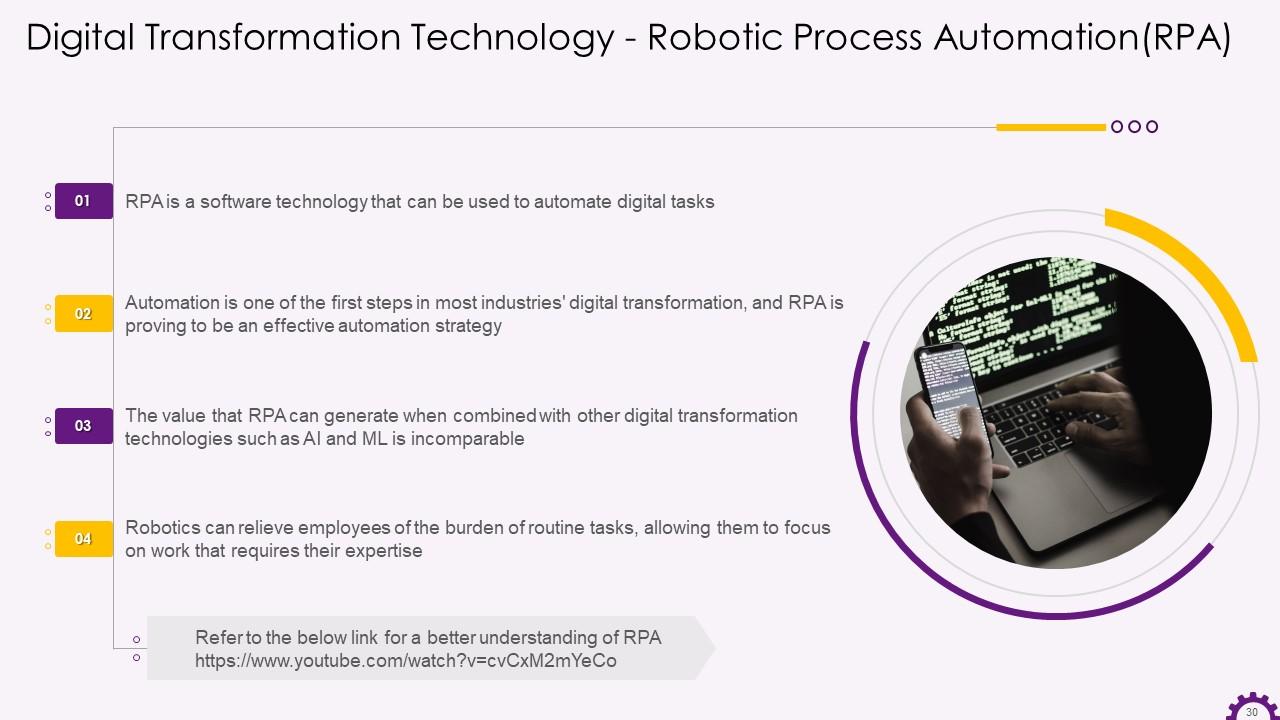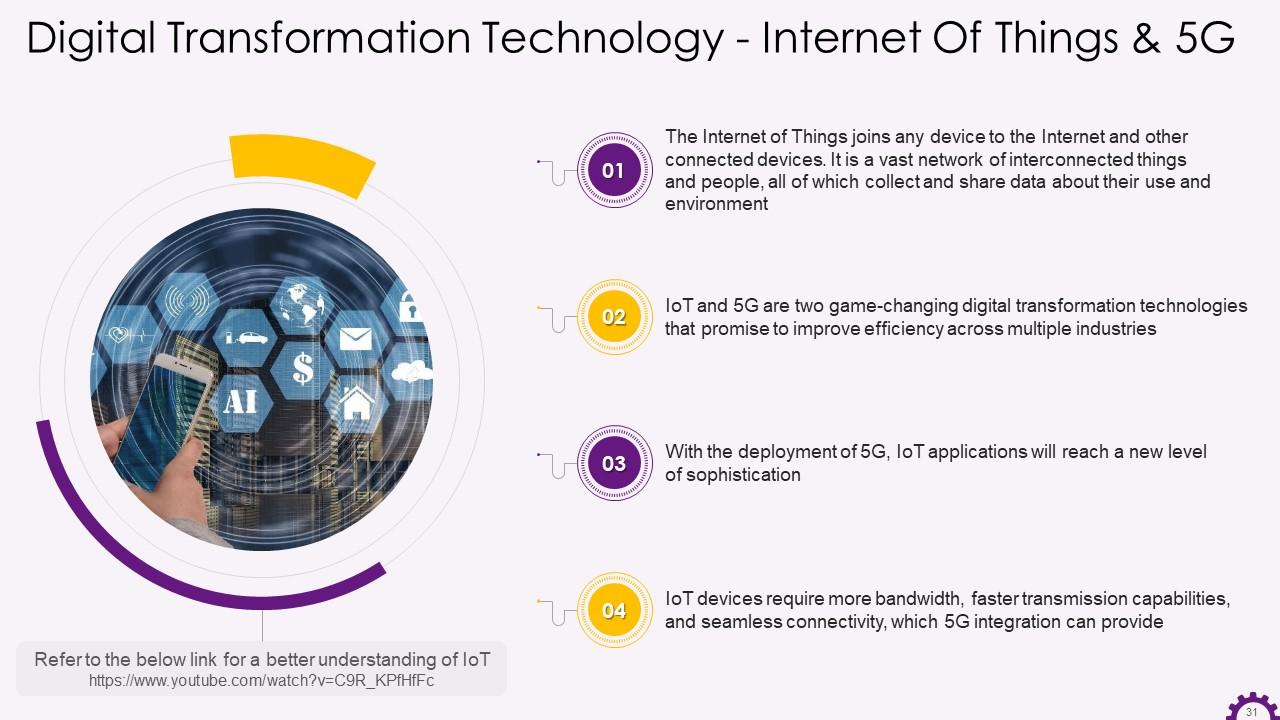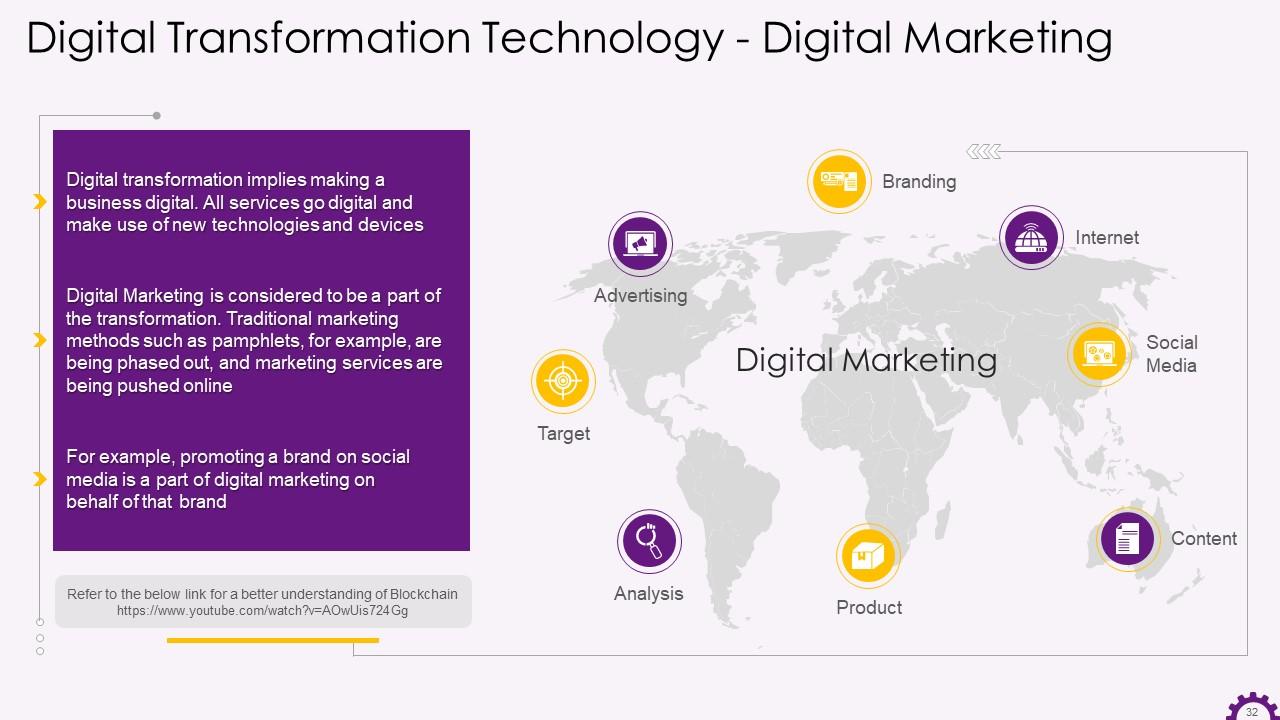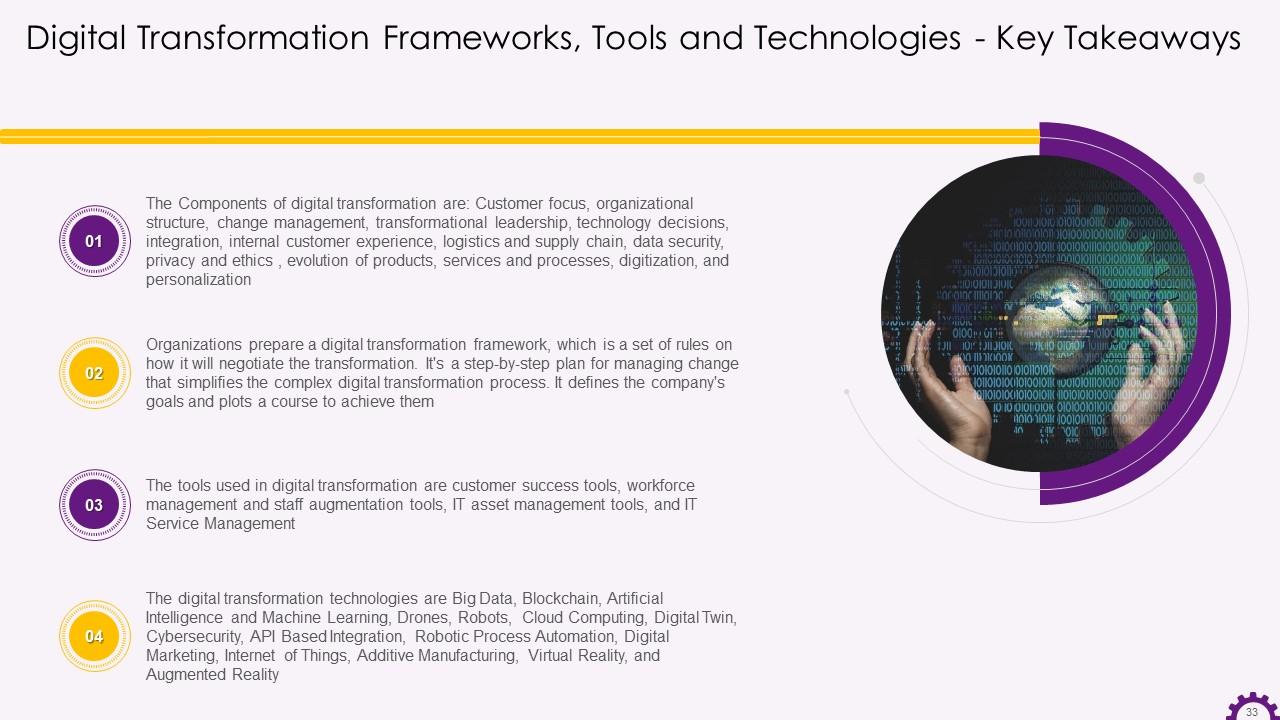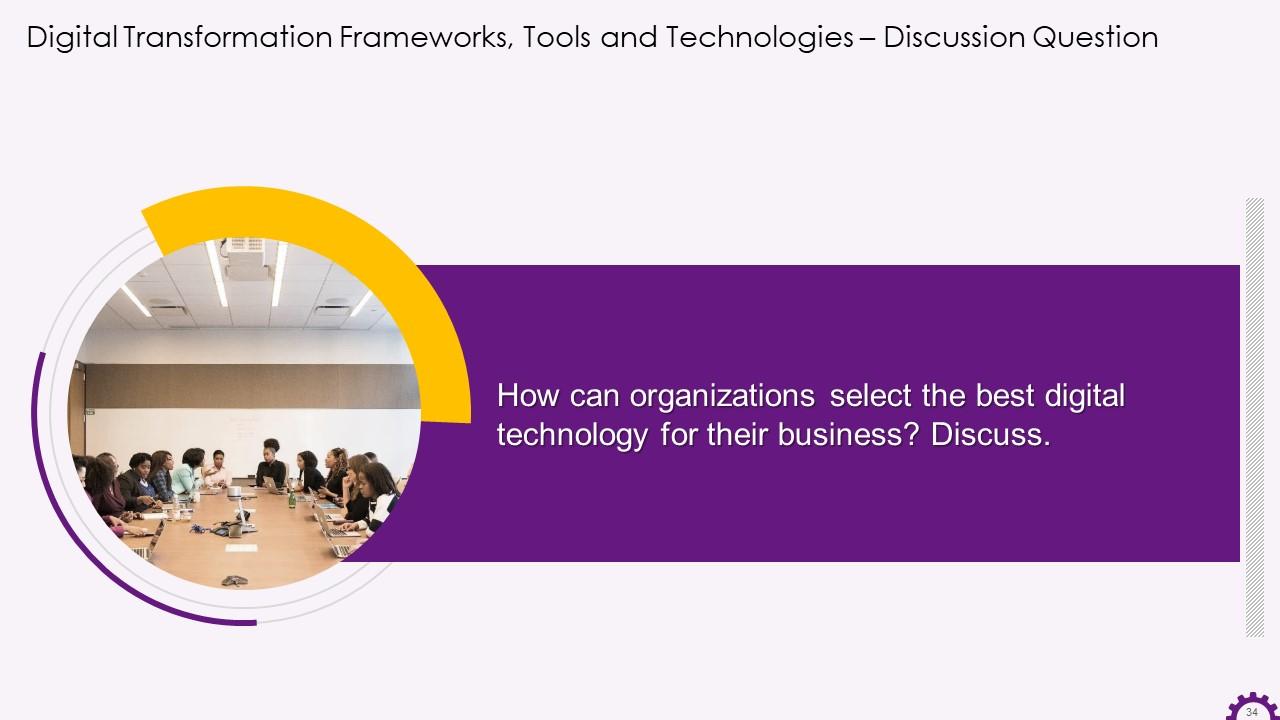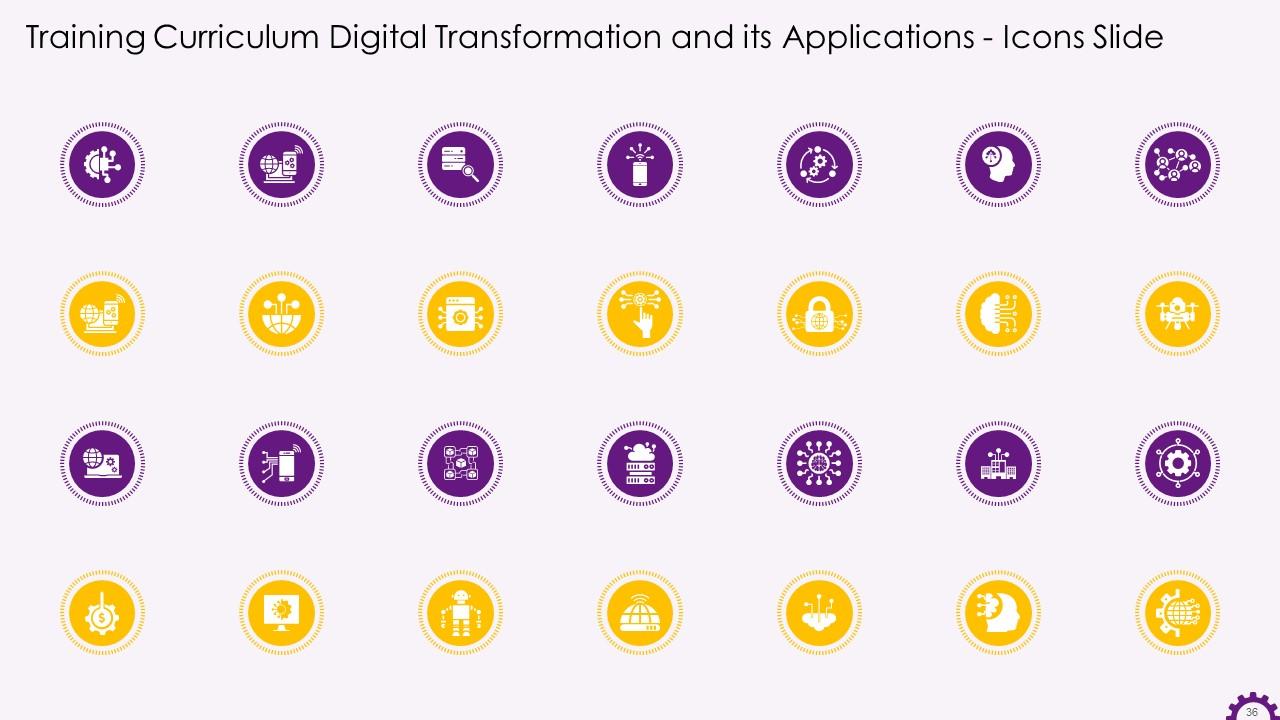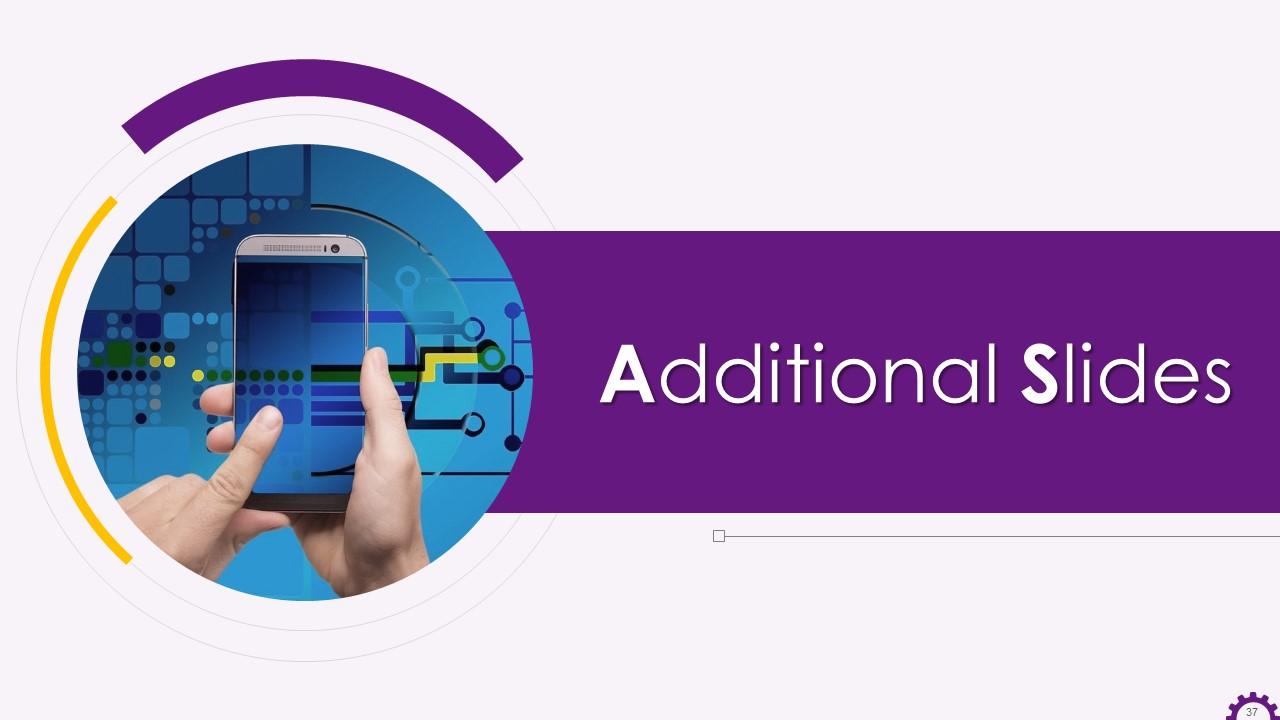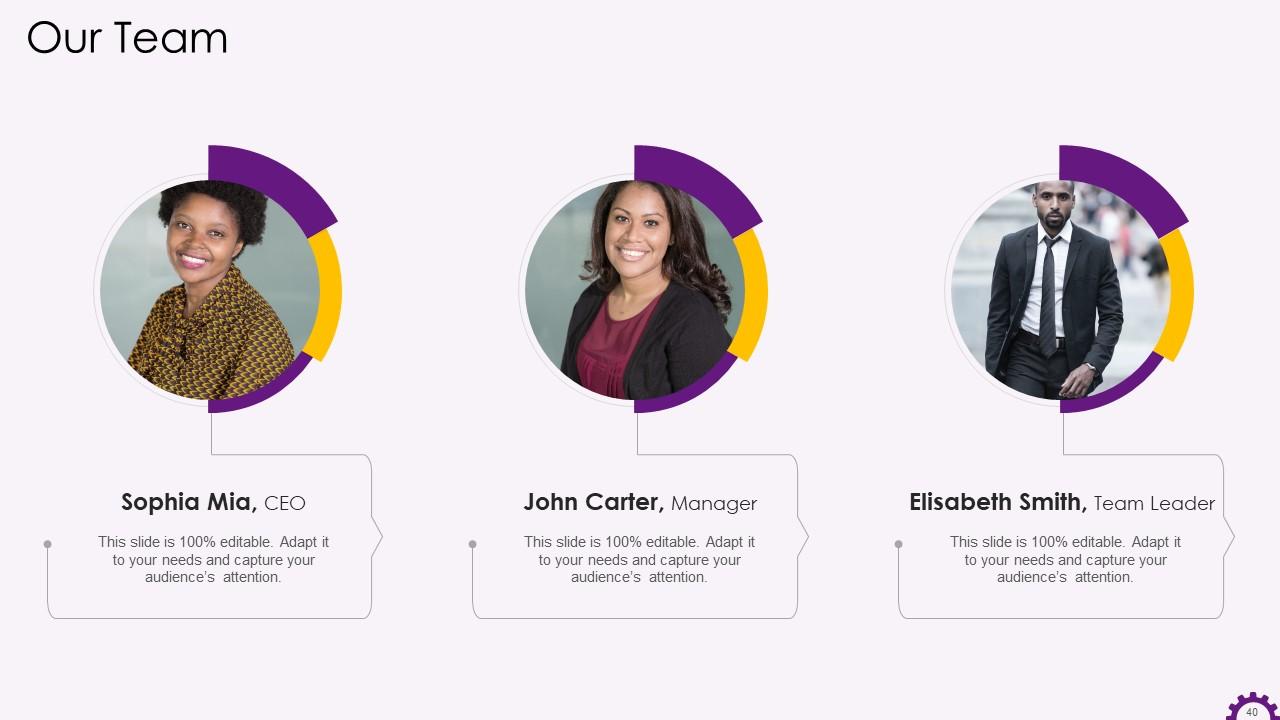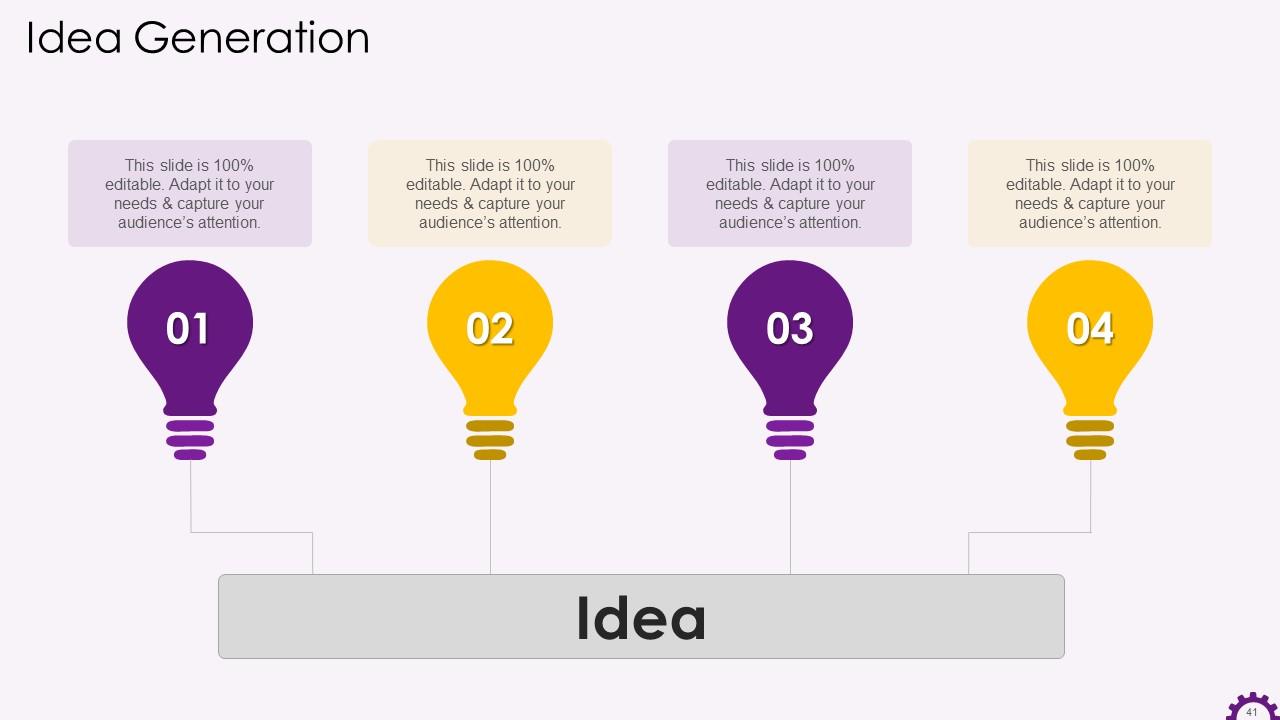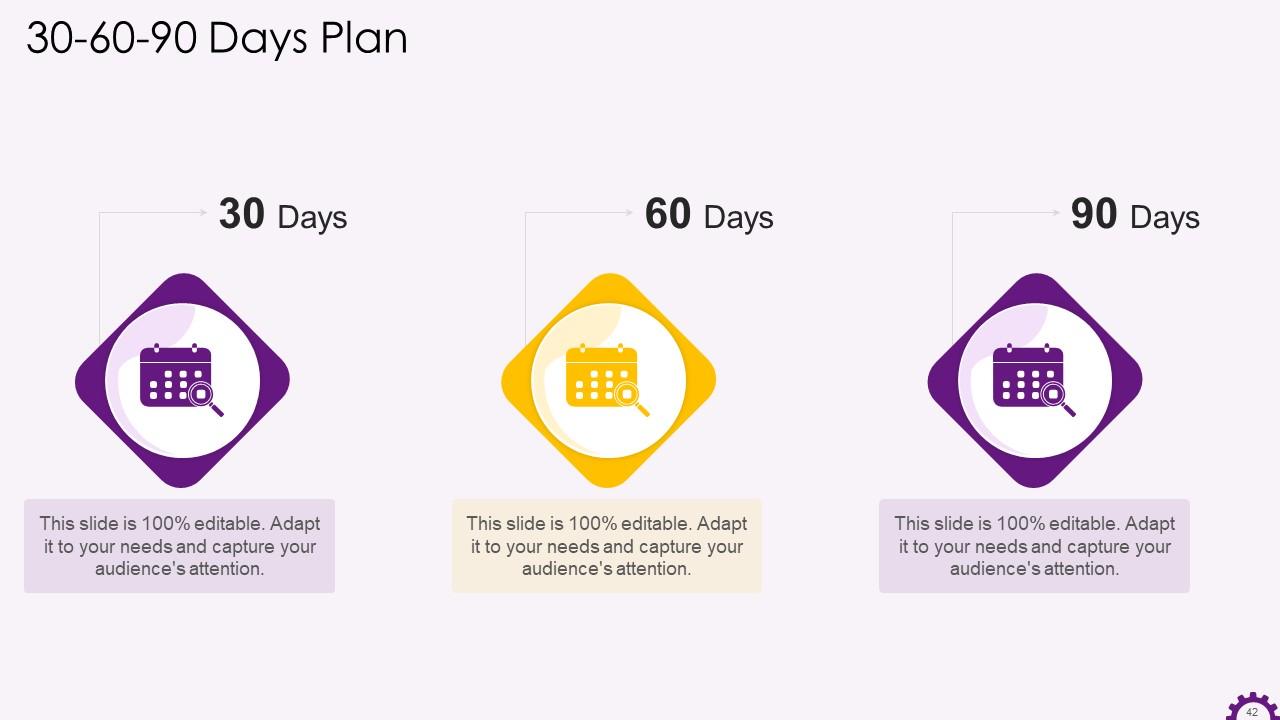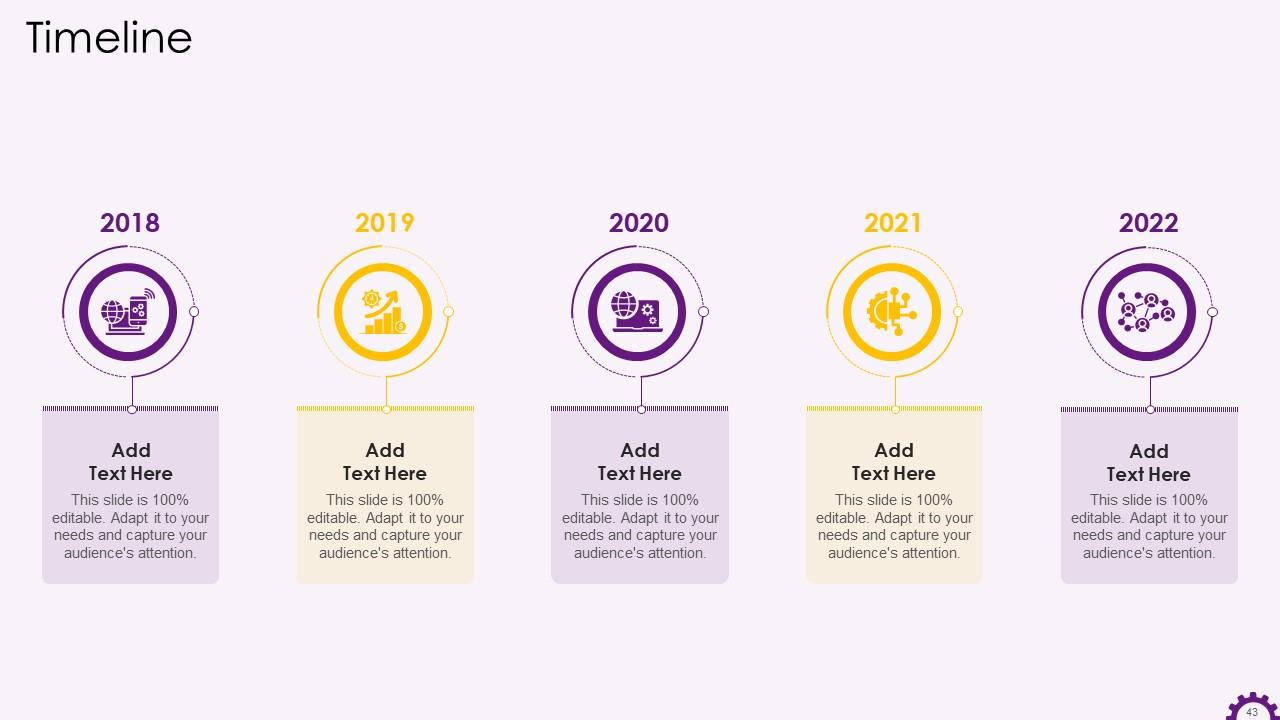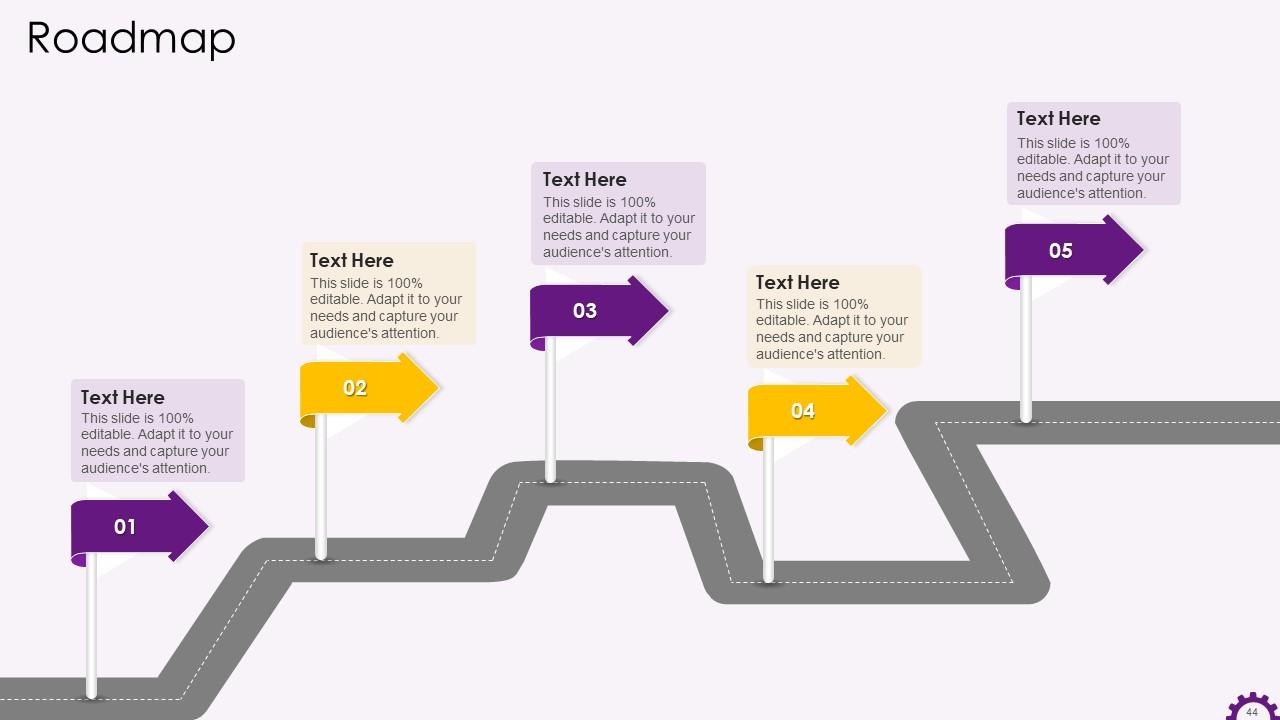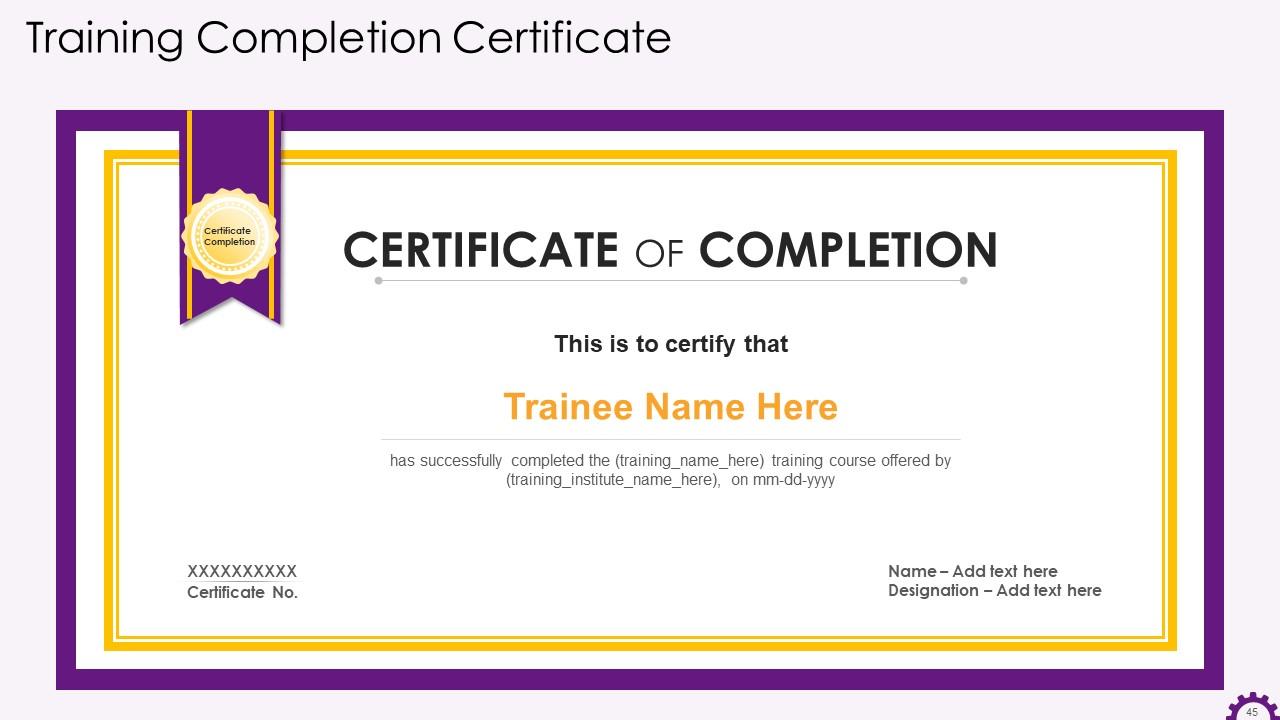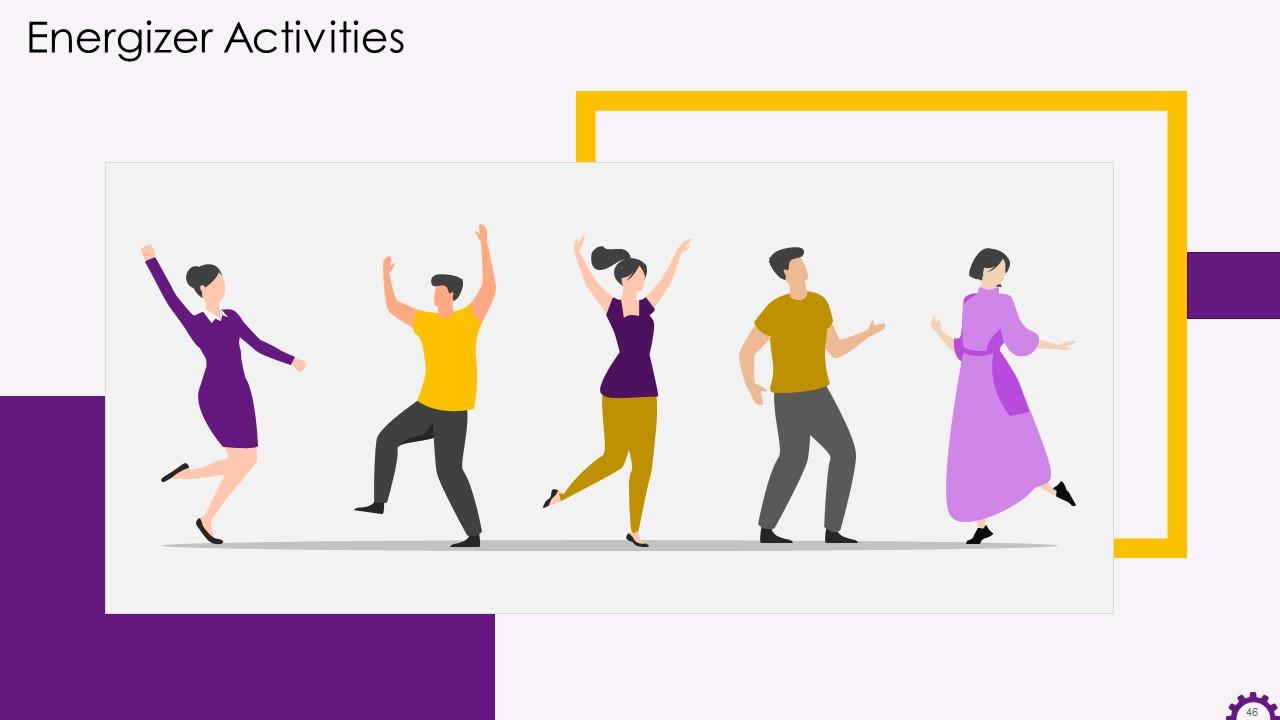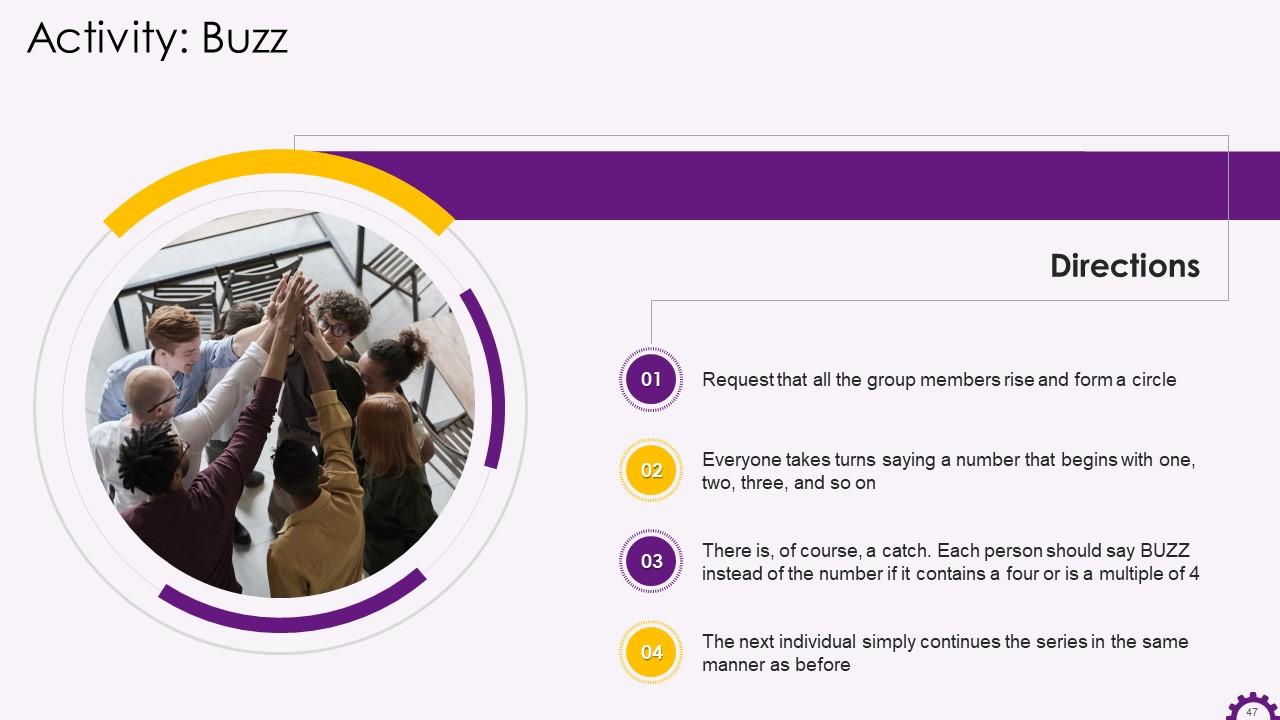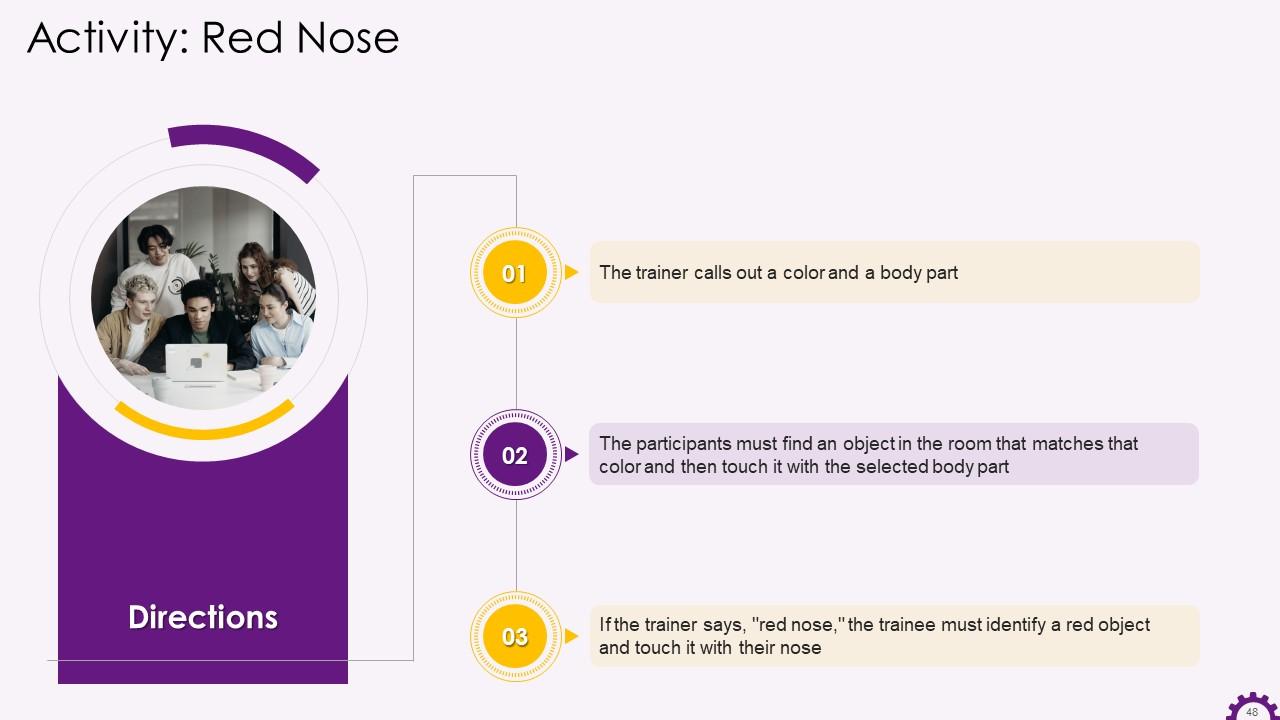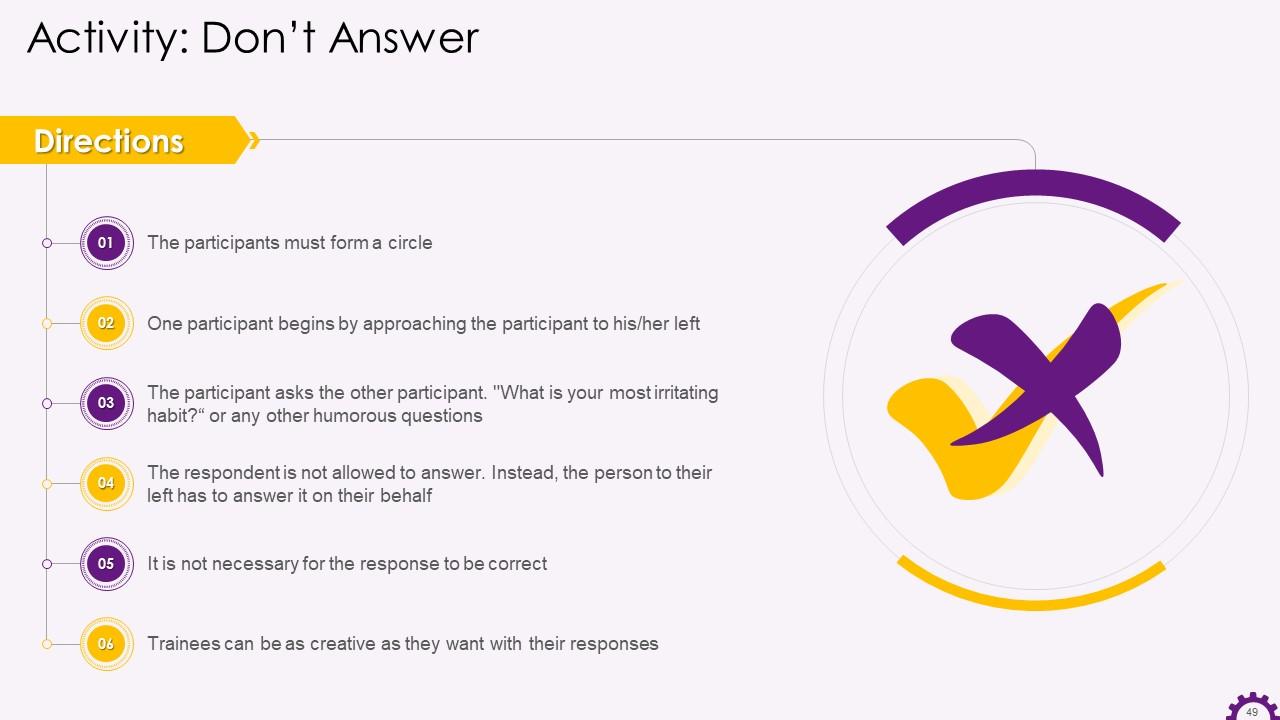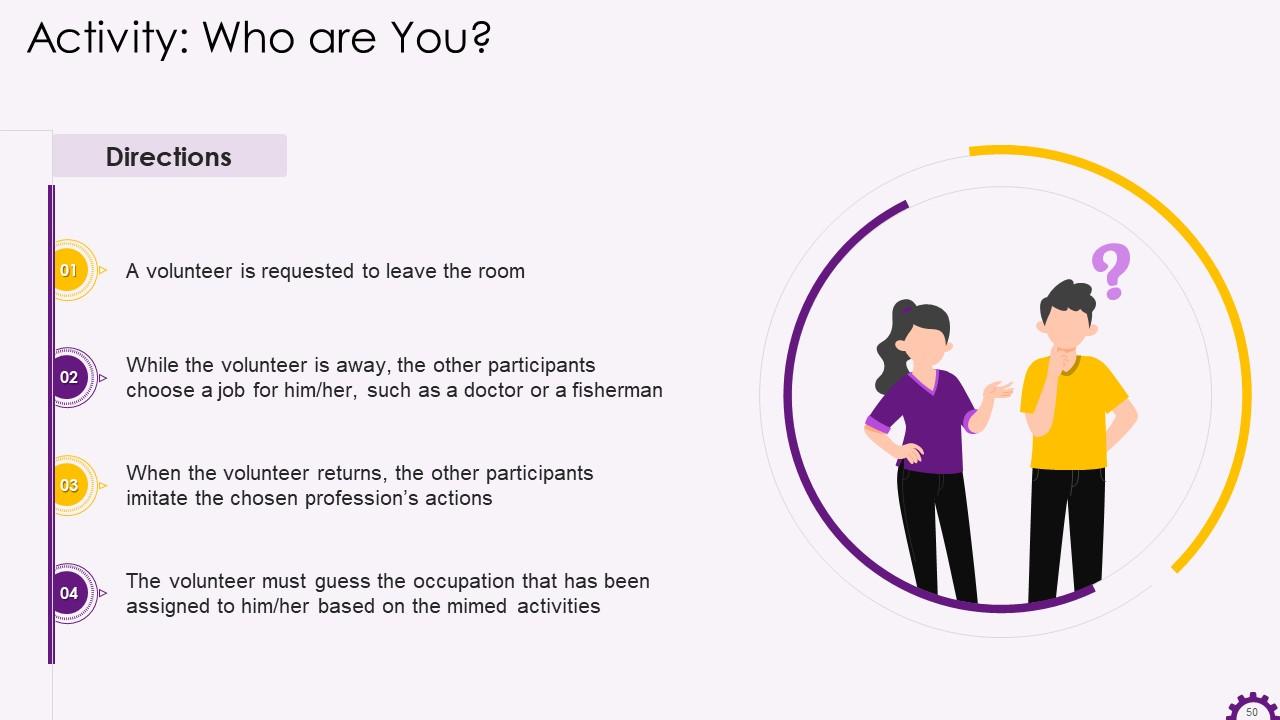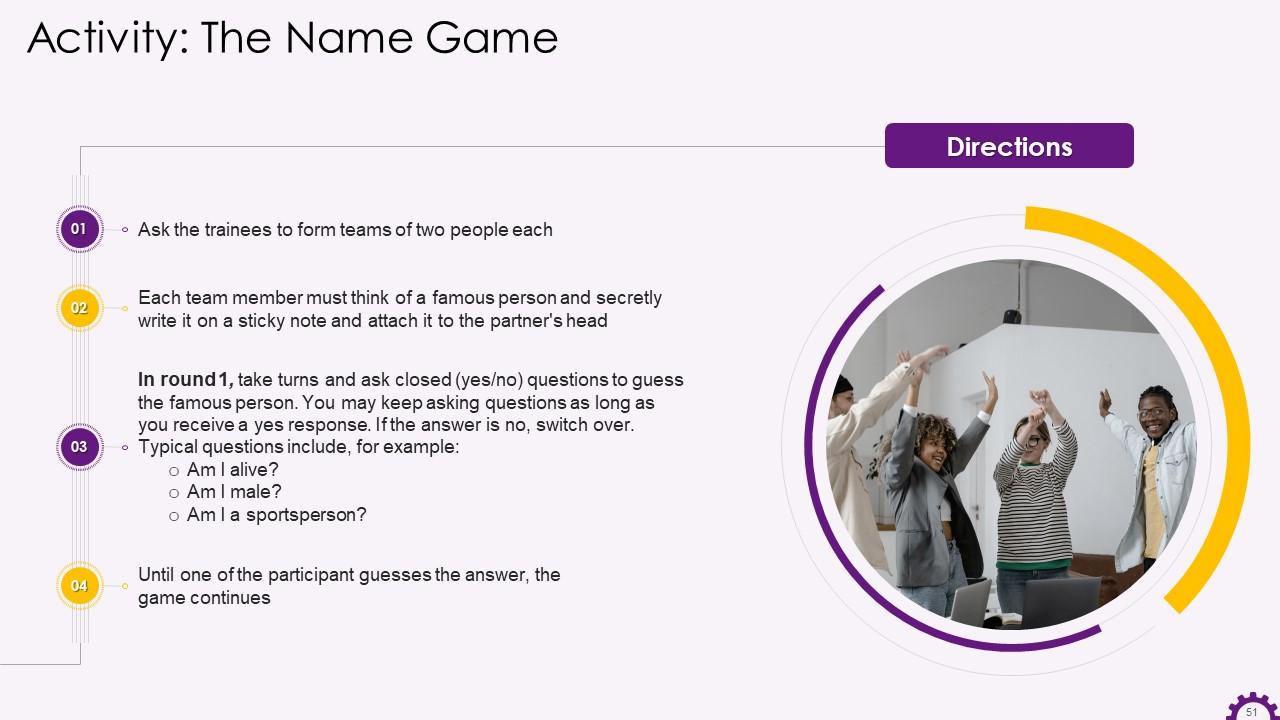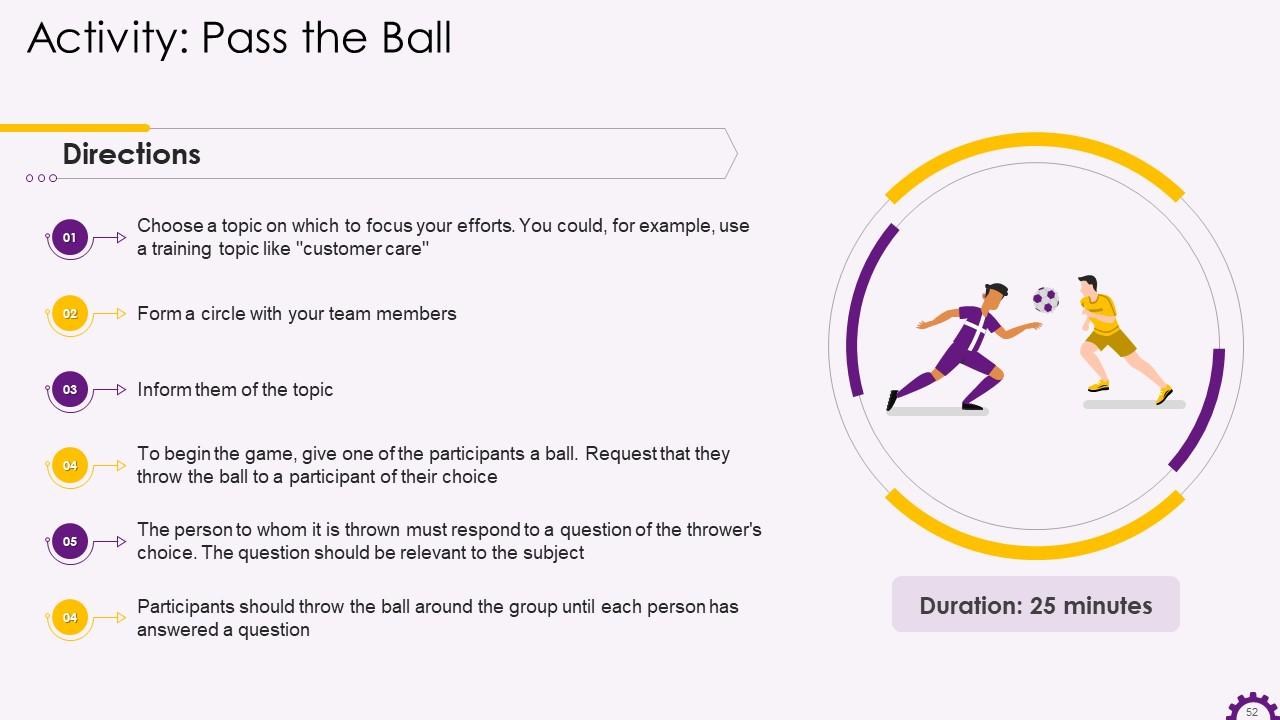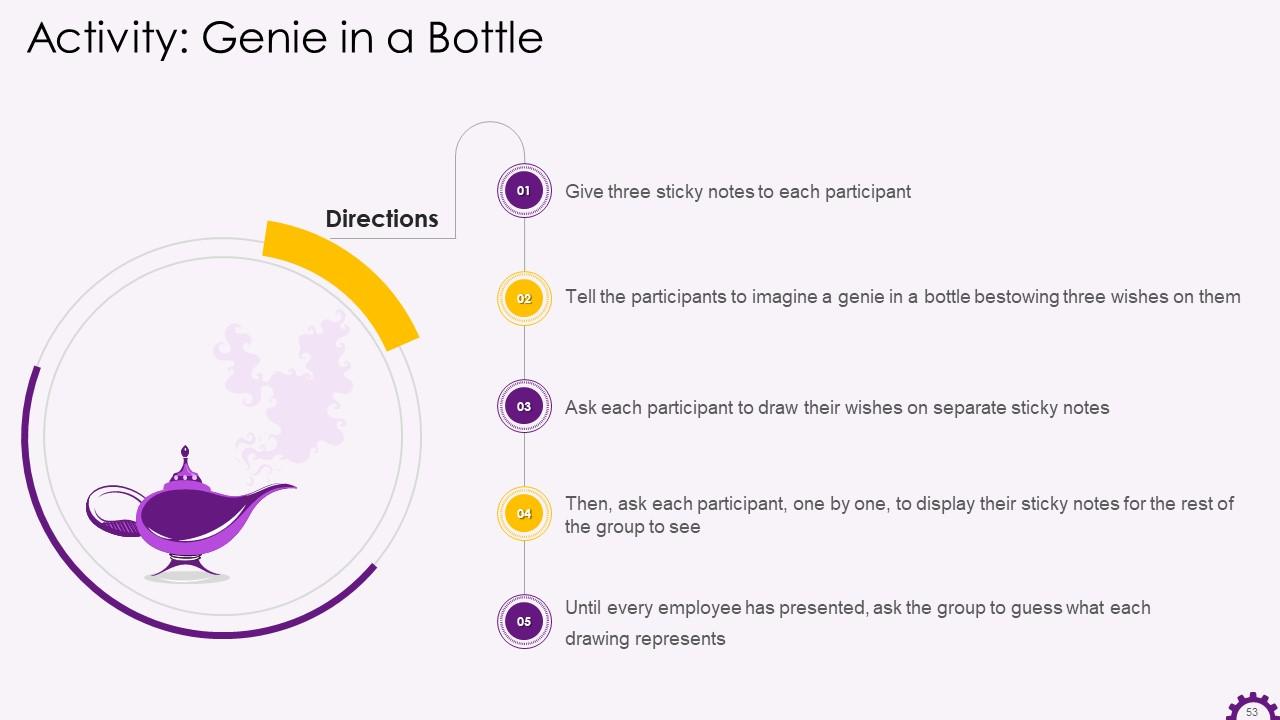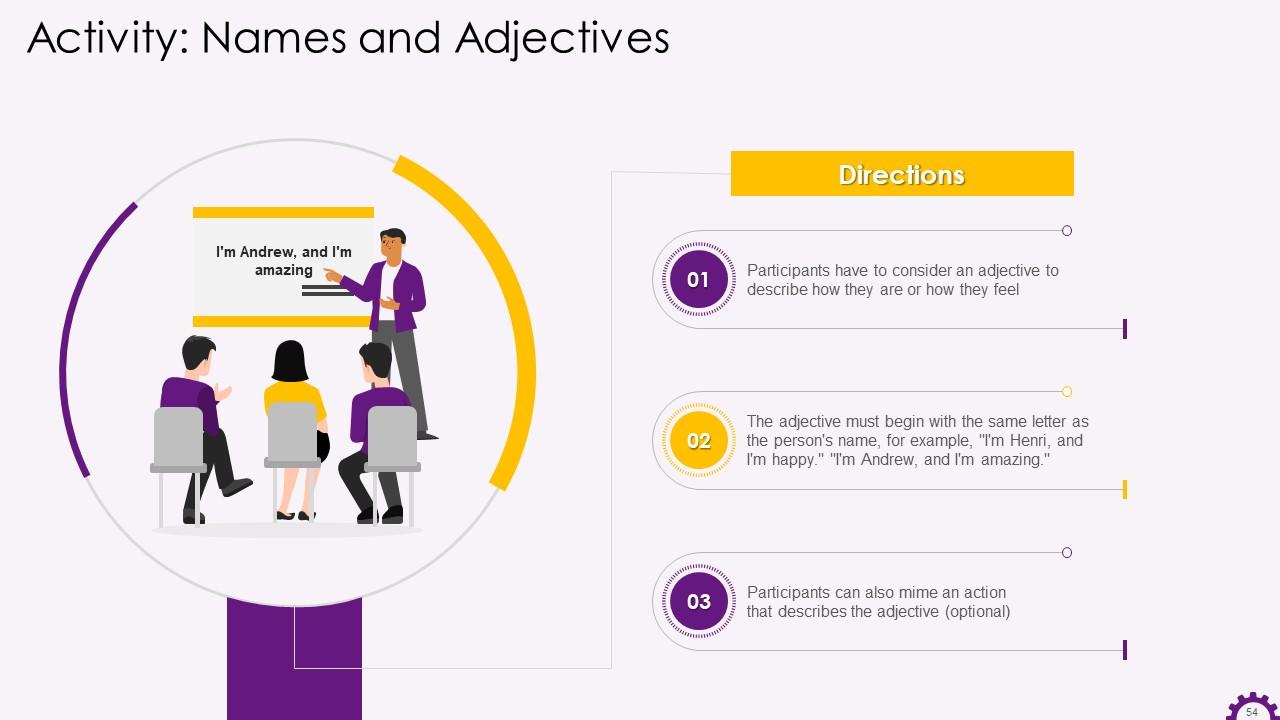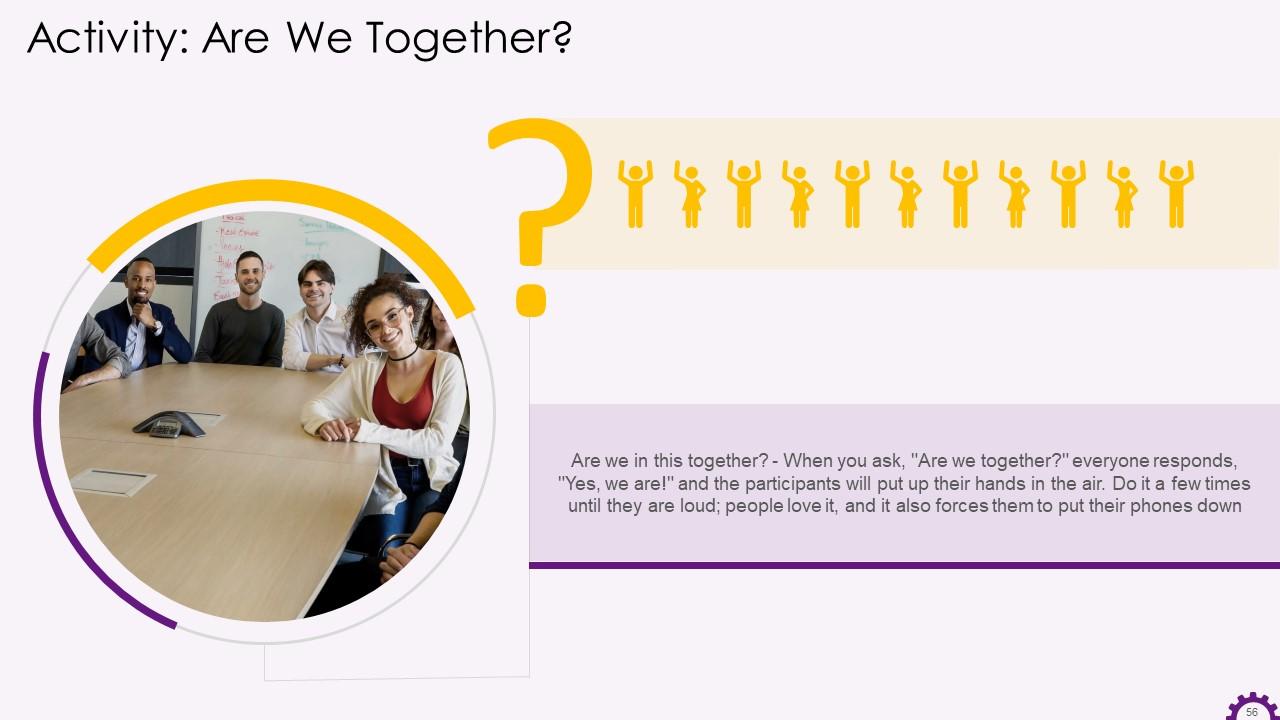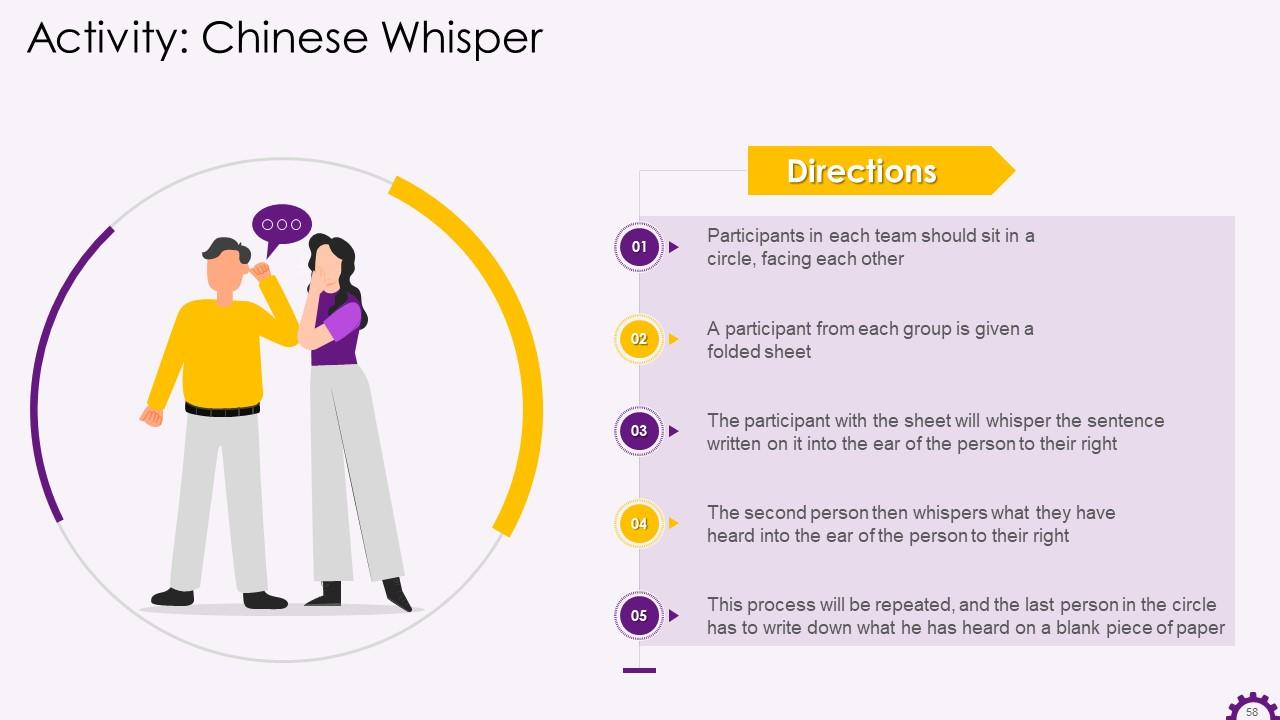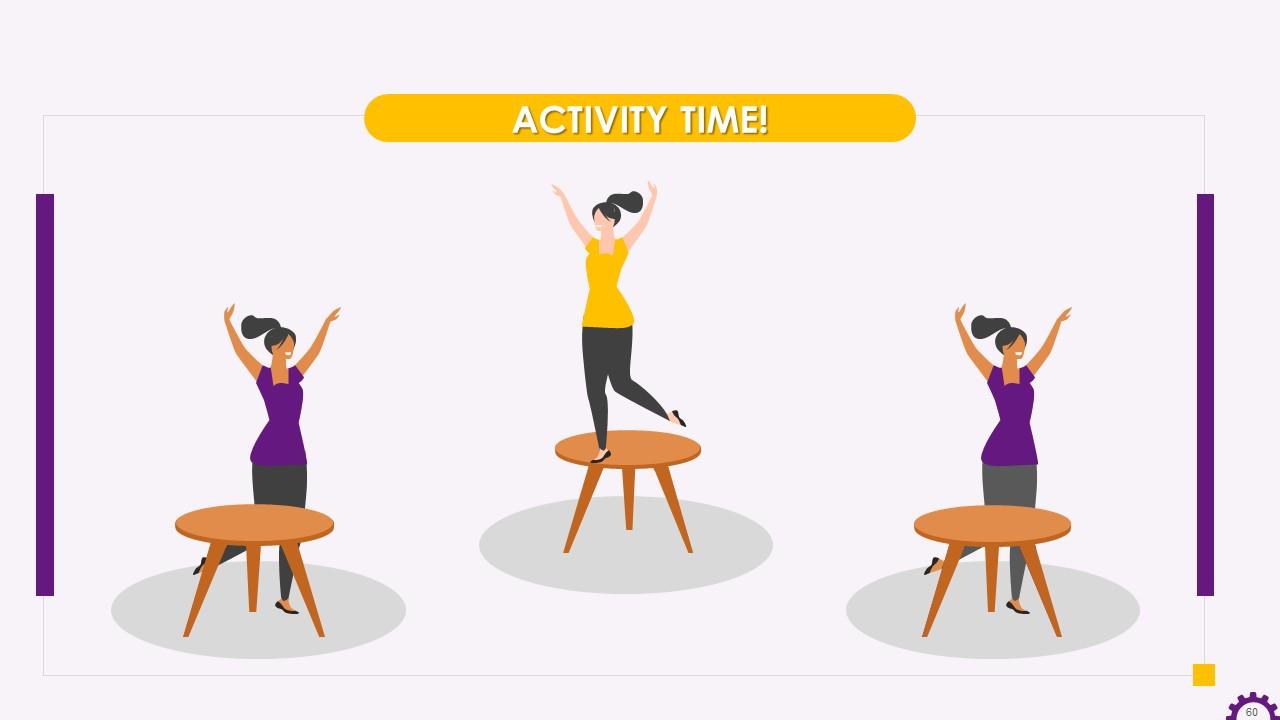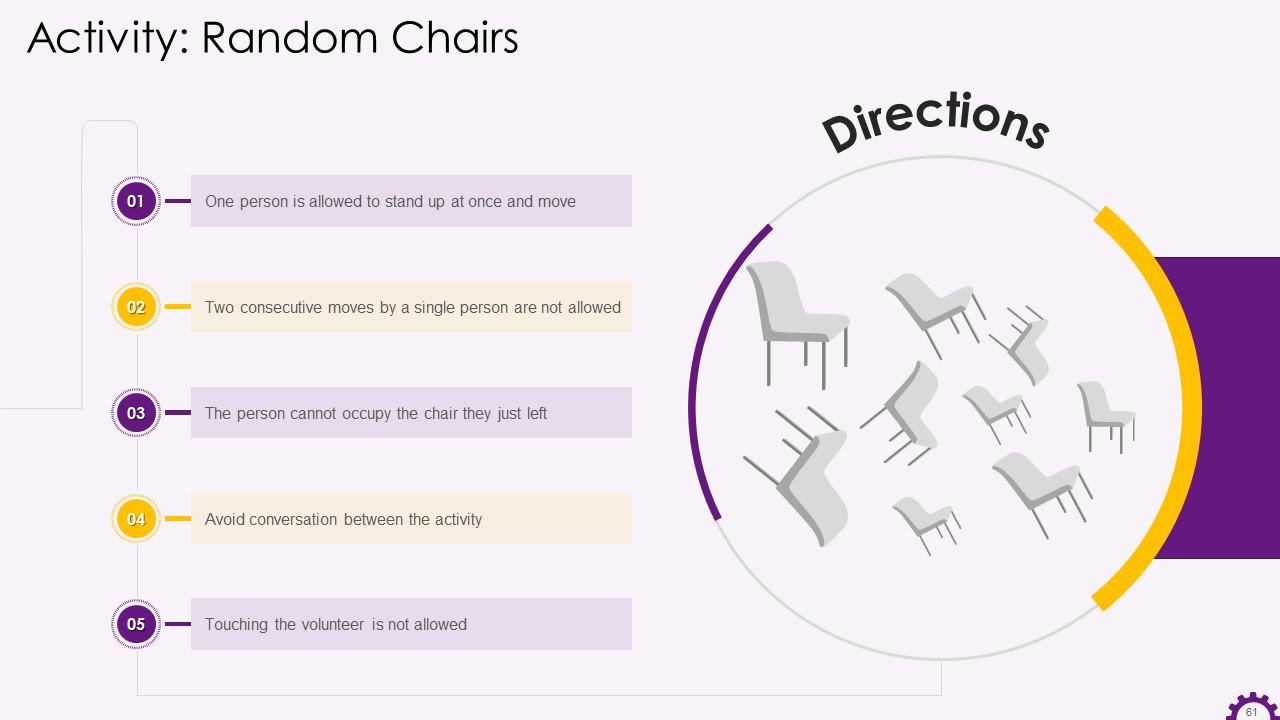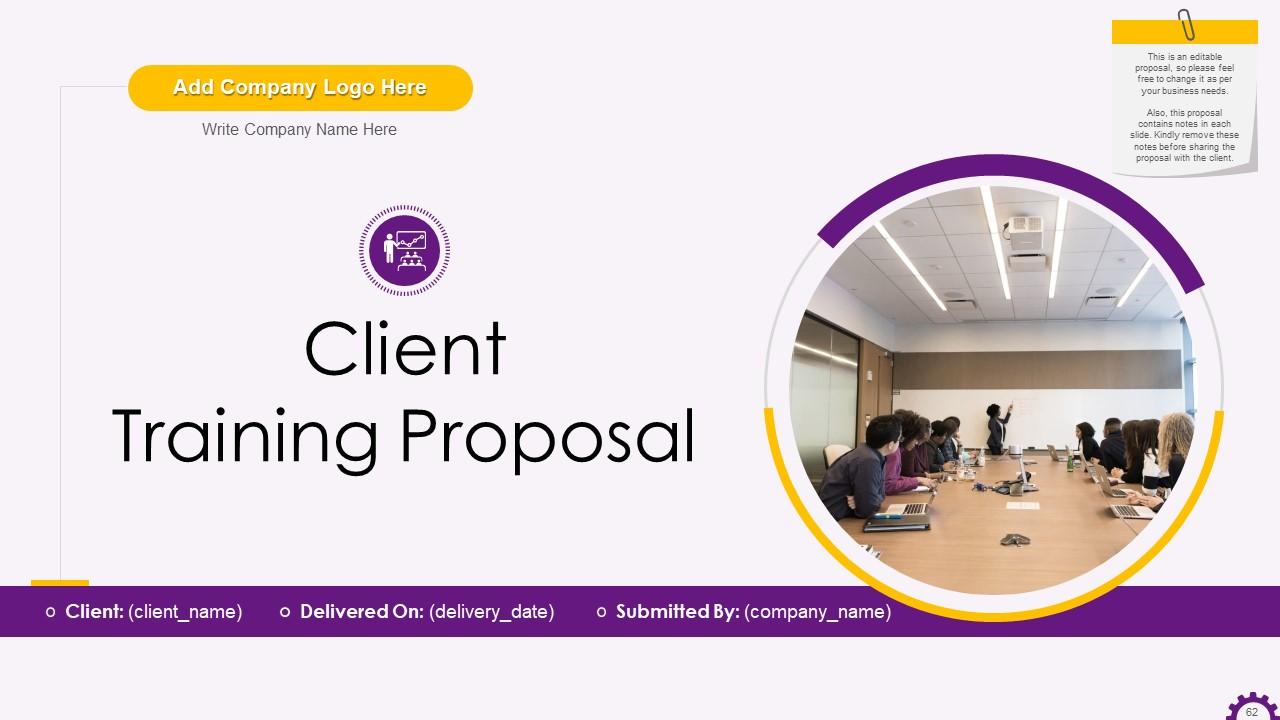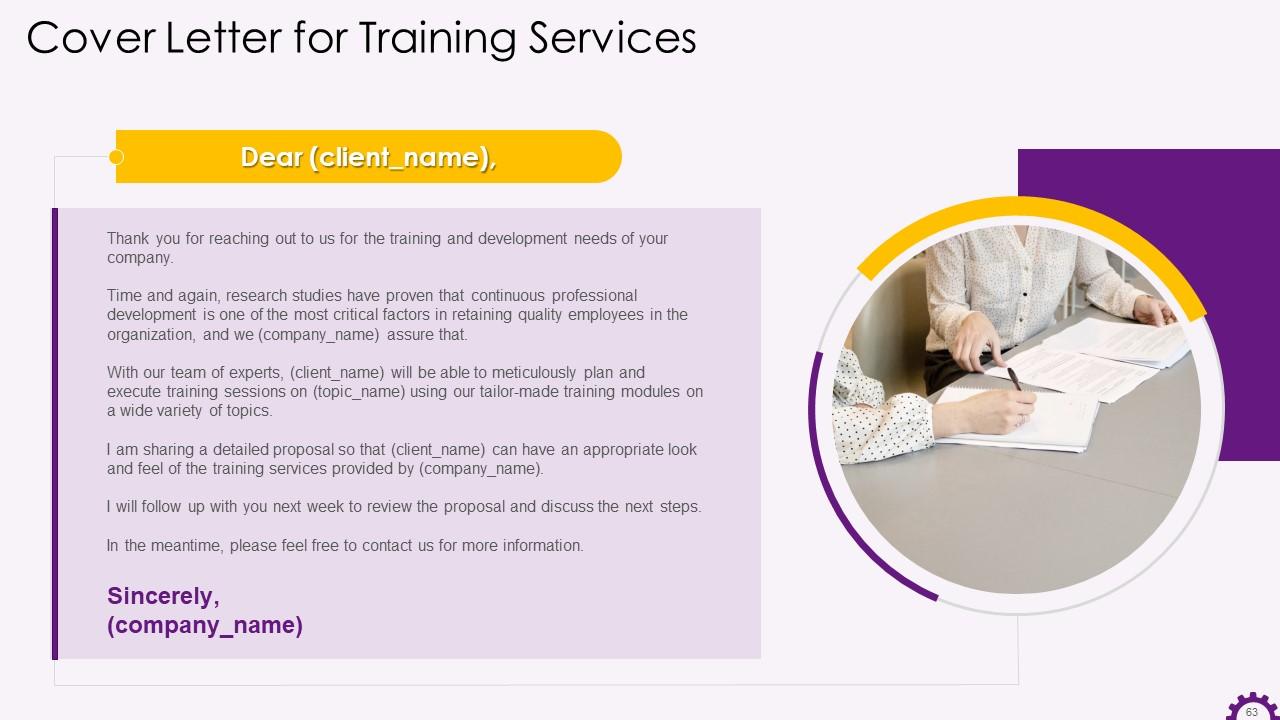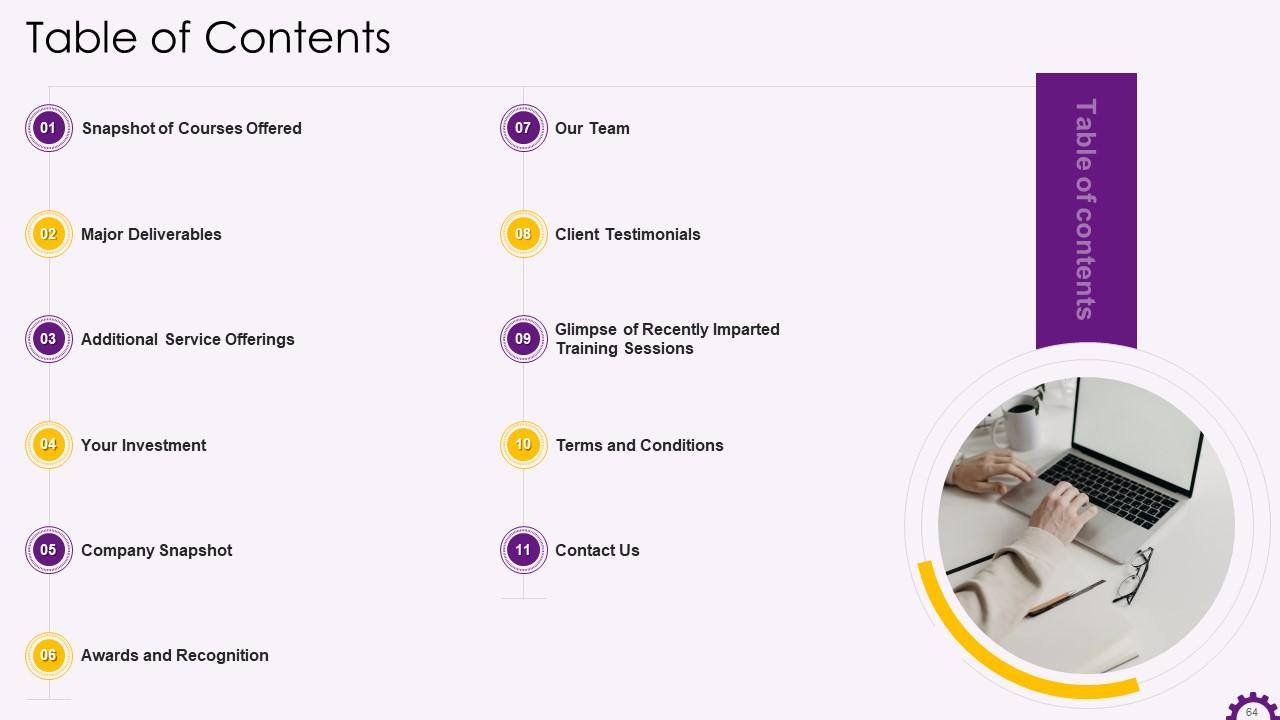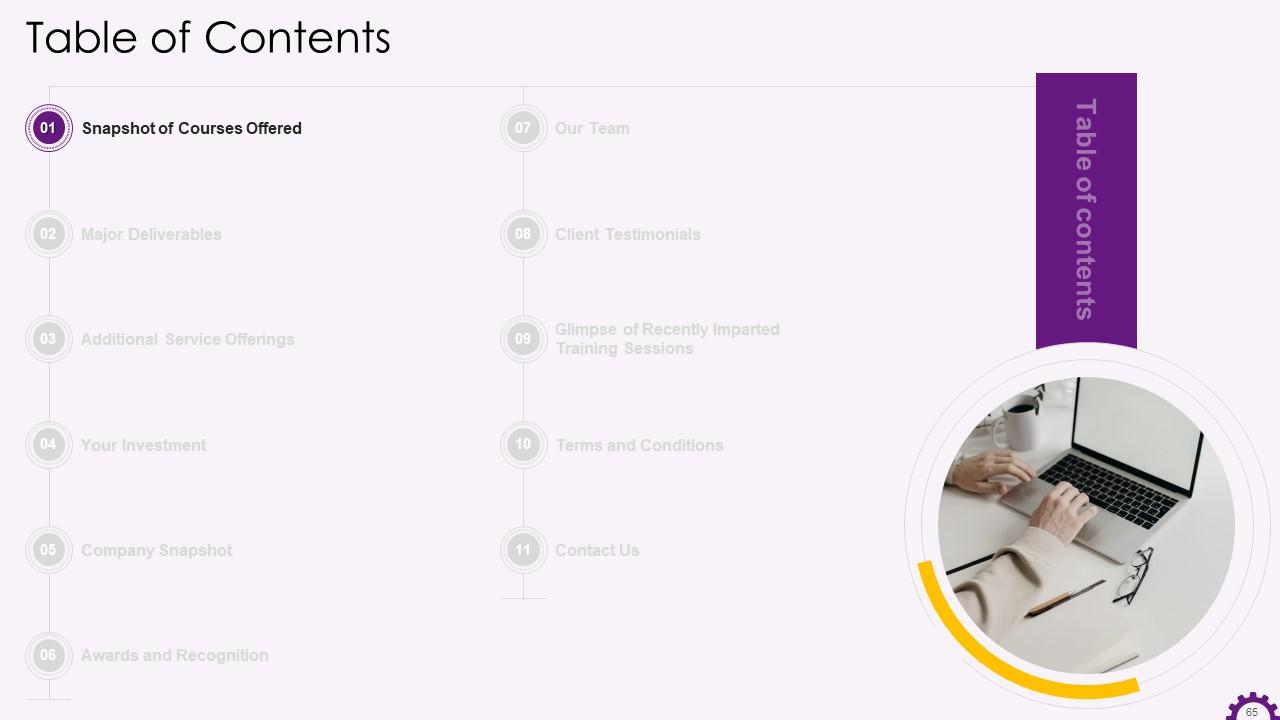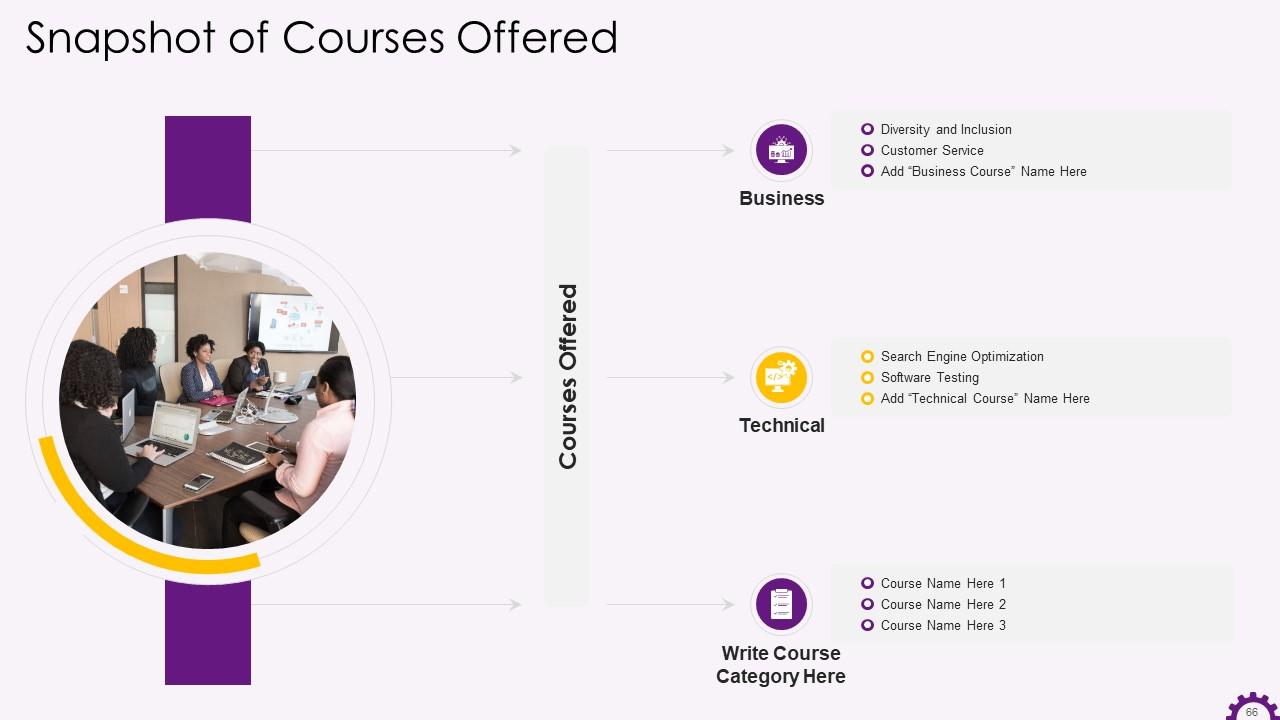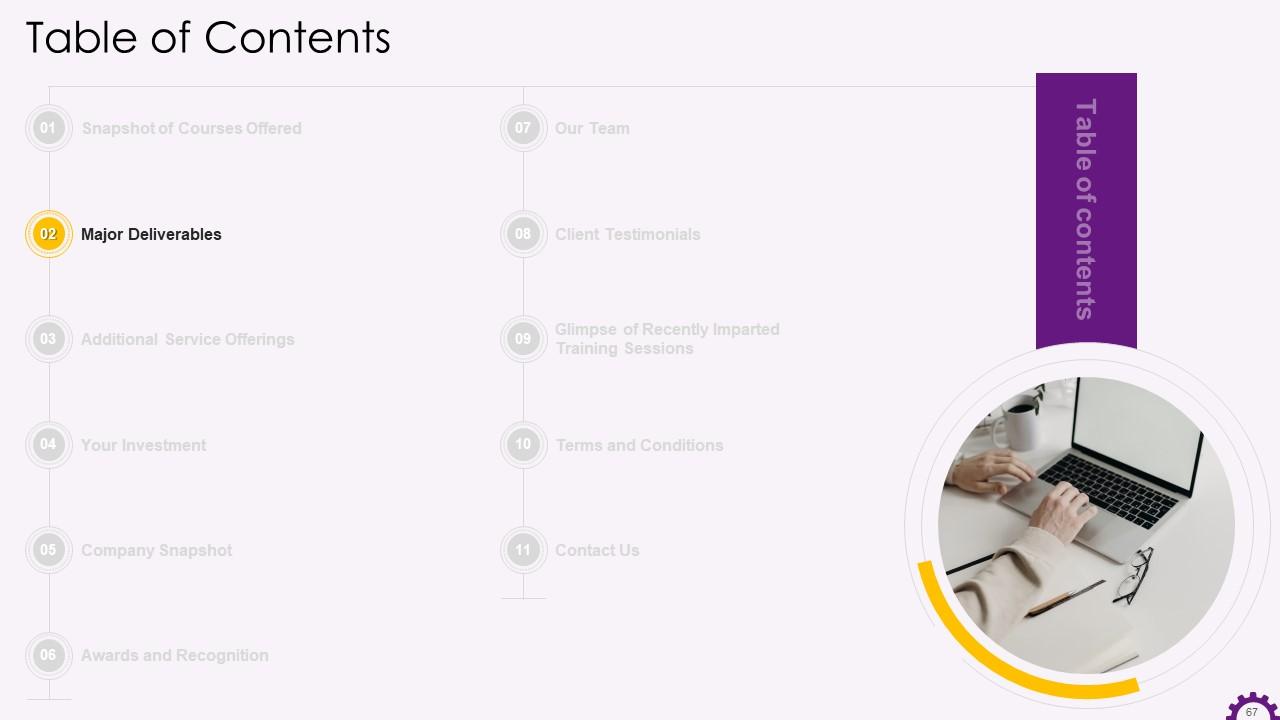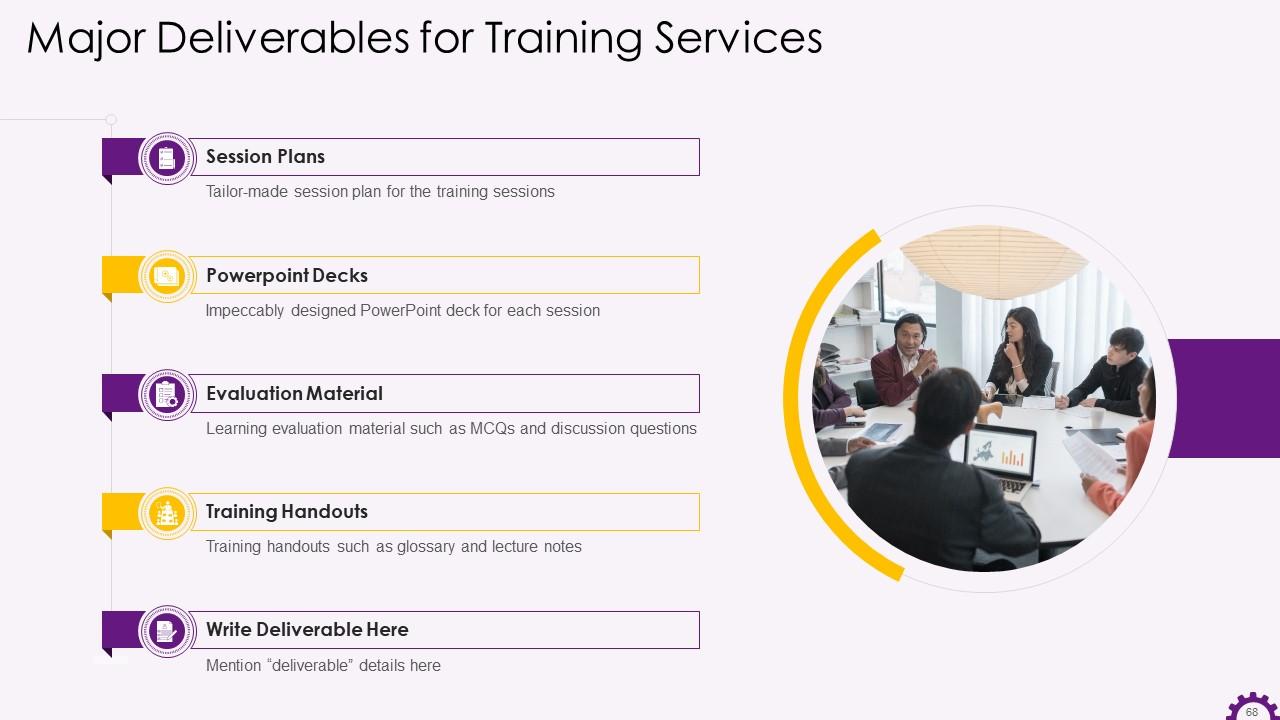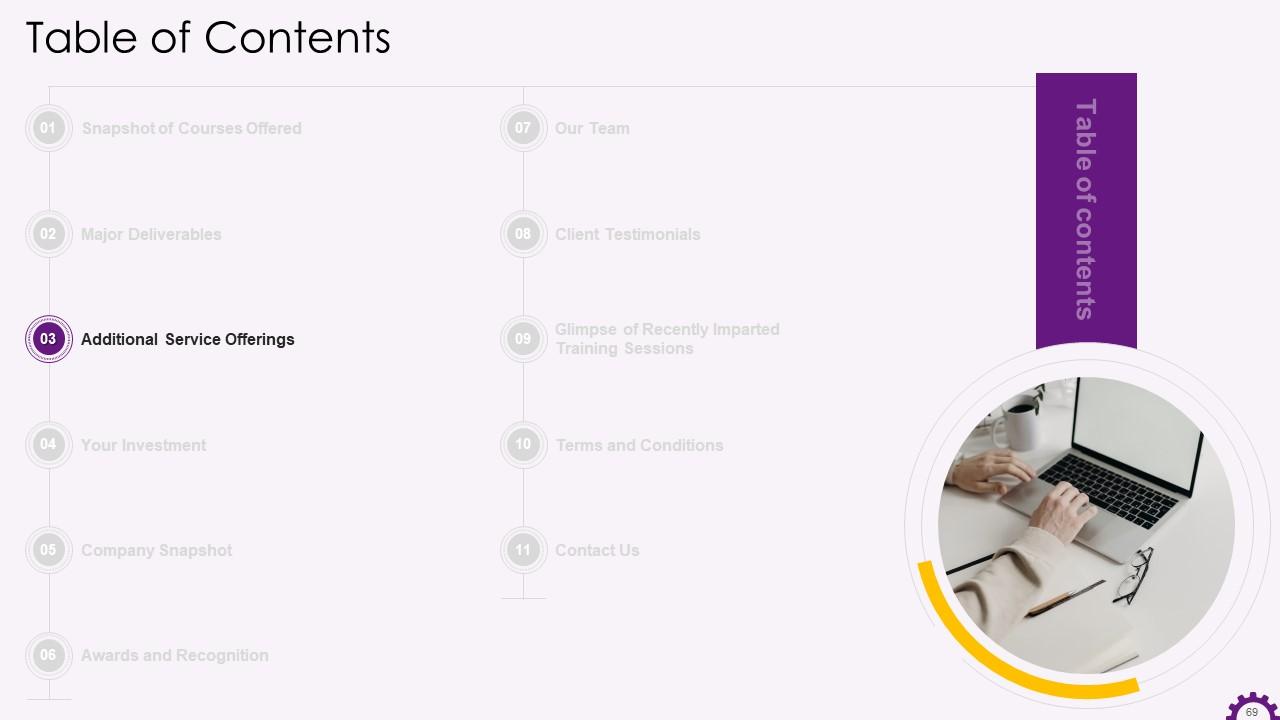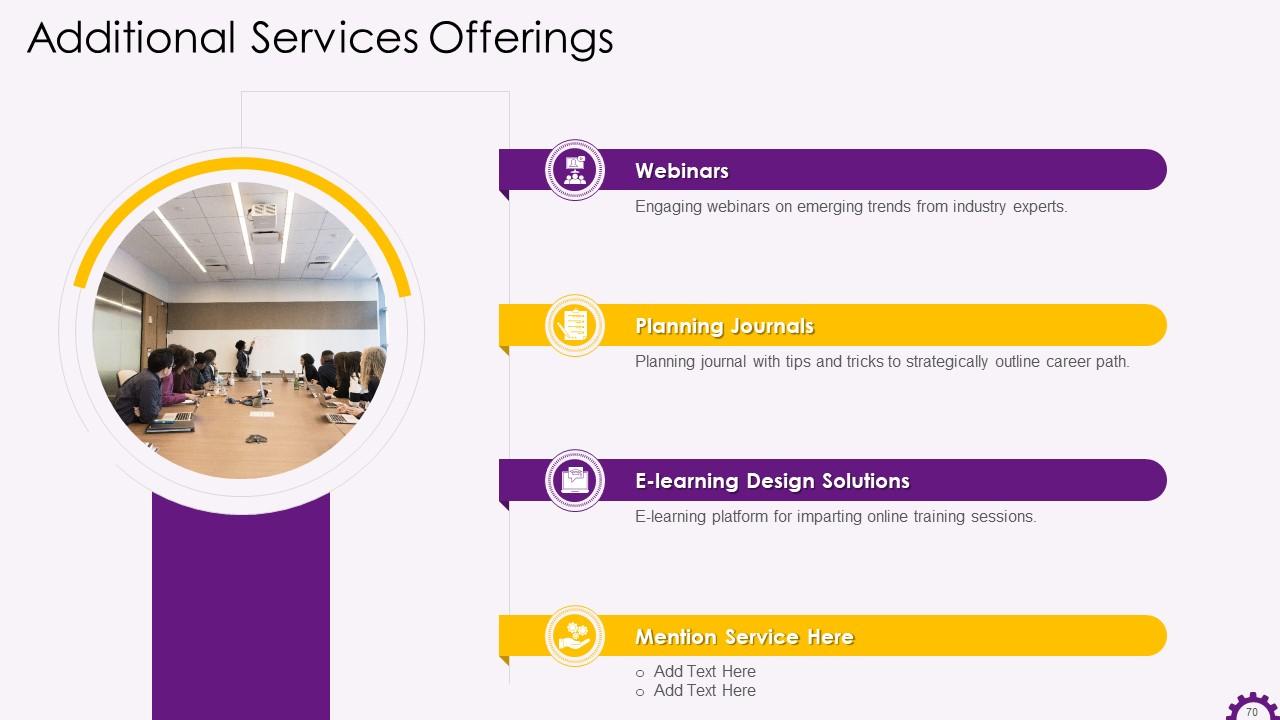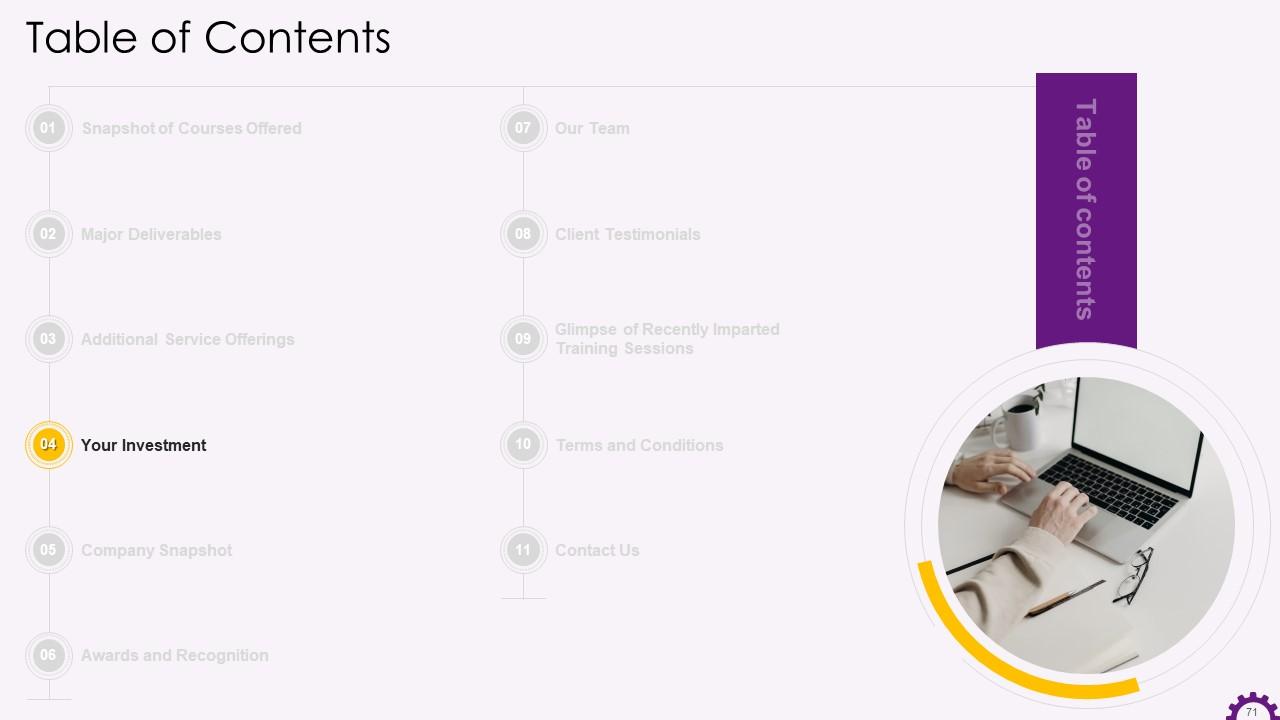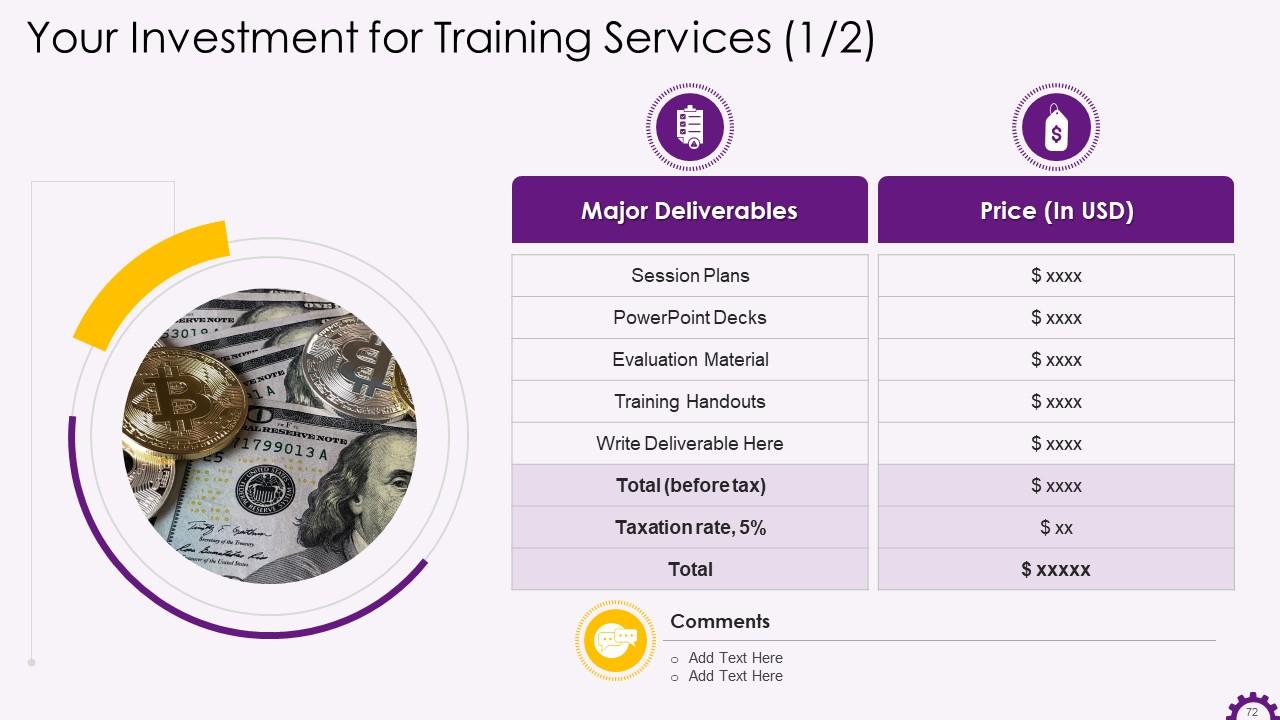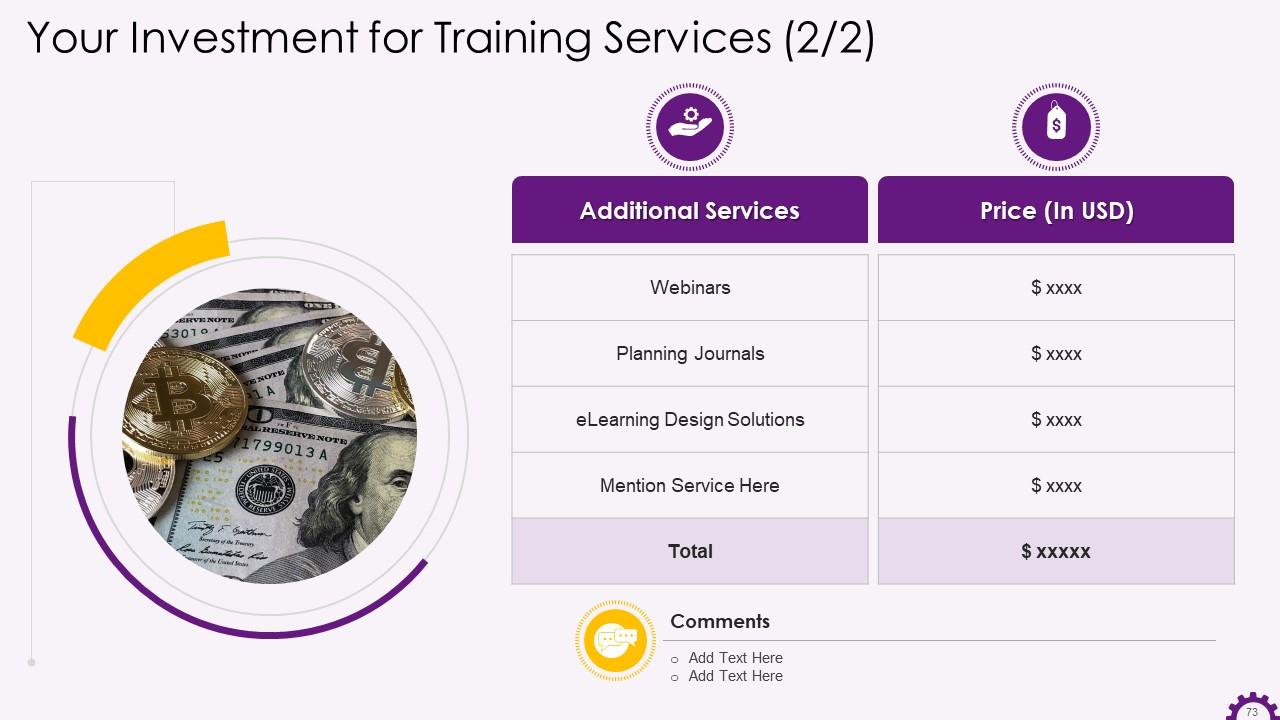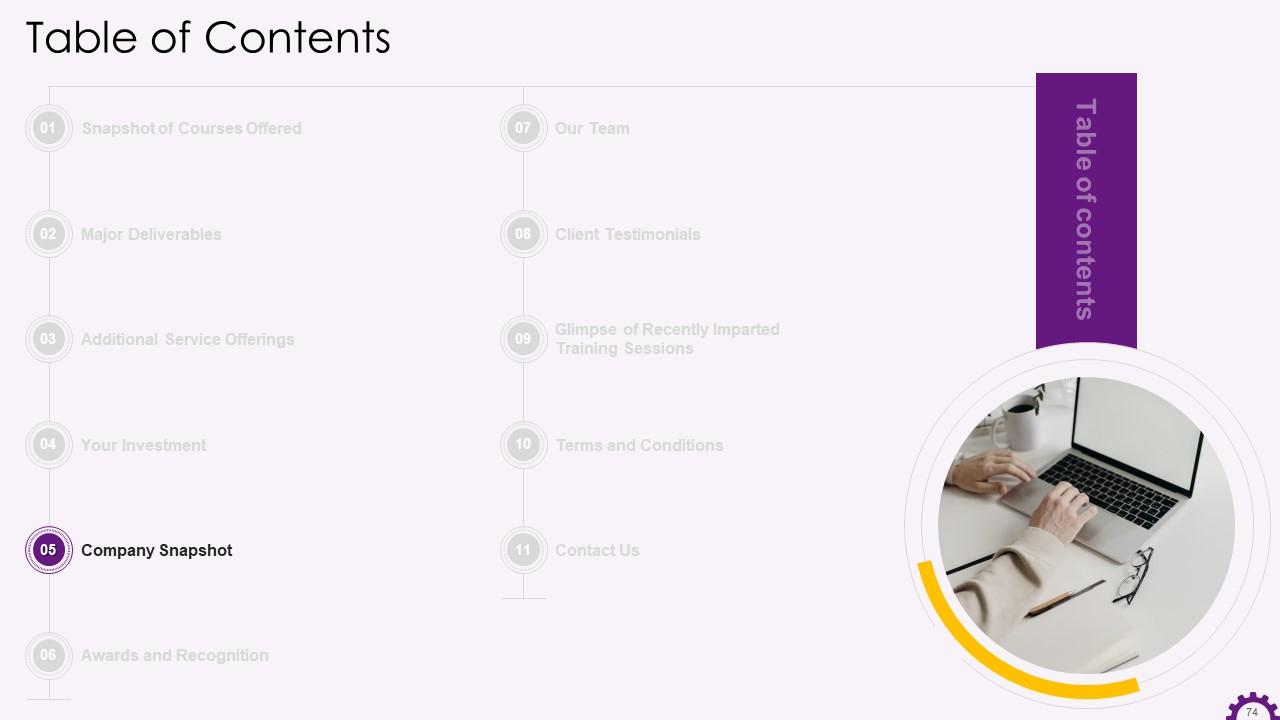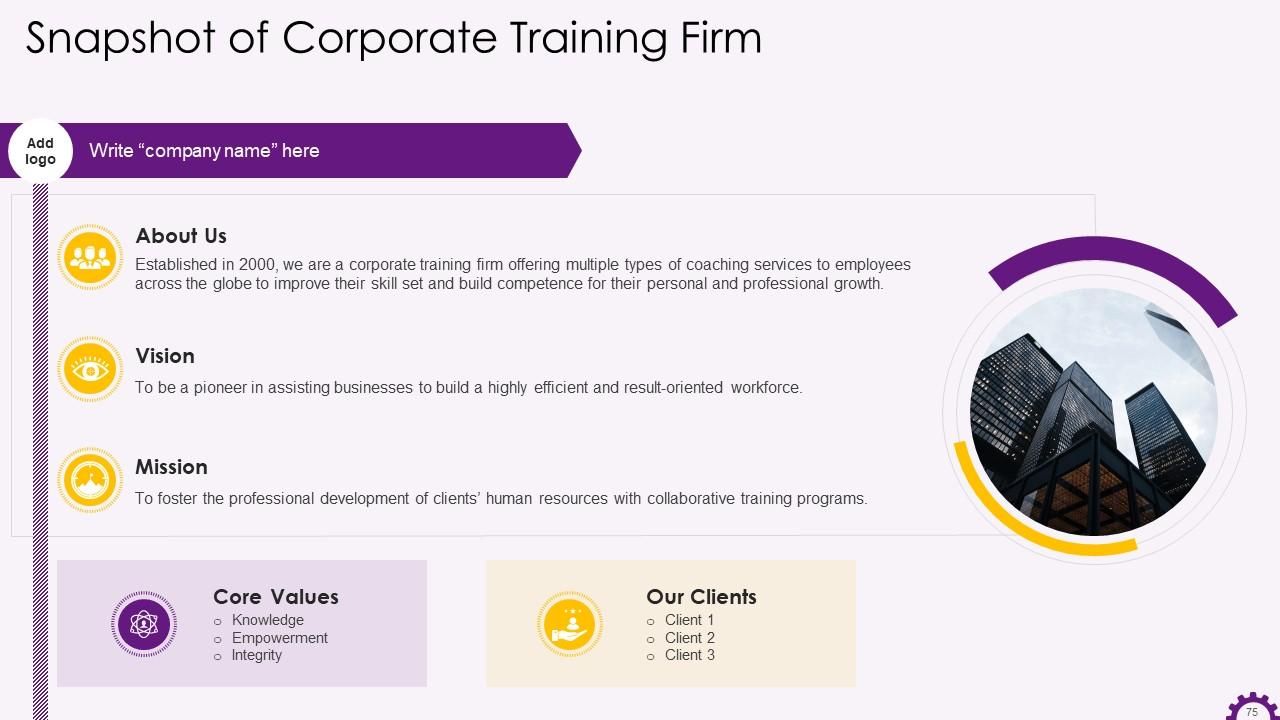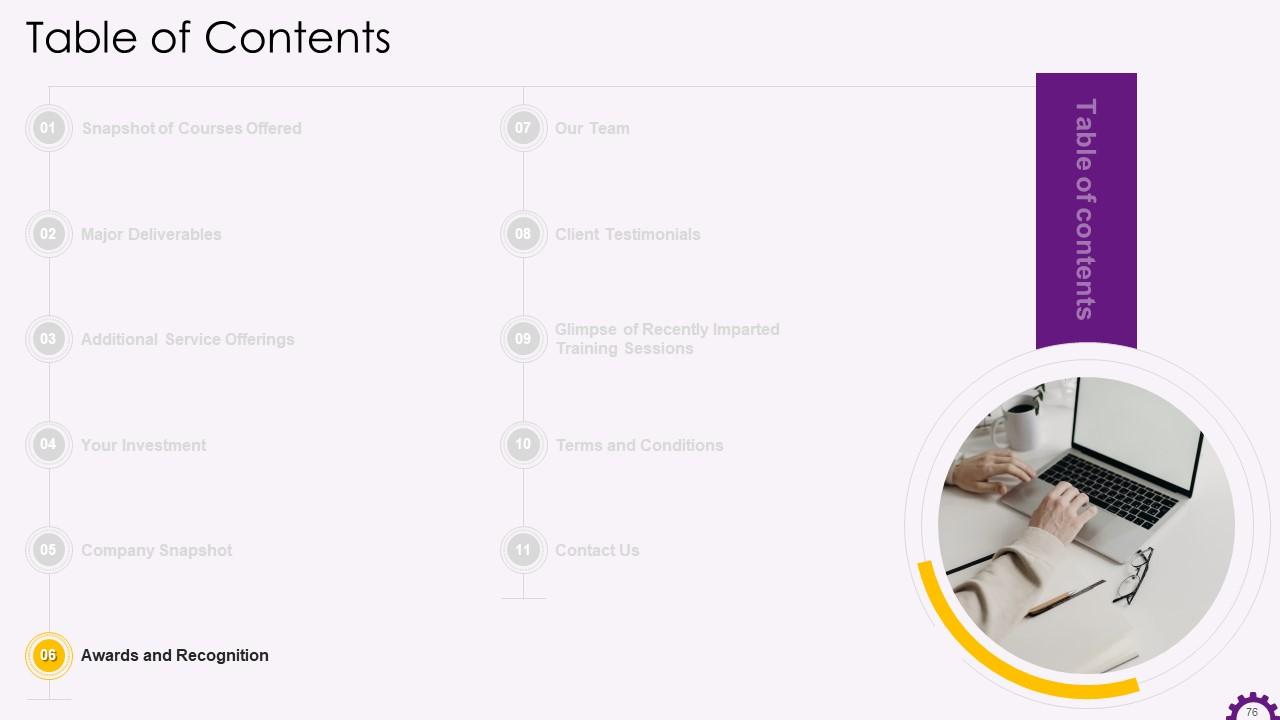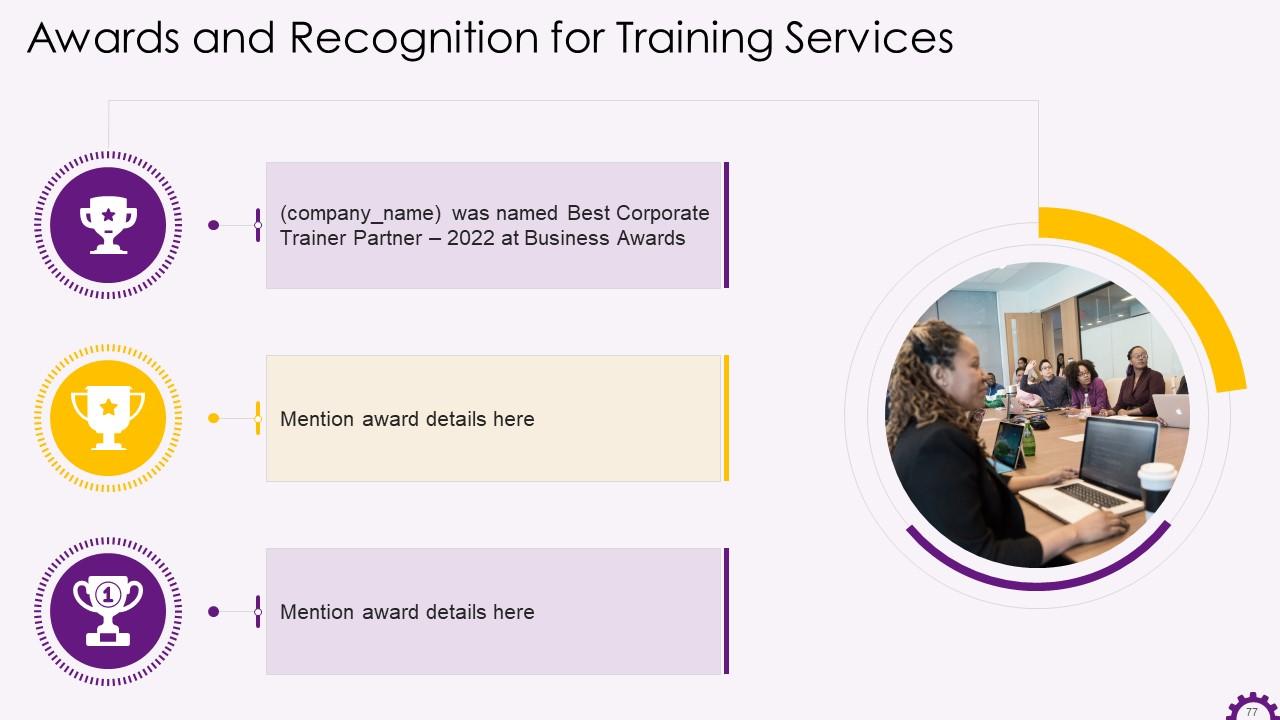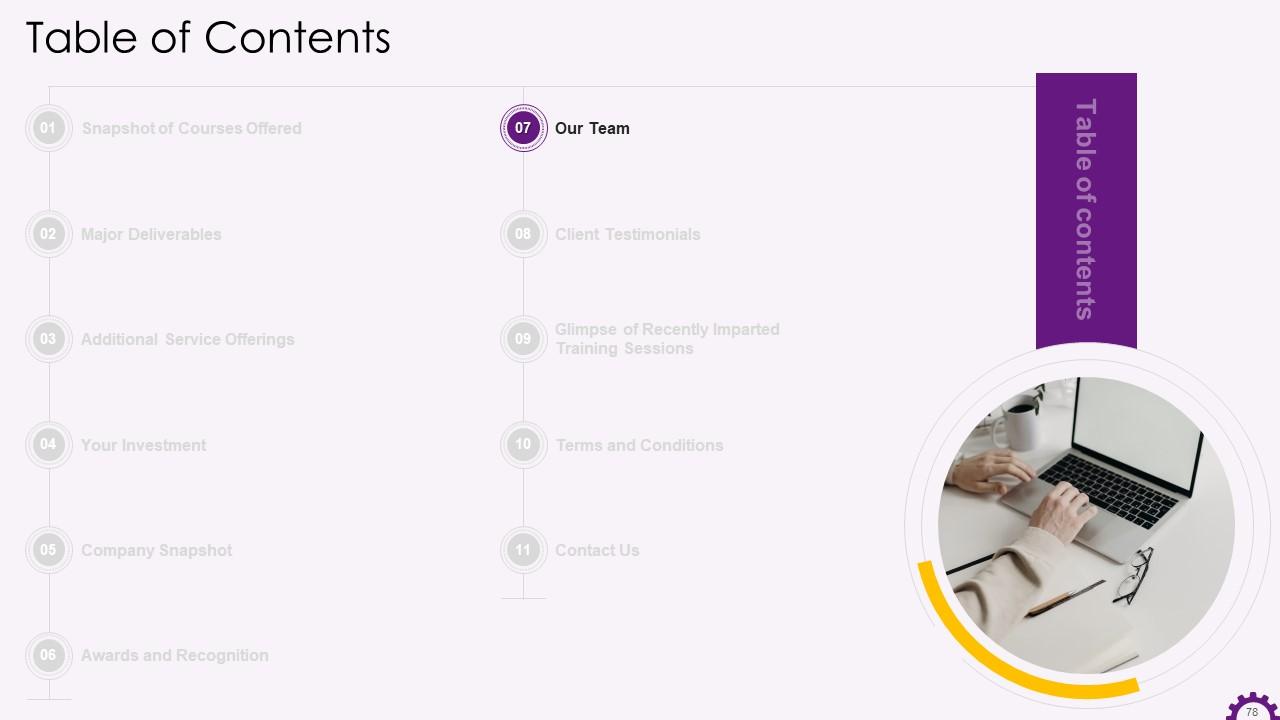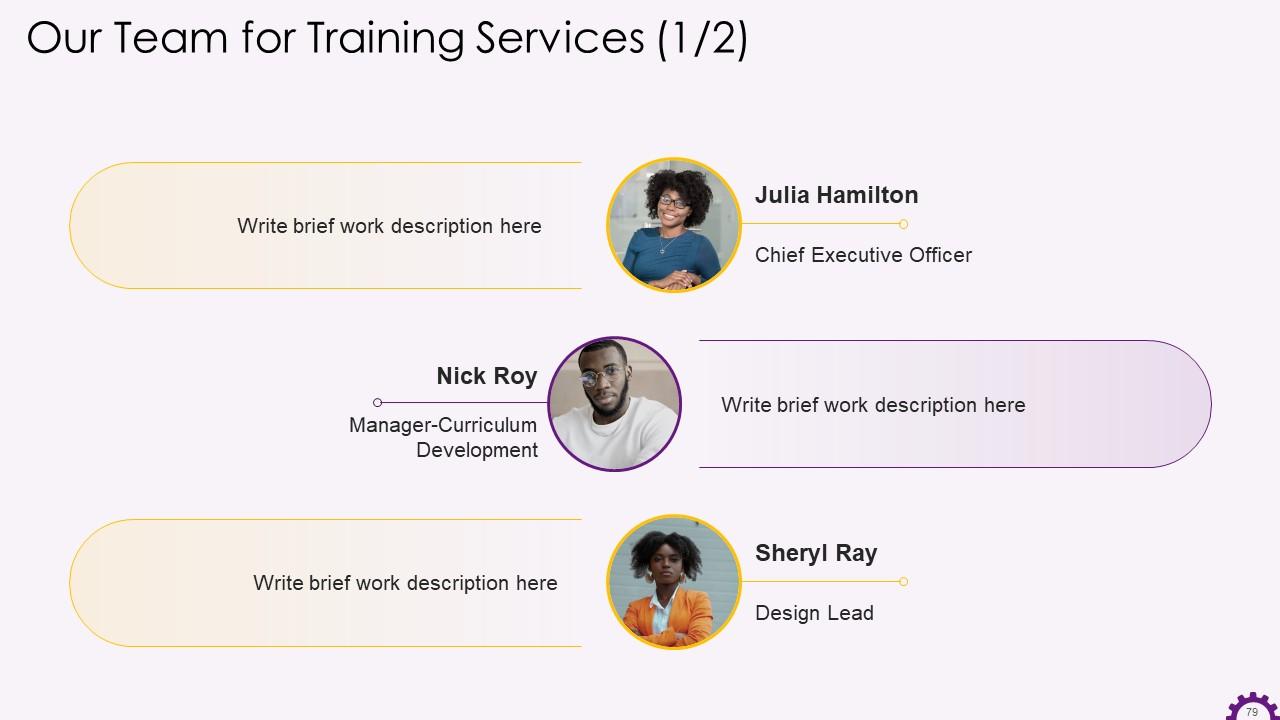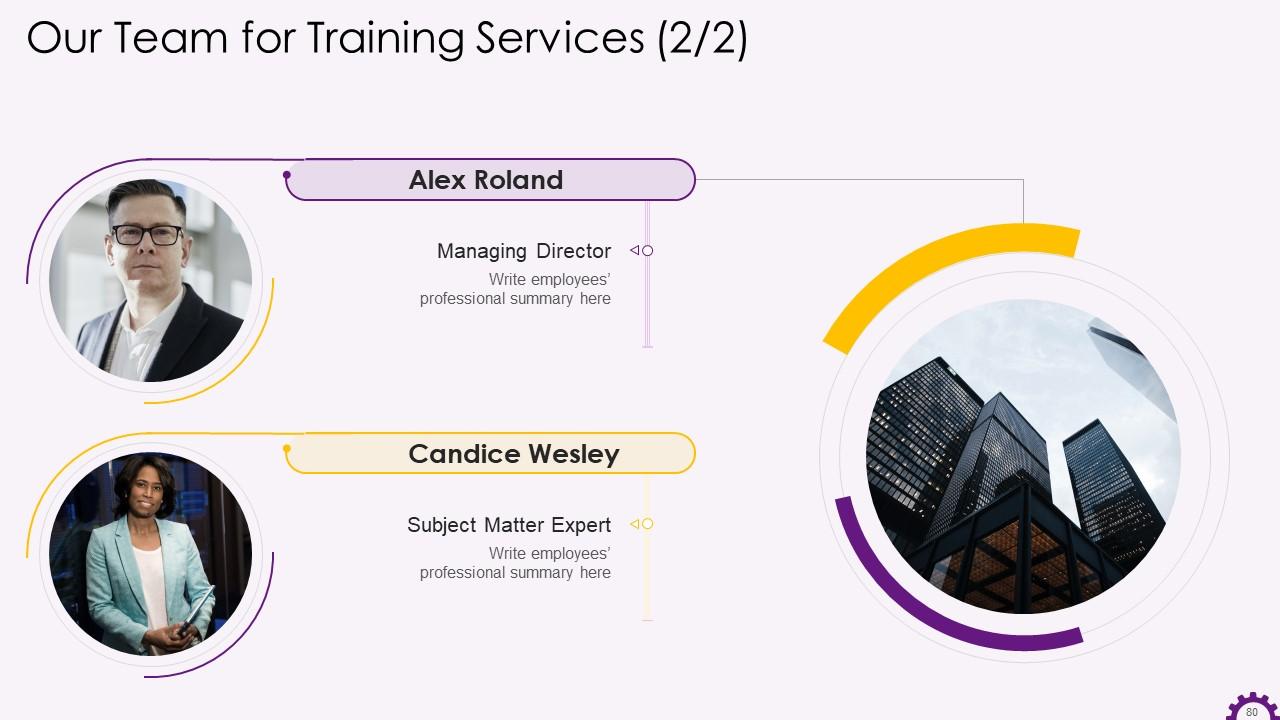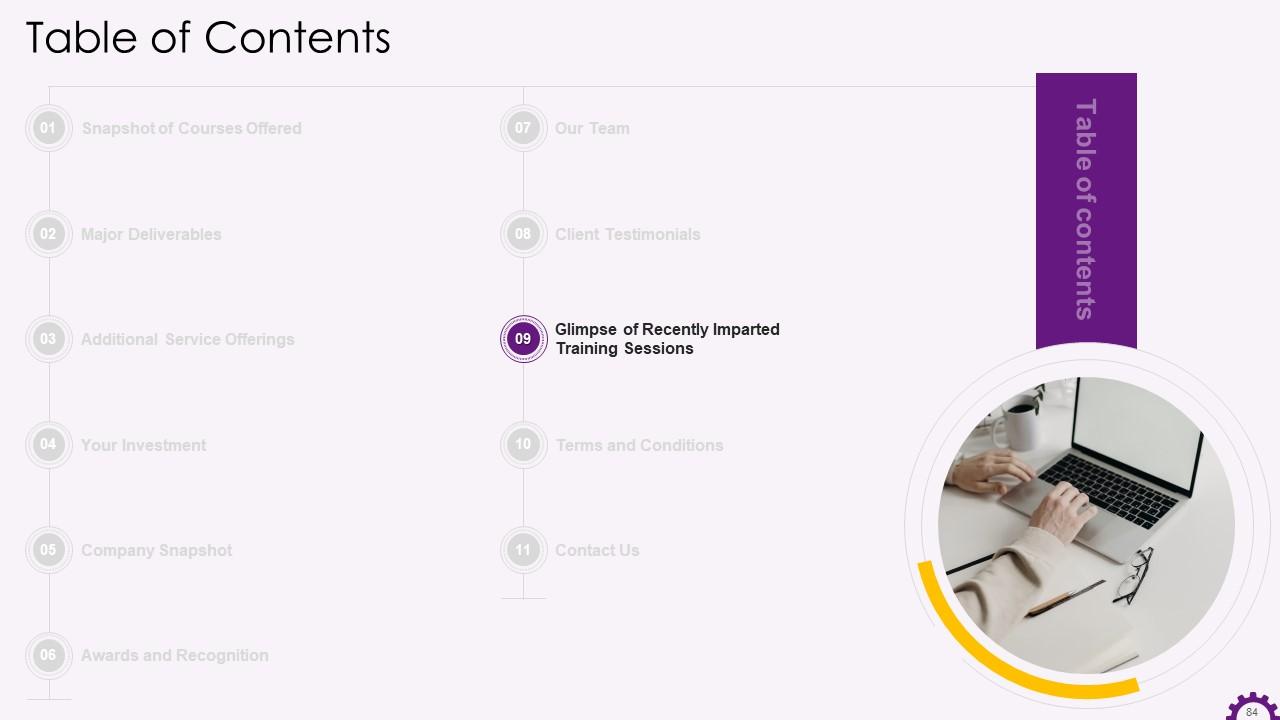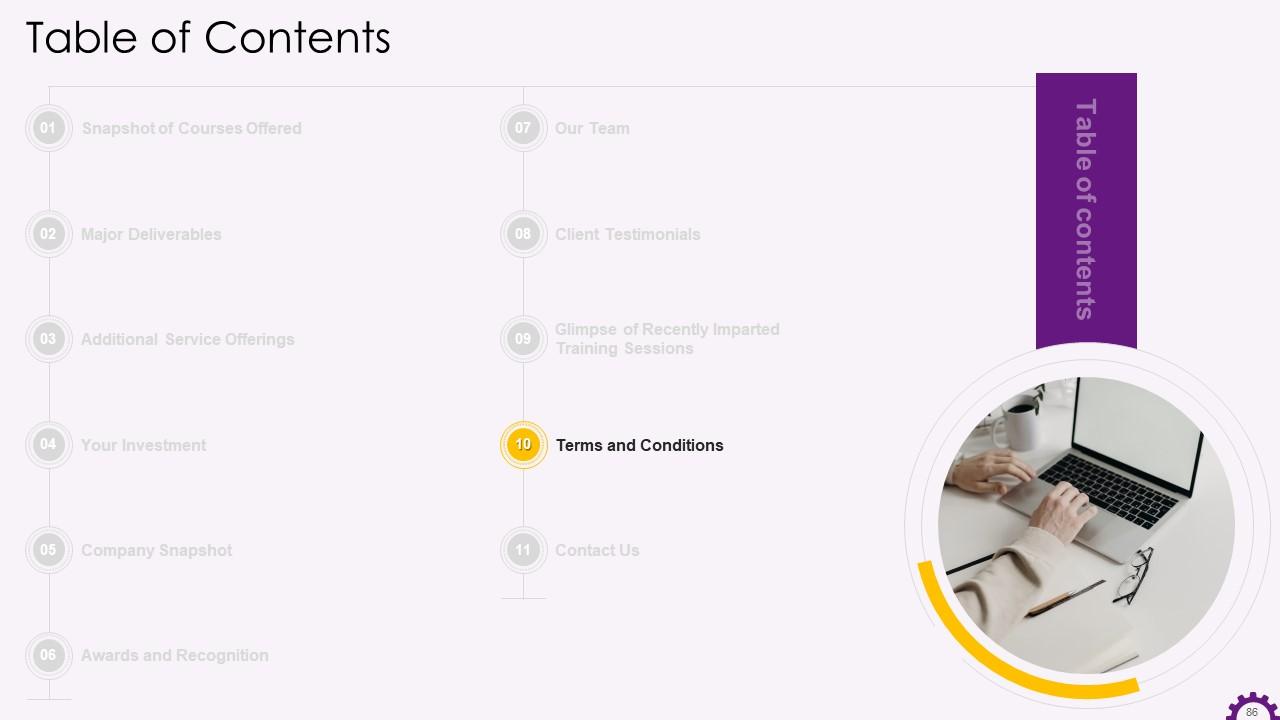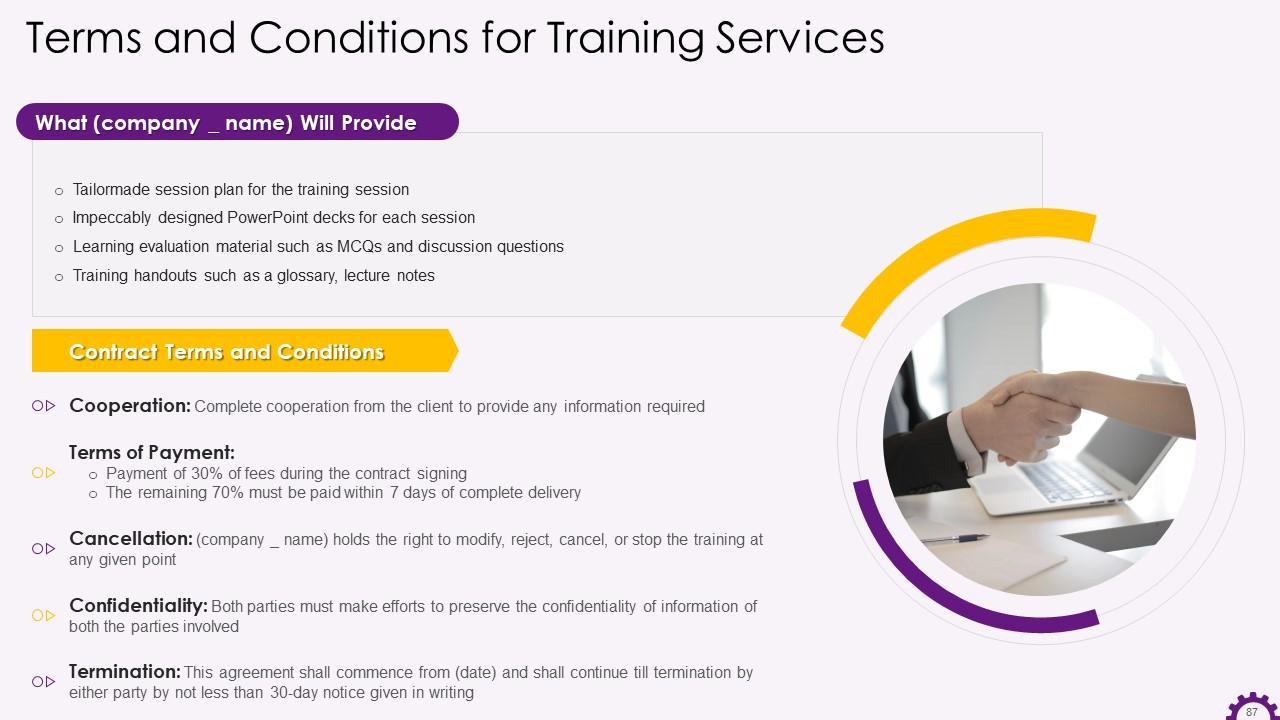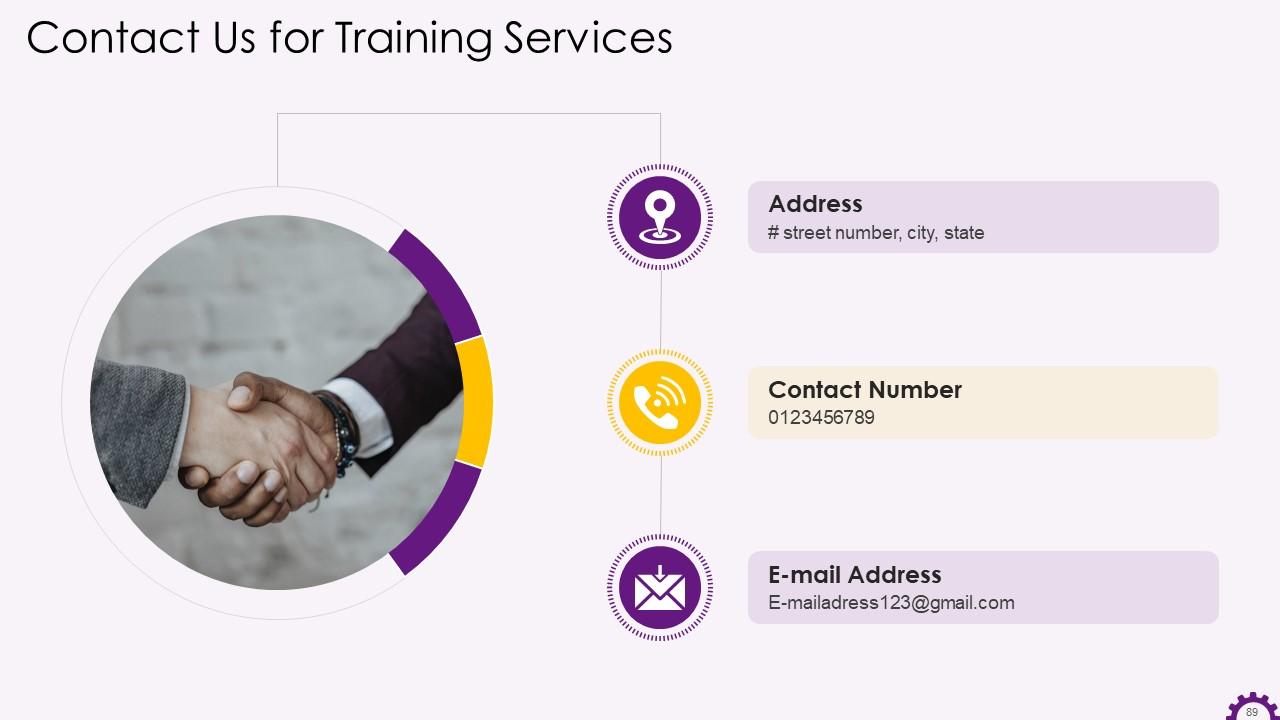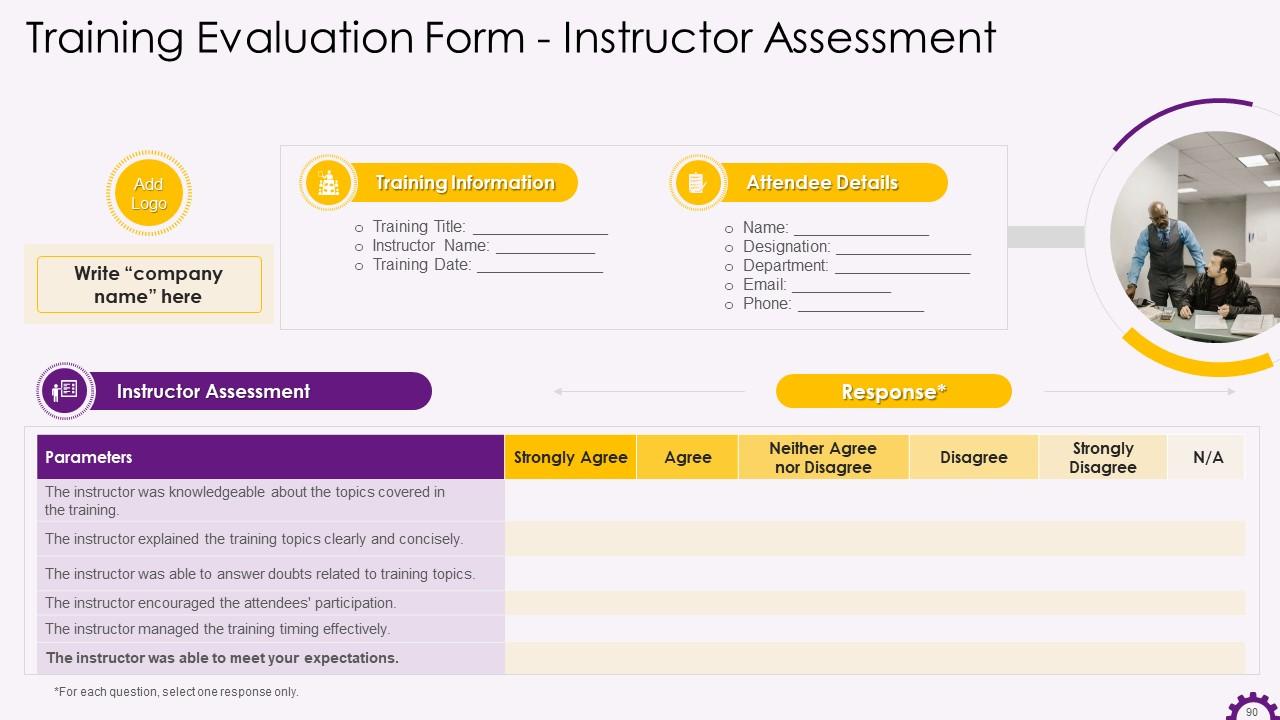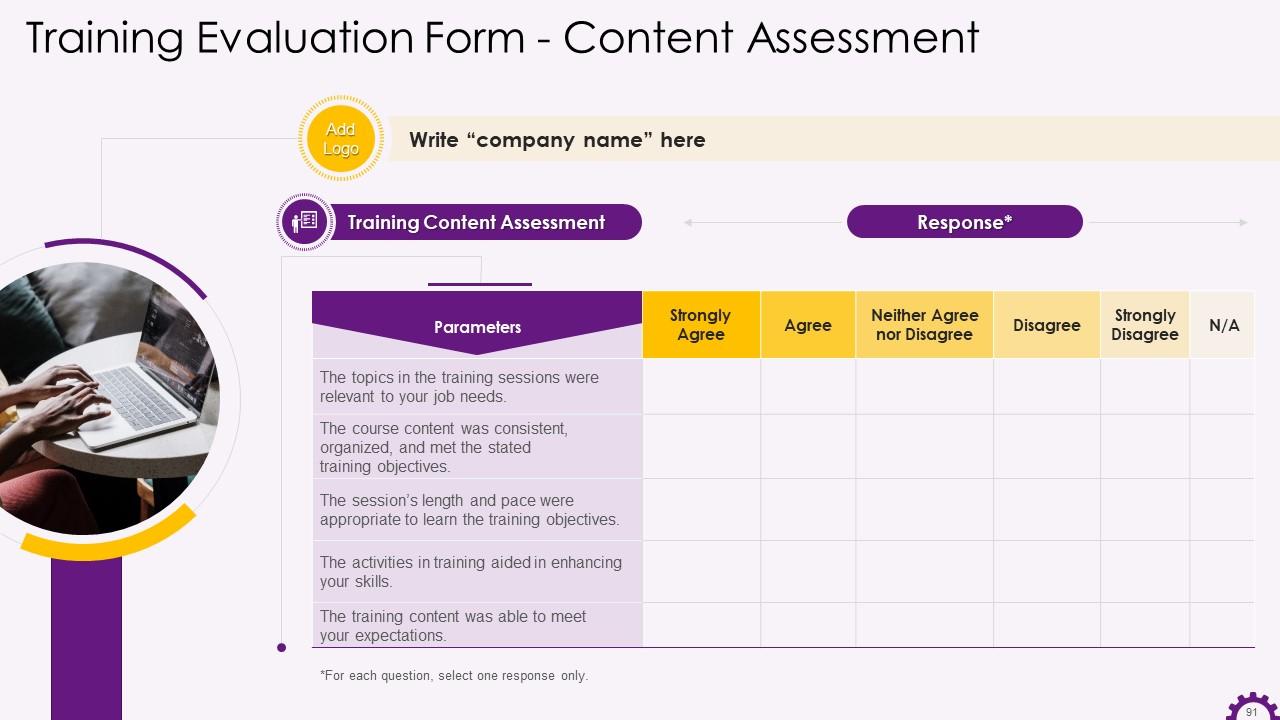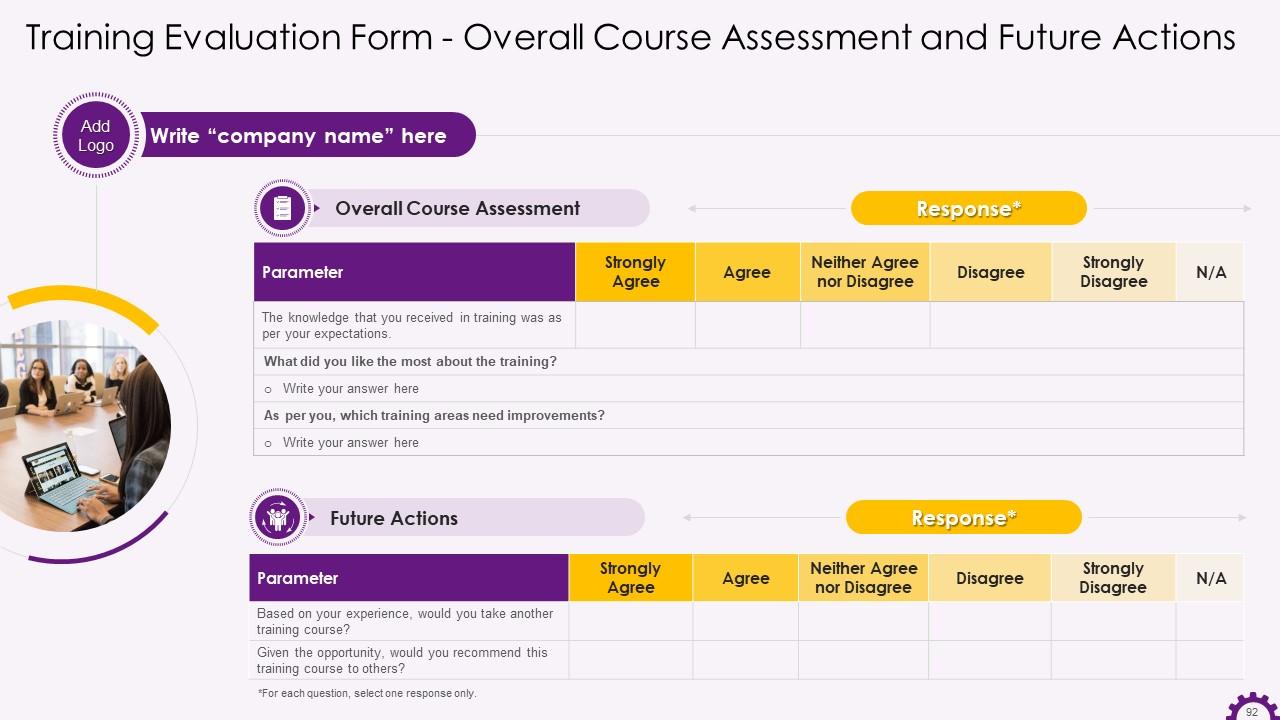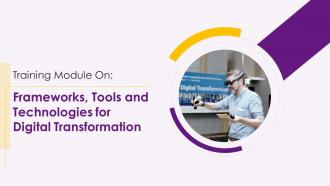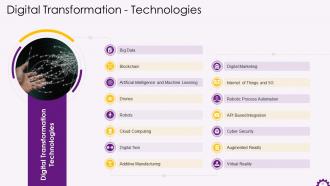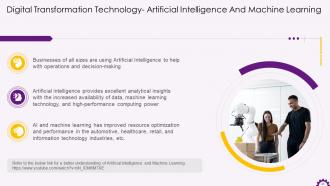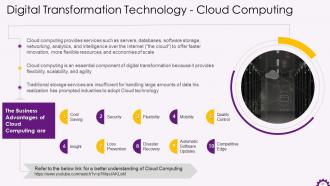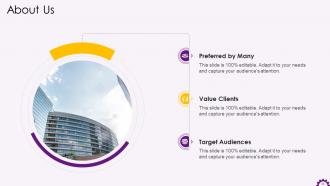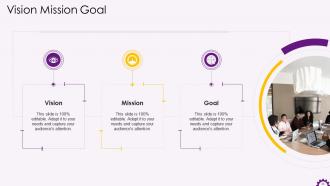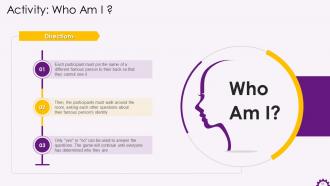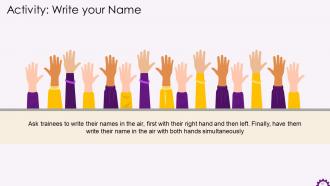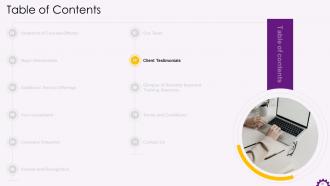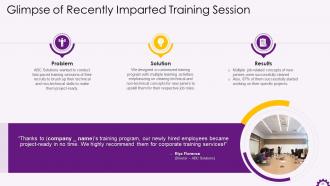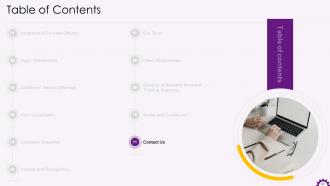Frameworks Tools and Technologies for Digital Transformation Training ppt
The PowerPoint training deck in-depth covers the digital transformation frameworks, tools, and technologies. It covers digital transformation frameworks McKinseys digital transformation, MITs digital transformation framework, AIMultiple digital transformation framework, Cognizants digital transformation framework, and Gartners digital transformation framework. The module has PPT slides on tools to use for the organizations digitalization customer success tool, workforce management and staff augmentation tool, IT asset management ITAM tool, and IT service management ITSM dashboard. Further, it covers the technologies associated with digital transformation, such as big data, augmented reality, virtual reality, artificial intelligence, machine learning, robotic process automation RPA, additive manufacturing, cloud technology, the internet of things IoT, blockchain, drones, and cybersecurity. The PPT deck also has key takeaways and discussion questions to make the training session interactive. Further, it also contains about us, vision, mission, goal, 30-60-90 days plan, timeline, roadmap, training completion certificate, energizer activities, client training proposal, and evaluation form.
The PowerPoint training deck in-depth covers the digital transformation frameworks, tools, and technologies. It covers digi..
- Google Slides is a new FREE Presentation software from Google.
- All our content is 100% compatible with Google Slides.
- Just download our designs, and upload them to Google Slides and they will work automatically.
- Amaze your audience with SlideTeam and Google Slides.
-
Want Changes to This PPT Slide? Check out our Presentation Design Services
- WideScreen Aspect ratio is becoming a very popular format. When you download this product, the downloaded ZIP will contain this product in both standard and widescreen format.
-

- Some older products that we have may only be in standard format, but they can easily be converted to widescreen.
- To do this, please open the SlideTeam product in Powerpoint, and go to
- Design ( On the top bar) -> Page Setup -> and select "On-screen Show (16:9)” in the drop down for "Slides Sized for".
- The slide or theme will change to widescreen, and all graphics will adjust automatically. You can similarly convert our content to any other desired screen aspect ratio.
Compatible With Google Slides

Get This In WideScreen
You must be logged in to download this presentation.
PowerPoint presentation slides
Presenting Training Deck on Frameworks, Tools and Technologies for Digital Transformation. This deck comprises of 92 slides. Each slide is well crafted and designed by our PowerPoint experts. This PPT presentation is thoroughly researched by the experts and every slide consists of an appropriate content. All slides are customizable. You can add or delete the content as per your need. Not just this, you can also make the required changes in the charts and graphs. Download this professionally designed business presentation, add your content and present it with confidence.
People who downloaded this PowerPoint presentation also viewed the following :
Content of this Powerpoint Presentation
Slide 4
This slide depicts the components of digital transformation. The components highlighted are customer focus, organizational structure, change management, transformational leadership, technology decisions, integration, internal customer experience, logistics and supply chain, data security, privacy and ethics, evolution of products, services and processes, digitization, and personalization.
Instructor’s Notes:
The components of digital transformation are:
- Customer Focus: The first shift transforms the company from a product-focused to a customer-focused mindset. Companies that are best prepared for and achieve the best results from digital transformations understand their customers and strongly understand their wants and needs
- Organizational Structure: A transparent culture that embraces change is required for digital transformation. Break down internal silos and rally executives and leaders behind the new digital vision
- Change Management: A lot of digital transformations fail due to a lack of employee support. People are hardwired to stay the same and often resist change, even when they see the potential benefits. The most effective change management efforts are in sync with today's fast-paced business environment
- Transformational Leadership: A lot of digital transformations fail due to a lack of employee support. People are hardwired to stay the same and often resist change, even when they see the potential benefits. The most effective change management efforts are in sync with today's fast-paced business environment
- Technology Decisions: Decisions about digital transformation cannot be made in a vacuum. Most purchase decisions involve an average of 15 people, half of whom are in IT. Leaders must collaborate to represent their respective departments and the company's overall goals
- Integration: Focusing on data aids in the integration of digital solutions across the organization. The larger the company, the more complex the approach to data. A streamlined data strategy is required for a successful digital transformation
- Internal Customer Experience: The internal customer experience (employee experience) is heavily influenced by digital transformation. Obtaining employee feedback and providing consumer-grade technology solutions greatly empowers employees to deliver an exceptional performance
- Logistics and Supply Chain: A digital transformation is ineffective unless it improves the speed and dependability with which customers receive their goods or services. A digital approach to logistics and supply chain management increases efficiency
- Data Security, Privacy and Ethics: The vast majority of consumers believe their personal information is vulnerable to a data breach. Data security should be prioritized while updating processes and systems as part of a digital transformation
- Evolution of Products, Services and Processes: Digital transformation necessitates a shift in how products and services are delivered and the products and services themselves. Modern products are smarter and more innovative in their delivery
- Digitization: Digitizing a business entails creating seamless integrations between digital and physical stores. Retailers such as Target and Best Buy have blurred the line between digital and retail with great success
- Personalization: Customers appreciates personalized service. Businesses must leverage digital solutions to understand their customers better and provide recommendations and experiences that are unique to them
Slide 5
This slide illustrates information about the digital transformation framework. It emphasizes that a digital transformation framework is a set of rules that an organization establishes to guide it through the transformation. It also states that digital transformation is a step-by-step change management strategy that simplifies the complex digital transformation process.
Slide 6
This slide showcases the McKinsey’s Digital Transformation Framework. It highlights that McKinsey created the 4Ds Digital Transformation framework i.e., discover, design, deliver, and de-risk. This framework prioritizes customer experience, which is unquestionably the way to go for a digital-first company.
Slide 7
This slide depicts the MIT Digital Transformation Framework. It highlights the five building blocks of Digital Transformation such as operational backbone, shared customer insights, digital platform, accountability framework, and external developer platform.
Slide 8
This slide illustrates the AIMultiple Digital Transformation Framework. The framework consists of the following parameters: Identify digital transformation objectives, formulate a digital transformation strategy, Establish competent technology leadership, etc.
Instructor’s Notes:
- Identify digital transformation objectives: The primary goals of digital transformation projects are to improve customer experience and profitability, either through enhanced pricing or operational efficiency. Different digital transformation objectives can be set or prioritized by an organization based on its industry, size, market share, etc
- Formulate a digital transformation strategy: After deciding on your digital transformation objectives, it's time to map out a strategy to achieve them. Digital transformation projects should aim for end-to-end transformation. There are three paths a company can choose to achieve digital transformation:
- Path 1: Create and integrate digital operations. Then, based on the new processes, improve the customer value proposition
- Path 2: Enhance the customer value proposition through digital content, insight, and engagement. Then, concentrate on integrating digital operations
- Path 3: Create a new set of capabilities based on the reimagined customer value proposition and operational model
- Decide on the necessary technologies: After deciding on a digital transformation strategy, an organization must determine which technologies will enable it to achieve its goals. The objectives of an organization influences technology selection. The following are some specific technologies that a company can use based on the strategic path they choose: RPA, digital twins, IoT, smart contracts, process mining, task mining, analytics, etc
- Establish a competent technology leadership: Even though 87 percent of businesses believe that going digital will disrupt their industry, they also admit that they lack the necessary leadership. Success in going digital transformation is dependent on both leadership and technological capabilities. Transformational leadership facilitates the adoption of digital culture
- Train employees and instil a digital culture across the organization: Digital culture is a work environment where every employee can communicate and discuss innovation with leaders. The leadership team encourages employees to take risks, and learn from failures. Experimentation, collaboration, employee involvement, and training are aspects of digital culture. While establishing a digital culture is complex and requires internal leadership, training is relatively simple, and businesses have access to partners and tools to help them
Slide 9
This slide depicts Cognizant’s Digital Transformation Framework. The components of the framework are digitizing customer experience, digitizing products & services, digitizing operations, and digitizing organization.
Instructor’s Notes:
- Digitizing Customer Experience: Companies collect customer data and provide personalized products to individuals to maximize customer satisfaction and lifetime revenue. Customers expect to get in touch with the company via all available channels 24 hours a day, seven days a week; Omni channel interaction and services are critical for successful digital transformation
- Digitizing Products & Services: Companies must focus on selling a journey to customers rather than a product. This is only possible if businesses embed a digital tag to analyze customer behavior and interact with customers
- Digitizing Operations: Organizations become more cost-effective and agile by automating operational processes. Agility is an essential characteristic for a firm. Staying competitive requires organizations to act faster than before.
- Digitizing Organization: Companies must develop a new organizational model that incorporates both humans and machines. Rather than operating processes, the labor force should be transferred to operations that involve designing, auditing, and innovating. Organizations need to foster innovation. This helps it take to new technologies that assist employees. Such technologies then enable employees to adopt to the digital world. The staff also gain the skills and the knowledge needed to transform
Slide 10
This slide illustrates the Gartner Digital Transformation Framework. The framework's steps are developing the right mindset and shared understanding. It also means having the right leaders in place, launching a digital business center of excellence, creating a digital strategy to address opportunities and threats, etc.
Slide 12
This slide showcases some tools used in digital transformation. Customer success tools, workforce management and staff augmentation tools, IT asset management tools, and IT Service Management tools are among them.
Slide 13
This slide depicts customer success as a digital transformation tool. It highlights that with the right customer success tool, an organization can handle all types of initiatives affecting the customer experience. With the right software, an organization can manage its customer relationships, resulting in increased levels of satisfaction, retention, and even referrals.
Slide 14
This slide depicts workforce management and staff augmentation as a tool for digital transformation. It emphasizes that an organization requires workforce management software regardless of how teams handle day-to-day operations. The tool directly aids the company in the management of labor resources while improving employee experience, which increases productivity and retention.
Slide 15
This slide showcases IT Asset Management as a Digital Transformation Tool. It mentions that IT Asset Management allows businesses to manage the entire lifecycle of IT assets such as hardware and software. It also includes the benefits of using an ITAM Tool, such as lowering technology costs by identifying redundancies in IT resources, mitigating the risks of security breaches and data mismanagement and modernizing existing technology stacks to increase efficiency, etc.
Slide 16
This slide depicts IT Service Management Dashboard as a Digital Transformation Tool. It emphasizes that in today's world, customers expect instant responses. To do this well, an organization's IT service management processes must be quick and efficient. It also mentions how a company can use automation to streamline IT workflows. AI-powered chatbots are included in some ITSM software to automate specific initiatives and keep the IT team running at peak efficiency.
Slide 17
This slide illustrates digital transformation technologies. The technologies are Big Data, Blockchain, Artificial Intelligence and Machine Learning, Drones, Robots, Cloud Computing, Digital Twin, Cybersecurity, API Based Integration, Robotic Process Automation, Digital Marketing, Internet of Things, Additive Manufacturing, Virtual Reality, and Augmented Reality.
Slide 18
This slide depicts information regarding big data analytics. It also highlights that it is feasible to process vast amounts of data using big data analytics to extract the right information for a specific business to help them model their strategies and make relevant decisions.
Slide 19
This slide illustrates information regarding Blockchain. It highlights that Blockchain stores data in blocks that are linked together using cryptography. It also highlights the applications of Blockchain such as Blockchain for Digital Transactions Management, supply chain, smart contracts, etc.
Slide 20
This slide depicts information regarding artificial intelligence and machine learning. It also illustrates that businesses of all sizes are using Artificial Intelligence to help with operations and decision-making. Both AI and machine learning have improved performance in the automotive, healthcare, retail, information technology industries, etc.
Slide 21
This slide mentions the significance and use cases of drone technology in digital transformation. It says that drones can deliver strategic and competitive advantages along with efficiency gains. Drone technology, when combined with analytics and a computing platform, integrates digital solutions to harness the power of SMAC (social, mobile, analytics and cloud). The possible use cases of drone technology are delivery of medicines, aerial photography, gathering of information, rescue operations, mapping of inaccessible terrain, etc.
Slide 22
This slide mentions the significance and use cases of robotic technology in digital transformation. It says that Robots help boost productivity, improve safety, and ensure time saving. Robots can produce incredibly accurate, consistent, and high-quality results without the need for breaks or holidays. The use cases of robotics technology are order processing, surgeries, inventory management, manufacturing, etc.
Slide 23
This slide showcases information on cloud technology. It also depicts that Cloud computing provides servers, databases, software storage, networking, analytics, and intelligence over the Internet ("the cloud") to offer faster innovation, more flexible resources, and economies of scale. The slide also contains the business advantages of cloud computing such as cost-saving, security, flexibility, mobility, quality control, insight, loss prevention, disaster recovery, automatic software updates, competitive edge, etc.
Slide 24
This slide illustrates the information regarding the digital twin. It also highlights that the digital twin is a digital transformation technology connecting the physical and digital worlds. Digital twins are also being used in healthcare to improve diagnosis and are also used to optimize manufacturing in the automotive industry.
Slide 25
This slide depicts the information regarding additive manufacturing. It illustrates that additive manufacturing or 3D printing is the process of creating a three-dimensional object from a computer-aided design (CAD) model by piling consecutive layers of material on top of each other. It also aids in accelerating traditional manufacturing methods, improving operational efficiency, and reducing operating costs.
Slide 26
This slide illustrates information regarding virtual reality. It also highlights that virtual reality is being used in several ways by the business community, including virtual tours of a business environment, training of new employees, and a 360-degree view of a product.
Slide 27
This slide showcases the information regarding augmented reality. It also contains the use cases for augmented reality such as remote expert assistance, learning and development (L&D), complex manufacturing, increased productivity, and believe it when you see it.
Instructor’s Notes:
The use cases for augmented reality (AR) are:
- Remote Expert Assistance: AR enables experts to be in more than one place simultaneously. If a field technician in a remote location becomes stuck while troubleshooting some equipment, they can use an enterprise AR solution to connect with the subject-matter expert (SME). The SME could be at the home, office, or even on the other side of the world. This not only allows the expert to see what the technician is looking at, but it also allows them to provide instructions directly on top of the target. For Example: Instead of saying which screw to remove, they could draw a circle on top of it
- Learning and Development (L&D): AR enables organizations to train employees from any location. It allows operators to gain hands-on experience with patients, machinery, and equipment in a risk-free environment.
- Complex Manufacturing: Manufacturing is already being transformed by augmented reality. It is one of the most important technologies for Industry 4.0. On the factory floor, operators and engineers use augmented reality glasses to aid in troubleshooting, manage configurations reliably, and build complex machinery. For Example: Boeing's AR program, which overlays digital 3D wiring diagrams on KC-46 tankers and 767 freighters to speed up manufacturing and ensure accuracy
- Increased Productivity: Productivity gains extend far beyond the manufacturing industry. One important application of AR is customer experience. For Example: AR significantly improves the effectiveness of a helpdesk. Customer service representatives can see what the customer sees, also known as see-what-I-see (SWIS). They can analyze the problem with their eyes and use the digital overlay to guide the customer through the repair/installation process. This increases productivity by reducing call durations
- Believe it When You See it: Seeing something with one's own eyes has extraordinary power. AR allows seeing prototypes in a less expensive, more straightforward, and more accessible manner. Augmented reality applications give marketing teams a valuable new tool to add to their toolbox. Whether in a B2B or B2C context, showing a customer a product that they can visualize or interact with is a significant advantage
Slide 28
This slide mentions the significance and use cases of cybersecurity in digital transformation. It says that cybersecurity ensures confidentiality, integrity, and availability of data. Organizations should implement a holistic cyber security policy across all relevant platforms.
Slide 29
This slide depicts the data for API-based Integration. It also states that an Application Programming Interface (API) is a messaging system that handles requests and ensures that enterprise systems run smoothly. API-based integration is a critical digital transformation technology for companies preparing for a connected future.
Slide 30
This slide demonstrates the information on Robotic Process Automation (RPA). It also depicts that RPA is a software technology that can be used to automate digital tasks. The value that RPA can generate when combined with other digital transformation technologies such as AI (Artificial Intelligence) and ML (Machine Learning) is incomparable.
Slide 31
This slide illustrates the information regarding the Internet Of Things and 5G. It also demonstrates that IoT and 5G are two game-changing digital transformation technologies that promise to improve efficiency across multiple industries. IoT devices require more bandwidth, faster transmission capabilities, and seamless connectivity, which 5G integration can provide.
Slide 32
This slide showcases the information regarding digital marketing. It also highlights that Digital transformation implies making the business digital. All the services go digital and make use of new technologies and devices. It also mentions that digital marketing is considered to be a part of the transformation. Traditional marketing methods such as pamphlets, for example, are being phased out, and marketing services are being pushed online
Slide 33
This slide illustrates the key takeaways for the session frameworks, tools and technologies for digital transformation.
Slide 34
This slide mentions various questions for discussion on the topic frameworks, tools and technologies for digital transformation.
Slide 46 to 61
These slides contain energizer activities to engage the audience of the training session.
Slide 62 to 89
These slides contain a training proposal covering what the company providing corporate training can accomplish for the client.
Slide 90 to 92
These slides include a training evaluation form for instructor, content and course assessment.
Frameworks Tools and Technologies for Digital Transformation Training ppt with all 97 slides:
Use our Frameworks Tools and Technologies for Digital Transformation Training ppt to effectively help you save your valuable time. They are readymade to fit into any presentation structure.
-
SlideTeam just saved my project! Thank you so much. The variety of templates helped me showcase multiple perspectives easily.
-
Helpful product design for delivering presentation.



